- Czech Republic
- United Kingdom
- Photography

A Guide to Visiting Selinunte Archaeological Park

Would you believe that Sicily is home to some of the most impressive and well-preserved Greek ruins outside of Greece? Let me answer that question for you with this guide to visiting Selinunte Archaeological Park!
The south coast of Sicily is surprisingly home to not one but two of the most incredible Greek ruins you’ll ever see. The Ancient Greeks spread their civilization across the Mediterranean and, thankfully, the ruins of two of their colonies at both Selinunte and the Valley of the Temples in Agrigento have withstood the test of time. Both of these archaeological sites now contain some of the best preserved Greek temples outside of Athens.
Whilst the Valley of the Temples is the most popular, with many day trippers from the cruise ships visiting, I have to wonder whether this has been thanks to some clever marketing. Certainly the guides we spoke to might have though as much…
From what I’ve seen, the Valley of the Temples is beautiful and clearly a must-visit but I’m here to tell you all about Selinunte Archaeological Park; the largest archaeological park in Europe.
A GUIDE TO VISITING SELINUNTE ARCHAEOLOGICAL PARK
The ancient city of Selinunte dates back to approximately 628 BC and was one of the most important cities in Sicily, second only to Palermo. With importance came money and the Ancient Greeks used it wisely; to build no less than seven temples dedicated to Gods and Goddesses including Aphrodite and Zeus. One of the temples, Temple C dates back to around 560-550 BC!
At its peak, Selinunte would likely have been home to around 30,000 inhabitants before it was pretty much destroyed by the Carthaginians following their takeover in 409 BC. Unfortunately, it seems that the city was never rebuilt and lay in ruins pretty much as is seen today.
Two final interesting facts, before we look into what you can expect to find at the Selinunte Archaeological Park, are that firstly, Selinunte means ‘celery’ and recent archaeological work has found that the ancient world’s largest agora (sort of like a city square or open space) is right here – 33,000 square metres!

THE ‘EAST’ TEMPLES
Selinunte Archaeological Park is home to at least seven temples, within the 270 hectares, built in the Greek Doric Style though only one, Temple E, remains standing. The rest are in ruins of some form or another but, again, still rather impressive.
Upon entering the park, you’ll naturally wander up to the stunning Temple E with its ancient columns in almost perfect condition. However, a controversial decision meant that Temple E is actually a re-built version of the original. In its heyday, the temple would have been painted beautiful colours even though now what we see seems grand enough!
Behind Temple E lie the collapsed ruins of both Temple F and G, each more monumental than the last. Whilst Temple G was probably never completed, it would still been considered the fourth largest Doric temple in the Greek world (the 2nd largest in Sicily however!). What a view it would have been sailing towards Sicily with these temples towering over the cliffs. We were able to scramble over the ruined blocks and columns as part of our guided tour. Our guide stood next to one of the remaining upright columns that gave a great sense of scale; until we were told that actually the total height would likely have been around 30 metres. That is huge!

THE ACROPOLIS
A short land-train journey away from the East Temples is the Acropolis and the remains of a bustling Carthaginian city. There are the ruins of an additional four Greek temples here with palm trees effortlessly framing a row of columns of Temple C.
The East Temples were more impressive, probably quite obviously given the re-building of Temple E, but it was great to wander through the ancient streets of the city imagining what life might have been like all those thousands of years ago.

KEY INFORMATION
The Selinunte Archaeological Park can be accessed for just €6 per person and is best visited with a rental car; there’s a large car park on-site. It will take around an hour from Trapani and an hour and a half from Palermo. From Selinunte, you can reach Agrigento in just over an hour too.
If you’re relying on public transport, the best way to reach the park is to take a train from Trapani or Palermo to Castelvetrano which is then linked by bus. The bus takes in the region of 30 minutes and, from the drop off point, it’s only a short walk to the entrance. This sort of journey will take some prep work but you’ll find the current (November 2023) timetable for the Marinella di Selinute service here .
For those fancying a bit of a break along with some food and drink, look no further than Gelateria del Porto within the park itself. Expect stunning views along the coastline as well as refreshingly zingy granita (the lemon flavour helps in the sun!) and ice cold beer!

MY 2024 TRAVEL PHOTOGRAPHY GEAR
FUJIFILM X-T5 FUJIFILM 18MM F/1.4 FUJIFILM 23MM F/1.4 FUJIFILM 35MM F/1.4 FUJIFILM 50MM F/2 FUJIFILM 50-140MM F/2.8 PEAK DESIGN STRAPS
RECOMMENDED TRAVEL RESOURCES
BOOKING.COM EXPEDIA HOTELS.COM GET YOUR GUIDE SKYSCANNER
READ MORE OF MY LATEST ARTICLES BELOW

A Guide To National Trust Sites In The North East
Posted on September 10, 2024 by [email protected]

A Guide To Visiting Raby Castle In County Durham
Posted on August 28, 2024 by [email protected]

A (Not So) Magical Stay At Center Parcs Whinfell Forest
Posted on August 22, 2024 by [email protected] / 2 comments

A Guide To Visiting Brocksbushes Farm in Northumberland
Posted on August 13, 2024 by [email protected]

13 Wonderful Things To Do In Lincoln, England
Posted on August 11, 2024 by [email protected]

Visiting Hardwick Park in Sedgefield, County Durham
Posted on August 1, 2024 by [email protected]
IF YOU ENJOYED ‘A GUIDE TO VISITING SELINUNTE ARCHAEOLOGICAL PARK’ WHY NOT PIN THE IMAGES BELOW?

Please note that some links across this blog are affiliate links. If you go onto purchase something through these links, I may receive a small commission at no extra cost to you. If you enjoy what you’ve seen, you can buy me a coffee or a beer here .
Leave a Reply Cancel reply
Your email address will not be published. Required fields are marked *
Save my name, email, and website in this browser for the next time I comment.
Notify me of follow-up comments by email.
Notify me of new posts by email.
This website uses cookies to improve your experience. We'll assume you're ok with this, but you can opt-out if you wish. Read More
Selinunte, Italy: travel guide to the temple complex at Selinunte

Visit Selinunte
The majestic ruins of Selinunte, the westernmost of the ancient Greek colonies, are found on the southern coast of Sicily to the south-east of Marsala . The city of Selinos as it was called by the Greeks was once one of the richest and most influential in the world and its ruins are one of the most important archaeological sites in Sicily.
Explore the temples at Selinunte
Italy This Way review: Selinunte is a remarkable place to visit, and although many of the temples that once stood here are now in ruins, the remaining temples are an extraordinary sight and a visit is highly recommended. It is also in an attractive cliff top position with sea views.
The settlement at Selinunte arose on top of two hills between the rivers Hipsa and Selinus, while the eastern hill is to the east of the Cottone River. The inhabitants of the ancient city used the experience gained at nearby Megara Hyblaea to construct a number of religious buildings using limestone, an abundant material in the area.
The temples are divided into two main groups about one kilometre apart, the first group is about 500 metres from the entrance, and there are further temple and sanctuary ruins even further west.

If you prefer to avoid walking quite a lot you can pay a small supplement for a ticket that allows you to be driven around the area on small electric cars and trains.
The reputation of the city as an important attraction is due to its eight Doric temples: five of these temples are in the Acropolis and given the names A, B, C, D, O (in the absence of the name of the deity to which they were dedicated) and three are on the eastern hill, referred to as temples E, F and G.
The structure of the first temples was simple (rectangular), but with elegant stonework.
The oldest temple at Selinunte is Temple C in the acropolis, which dates from the first half of the 6th century BC, but certainly the most impressive of the temples is Temple G in the eastern area, which is 113 meters long and 54 meters wide with 46 columns. The destruction that the city suffered when defeated by the Carthaginians in 409 BC prevented this imposing temple from being completed.
As well as the temples you can visit a small museum with some finds from the sites - though most are in Palermo - and exhibits demonstrating what the temples would have looked like in Greek times.
Advertisement
Layout of the Selinunte temples
As you enter the Selinunte archaeological site you first reach a small hill with three temples. This hill sits outside of the Greek town and would have been a sacred site.
On this hill you can see the temples E, F and G. Temple E was probably dedicated to Hera and is the most recent at 460-450 BC. It is the most intact temple at Selinunte (and the one you always see in photographs) as it had some controversial reconstruction work done in the 1950s.
Temple F is the smallest and oldest of the three and was probably dedicated to Athena. It was built between 550 and 540 BC.
The biggest of all is the temple G, with columns with a diameter of nearly 3.5 metres and a height of more than 16 metres. This temple was certainly dedicated to Apollo, although the temple remained unfinished.

The Acropolis
Beyond the eastern Hill you get to the Acropolis of Selinunte which formed a trapezoid shape with one end on the cliffs overlooking the sea and then narrowing to 140 meters wide at the north end. It was surrounded by a stone wall with five towers and four gates.
Inside the Acropolis thee were two main roads running north to south and east to west and a number of minor roads. The temples can be found at the southern end of the town towards the sea. In the Acropolis there are temples A,B,C,D and O.
Temple A is notable for its two spiral staircases leading to the top of the building. Temple C is very substantial with its eighteen columns and was almost certainly dedicated to Apollo (6th century BC). Note the pediment, with low-reliefs depicting a gorgon.
(Archaeological note: The excavations, begun in the 18th-19th centuries, discoverd precious archaeological finds, such as some metopes of Aeginetic style that are now at the Museum of Palermo. They record mythological subjects, such as Hercules, 'Perseus slayer of Medusa', Minerva fighting a giant and many more.)
Another building of great interest at Selinunte is the Shrine of the Goddess Malophoros built in the Temenos (the sacred enclosure) and dedicated to Demeter Malophoros (the Goddess of the Pomegranate and goddess protector of nature and country work). Some columns and an altar remain of this temple.
The cult of Malophoros was very popular in Selinunte, hence why the city owned one of the most famous of the Ancient World shrines dedicated to this female cult. This also meant that the inflow of Faithful to the temple was enormous (as evidenced by the many votive statuettes found) but also attracted the envy and hatred of Carthage and other Sicilian cities.

History of Selinunte
The history of Selinunte is indistinguishable from that of Megara Hyblaea. Ancient sources including Thucydides say that the people of Megara, under the guidance of Pammilus in 651 BC, founded Selinunte and took the name of the city from the nearby Selinus River, which in turn was named from the wild parsley, Selinon, which grows abundantly nearby.
Two symbols are engraved on the ancient coins of Selinus that relate to both the origin of the city and its veneration for the god Apollo: on one side of the coin is a river (the Selinos), and on the reverse you can see Apollo in a chariot, who, enraged, throws the arrows of the plague on the city. Next to him you can also see someone who tries to hold back the arm of Apollo.
Fierce disagreements arose between Selinunte and nearby Segesta , probably linked to the control of strategic access to the sea, and Selinunte sided with Syracuse. Segesta asked for the support of the Carthaginians and Hannibal launched a great attack on Selinunte in which 15000 inhabitants were killed and thousands more sold as slaves.
After this defeat the place was completely abandoned, although according to recent studies the area was also occupied between the 9th and 11th centuries AD by Muslim populations.
Places to visit nearby
Below the temples you can see the quiet beaches of Selinunte which are protected and can be reached from the nearby town of Marinella-di-Selinunte. From the beach you have some great views back up the cliff to the temples.
Another important temple can be found at Segesta to the north of Selinunte.
Mazara-del-Vallo to the west has a lovely seafront and an important historical centre. Sciacca is also popular with its thermal spa and attractive harbour.
You can find more local travel ideas in and the Sicily guide .
See also Find Selinunte hotels
Photos of Selinunte
Click any picture to start the gallery

Map of Selinunte and places to visit
Selinunte places to visit.

Menfi has some good beaches and a pleasant town centre.

Mazara-del-Vallo
With pretty streets and harbour Mazara del Vallo has plenty to explore.

A lovely coastal town with beaches, Sciacca is also the oldest spa resort on Sicily.

Caltabellotta
Situated on Mount Kratas and surrounded by mountain peaks the fortified town of Caltabellotta offers great scenery and historic monuments.

Segesta is home to various ancient monuments including Segesta Temple.

From Roccamena you can visit the Calatrasi castle and the Mont Maranfusan archaeological site.
...or see all our recommended places to visit in Sicily
Select your language
Site search

Amalfi coast

Montepulciano

Italy This Way - copyright 2009 - 2024 :: privacy policy

Selinunte Archaeological Park—Visit the Selinunte Greek Ruins in Sicily
Please share if you enjoy this content!
No visit to Sicily would be complete without a visit to Selinunte Archaeological Park.
This park is one of the largest Greek colonies and the largest archaeological area in all of Europe. Just like much of Sicily, this once thriving city changed hands several times over the centuries.
It represents the Sicilian experience in many ways. You can wander the 270 hectares (just under 670 acres), climbing over the rocks that once were homes, administrative buildings, city walls, and temples, to see what life might have once been here.
Much of the location remains in its found state, so it’ll take some imagination to see it as it once was. However, the museum on-site does a great job of that.
In this post, we’ll review the history of Selinunte, why you should go, and what you need to know to visit. We’ll also share some insights from the other Greek ruins on the western part of the island.
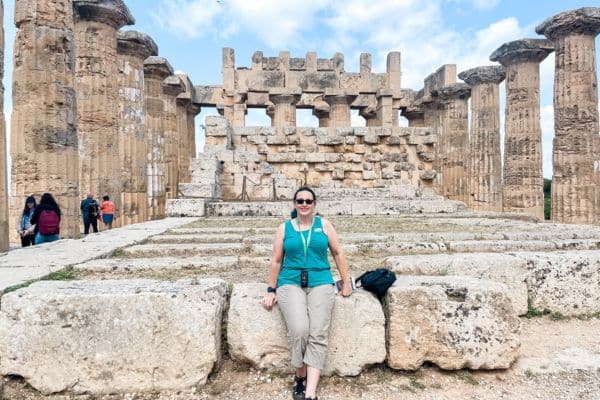
This post may contain affiliate links, which means I’ll receive a commission if you purchase through my links at no extra cost to you. Please read the full disclosure for more information.
Selinunte Archaeological Park Visit Details
Selinunte is located near the villages of Marinella and Triscina. The main entrance closest to the East Hill is in Marinella.
Both are small seaside towns. Marinella seems to have a bit more in the way of places to stay and restaurants, so we stayed there.
- Selinunte Archaeological Park is open from 9 to 6 daily. Visitors must leave the park by 7 p.m. or earlier.
- It’s located at 91022 Marinella di Selinunte, Free municipal consortium of Trapani, Italy . (If you want to take public transportation, you’ll go to Triscina .)
- Tickets cost € 8 (around $8.50 USD).
- Audioguide (which I highly recommend unless you get a guide) is € 5.
- Shuttle cost: € 12 for the longer shuttle ride, which is a 10 km walk.
- The total cost is € 25 (around $27.46 USD) with the ticket, shuttle, and audioguide.
There are bathrooms at the ticket office, Baglio Florio Museum, and the Acropolis. There is a small cafe at the Acropolis.
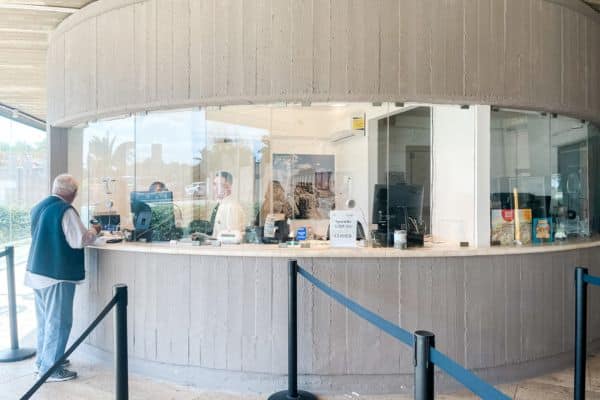
Brief History of Selinunte
Selinunte, named after the wild celery found throughout the area on the river banks, was founded around 650 BC by people from Megara Hyblea (now Augusta). It was located near the sea, and it was important for Mediterranean trade routes. The land was also good for farming.
It grew over the next two hundred years due to political and commercial relationships with the Greeks and Carthaginians into one of the most prosperous cities in Sicily. It was known as Selinous under Greek rule and Selinus under Roman rule.
The city walls were created, and several temples were created. Growth peaked for the city around the fifth century. Selinunte had peaceful commercial relations with the Phoenicians, who settled in areas of Sicily like Agrigento and Syracuse.
In 413 BC, Selinunte fought several battles with nearby Segesta over territory, and the cities were in constant conflict. Segesta was supported by Athens and Carthage (now in Tunisia, northern Africa).
Just a few years later, Carthage’s leader, Hannibal, conquered Selinunte, killing all but women and children. This ended the Greek colony and established Selinunte as a colony under Carthage.
During this time, it was partially rebuilt in the area of the Acropolis. The locals tried to break free from Carthage during the First Punic War. The city was left under Roman rule.
At its peak in around 400 BC, Selinunte was a city of around 30,000. It existed until around 250 BC, when the Romans destroyed and abandoned it.
The colony of Selinunte was rediscovered in the 16th century. Excavations were carried out in the early 19th century, leading to its prominence in visits today.
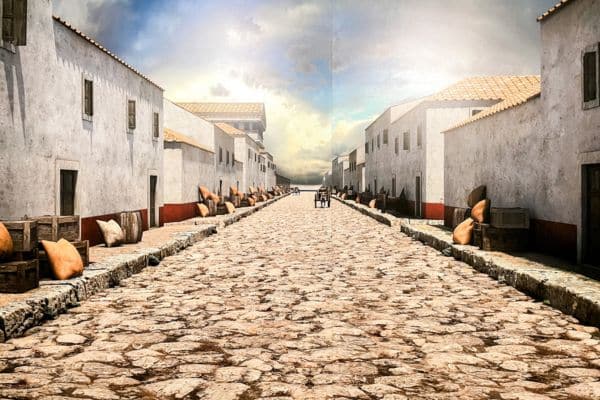
Recreation of Selinous at the Baglio Florio Museum
What to See at Selinunte Archaeological Park
Selinunte is the largest archaeological area in Sicily as well as all of Europe, covering 270 hectares of land (around 670 acres). It’s located in southwest Sicily between two rivers, the Modione River and the Cottone River.
There are five areas of the archaeological site:
- Acropolis —Located near the park’s center, including temples and fortifications.
- Mannuzza Hill —Located near the north of the site with ancient housing.
- East Hill —Located in the east with temples.
- Gaggera Hill —Located in the West, with the Sanctuary of Malophoros.
- The two Necropoleis .
You could easily spend days exploring this huge park’s different areas. Unless you’re an archaeologist or are interested in doing that, you’ll want to focus your time.
I recommend visiting the Acropolis, East Hill, and Gaggera Hill. That’s what the ticket office suggested to us and what our host did as well. Then, if you still want to explore more, you can!
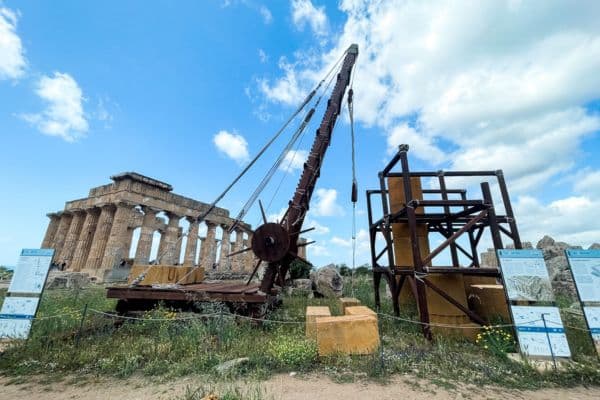
East Hill is a park highlight and worth seeing first. It’s a short walk from the ticket office, so it makes sense to start your tour of Selinunte here. It’s also the location of the only partially reconstructed temple.
In this area, you’ll find the ruins of three temples: Temple E, F, and G. The temples were built parallel to each other, facing east, so the first rays of the sun enter. You’ll also see ancient tools and machinery used to build the temples.
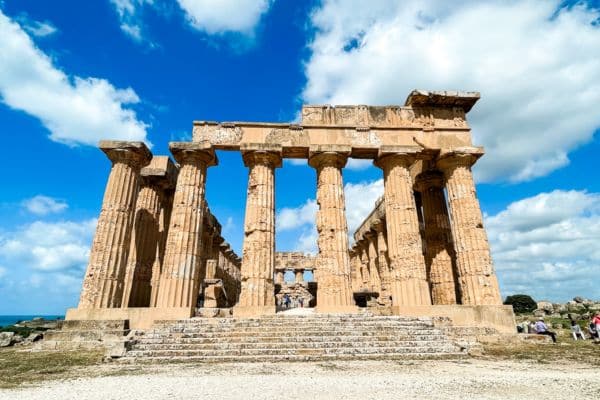
Temple E is the only temple partially reconstructed. It’s a Doric Temple built before 500 BC. It’s believed that it was dedicated to the Greek goddess Hera.
It was built in five phases before it was destroyed by fire around 500 BC. The second construction was completed in around 470 BC. It was built with 15 columns on the long sides and six on each of the short sides. These columns were covered in a layer of white plaster.
An earthquake later toppled the temple, but the columns were rebuilt in around 1958.
You can walk through it and all around the inside, taking in the views. You can see just how massive these stones are and what a feat of engineering building these temples was.
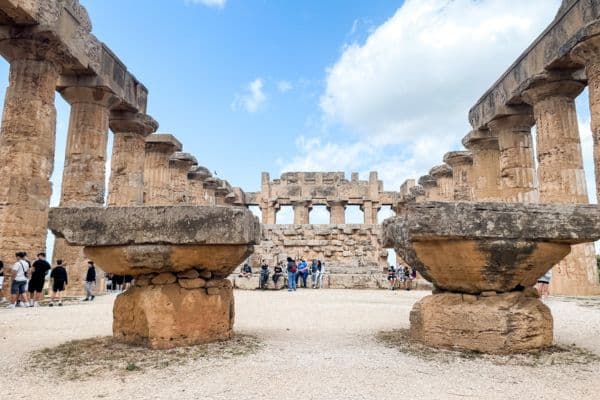
Temples F and G
Both temples F and G have not been rebuilt, so they are in a large pile of rubble.
Temple G was believed to have been a Temple for Zeus, the Greek king of the gods. It was one of the largest temples built in the world as if this time, and the largest in the Greek world.
This temple was designed to compete with the other iconic temples of its time. However, it was never completed.
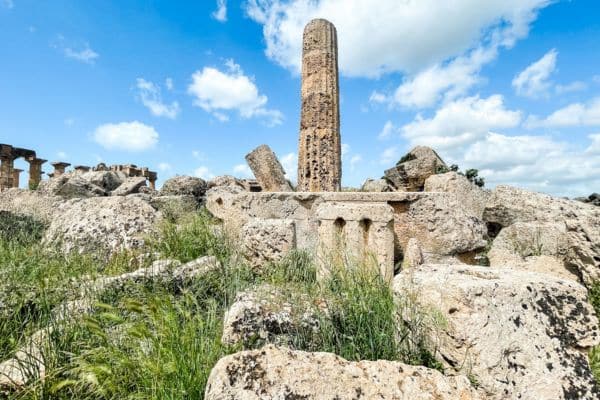
Baglio Florio Museum (Baglio Florio Museo)
This structure was a typical farmhouse built during feudal Sicily. It was built in the first half of the 19th century and was linked to the winemaking business of the Florio family.
During the time it was built, the land was owned by landowners in large plots. There is a mansion built for the landowner on a higher area, representing the elevated position. This structure was where the workers lived.
The museum is well worth a visit as it shows many artifacts from this area. The Institute of Fine Art of New York University worked with the archaeological park in 2006 to excavate the area.
You’ll find items from the temples and some of the areas where people lived in the museum. There’s also a piece of carved stone from the 5th century BC.
There are also items from the excavation of the German Archaeological Institute of Rome, which operated from 1996 to 2007. The focus of this excavation was on the Acropolis.
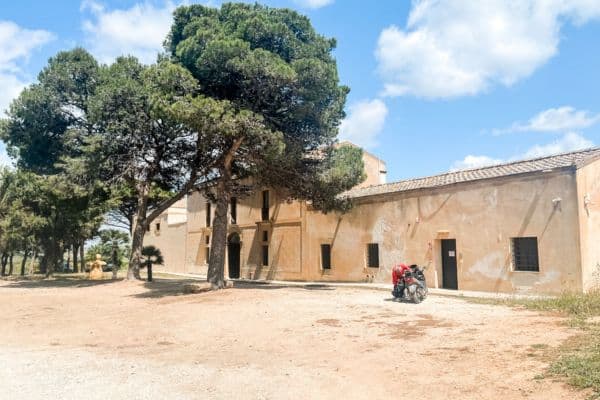
Gaggera Hill
On Gaggera Hill, you’ll find the Sanctuary of Maloferus (meaning apple bearer). This is a reference to the goddess Demeter, whom the sanctuary was dedicated to.
There are also the remains of a wall that was partially constructed in the 19th century.
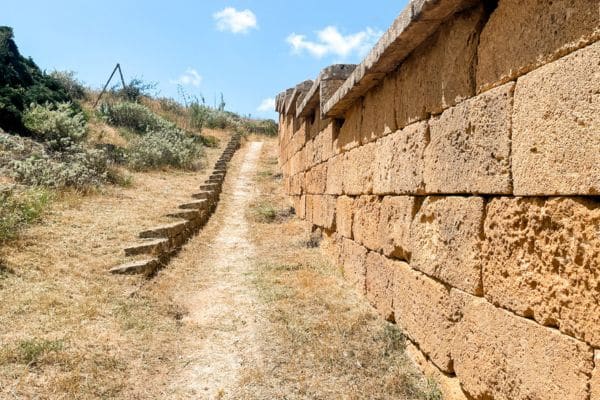
In this area, they found thousands of terra cotta figurines. It’s one of the most important places on the site, and it shows evidence of use as early as the 7th century BC.
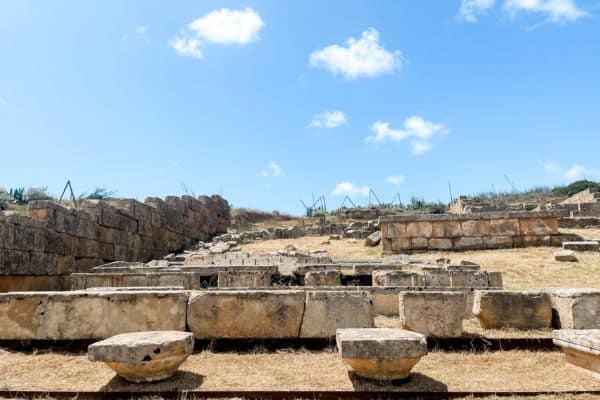
You’ll also see the Sanctuary of Hera, which was partially rebuilt during the excavations.
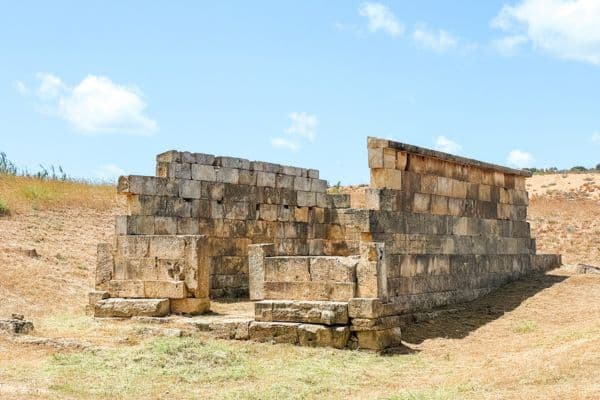
The Acropolis, or city of Selinunte, was ideally located between two elongated hills, later surrounded by a defensive wall. Rivers to the east and west flowed into the bay and served as harbors.
The Acropolis was built on the highest point in the area on the southern hill. It included public and religious buildings, as well as residential areas.
When it was constructed during the 6th century BC, it was organized in a grid plan with parallel streets. You can even still see ruts in the stone roads made by the chariots.
Acropolis Temples
You’ll see sanctuaries and several monumental temples called A, B, C, D, O, and R.
The oldest temples, C and D, are from around the middle of the 6th century BC. They were built with collonades on the eastern part of the Acropolis. Temple D was believed to have been dedicated to Artemis, though it is now thought to be dedicated to Athena, the goddess of war.
Temple R was also built around this time, and it was the first monumental building in Selinus. Vases and terra cotta statuettes were recovered from the site and are located in the museum. An earthquake in around 300 BC destroyed it.
Temple B was constructed around the middle of the 3rd century BC and appears to be a replacement for Temple R. It was built without a colonnade and painted green, unlike the other temples built previously.
Temples A and O were erected later.
These temples have not been reconstructed, though some of the columns remain partially standing. However, there are signs with images and details about each temple so you can get an idea of how they once looked and their size.
You can walk on and through the rocks that once were the temples.
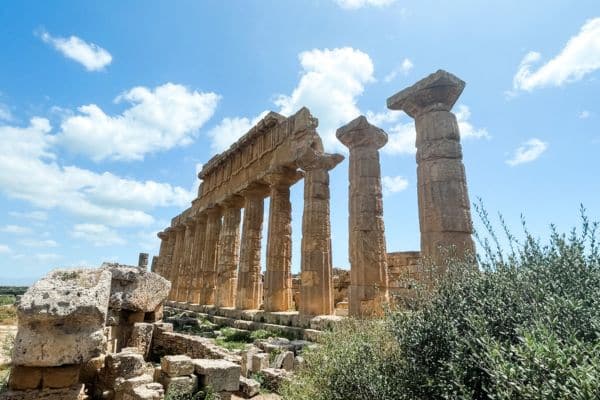
When to Visit Selinunte Archaeological Park
Selinunte is a great place to visit at any time of year. The weather can be quite hot in the summer, and the complex has no shade, so keep that in mind.
Visiting in the spring, fall, and winter may be more comfortable. However, you can visit whenever you’d like!
How Much Time to Spend in Selinunte Archaeological Park
Plan to spend 2-4 hours visiting Selinunte Archaeological Park. The different sets of ruins are not close, and you should prepare for a 30 to 60-minute walk between each of them.
The paths are well-established and easy to follow. They do go uphill, and there’s no shade or water between them.
If you take the little shuttle between them, you can save time. But you’ll still want to spend at least 2 hours visiting, especially if you want to read the information shared and listen to the audio guide.
How to Get to Selinunte Archaeological Park
You have the option to visit Selinunte by car, by public transportation, or by tour. Though costs vary, your best bet is driving or taking a tour if you can.
Selinunte Archaeological Park is located next to the town of Marinella. If you’re driving, plan to stay in Marinella. There are lots of hotels and restaurants in this small town, and it’s easy to walk to the park from any accommodations.
There are two entrances to the park: one in Marinella, which we went to. The other is in Triscina, which you’ll enter through if you use public transportation.
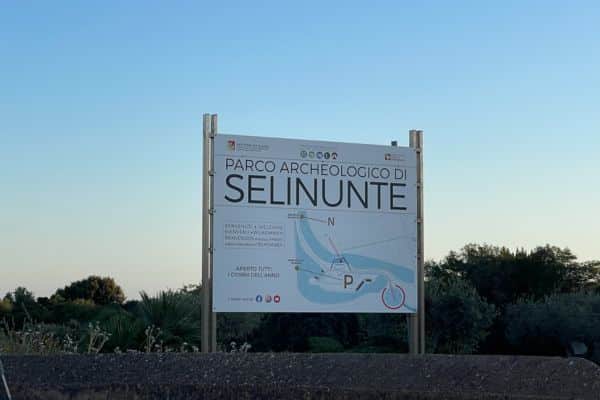
Public Transportation
If you want to take public transportation, you have that option. Take Trenitalia to Castelvetrano from Palermo or Trapani. Then, you need to take a taxi or a bus to Triscina di Selinunte.
In the village of Marinella di Selinunte, you’ll access the park on Selinunte Street. It’s an easy walk from most places in this small village.
If you stay in Triscina di Selinunte or take public transportation, you’ll access the park on Mediterraneo Avenue.
You’ll also find tours to visit Selinunte. This Selinunte tour from Trapani is private, just for your group. There are flexible pickup options in and around Trapani.
Want to see both the Segesta ruins and Selinunte ? You can go on this private tour!
You can also buy your ticket online in advance if you’re interested. No waiting onsite to get in!
I also read that you can get a tour of the park on this cute little train. I didn’t see the cost for that at the ticket office, so ask if you’re interested.
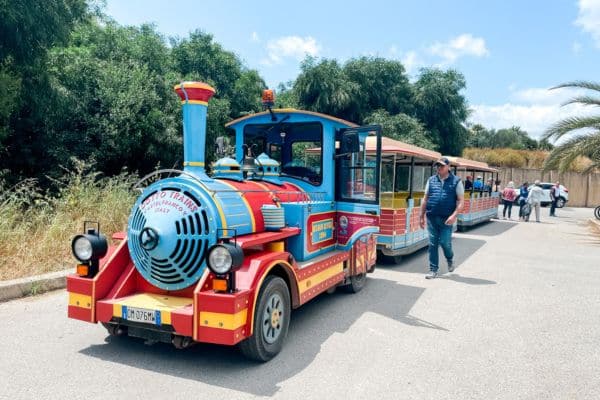
How to Get Around Selinunte Archaeological Park
Selinunte Archaeological Park is quite large, so you’ll do a lot of walking and hiking to get around.
They do offer shuttles that take you to some of the primary sites. If it’s a scorching hot day like when we visited, it’s well worth this little luxury. The property has no shade, and you’ll only find refreshments at the entry and near the Acropolis.
The walks are easy, though long. And though you’ll walk on a pathway for much of it, some areas are uneven and rocky. This is particularly true when walking in areas with ruins in the park.
You are able to walk all around and through the ruins, which is quite nice. However, please be respectful and leave it as you found it.

What to Do Around Selinunte
Visiting the Selinunte ruins isn’t the only thing to do in this area. Here are a couple of other options.
Explore Marinella di Selinunte
This small village is a quaint spot to wander. Take in the gorgeous ocean views and grab a bite at the many fantastic restaurants in the area.
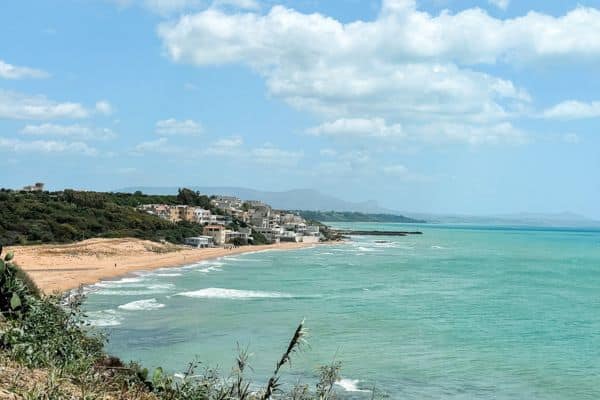
Pierrot Ristorante has a great pizza capriccioso (with tomato sauce, cheese, mushrooms, black olives, and prosciutto). The bruschetta is served on pane nero (“black” local bread).
Baraonda is wonderful with fresh, local seafood dishes like seafood risotto (risotto alla marinara). Both offer ocean views.

Scala dei Turchi
This exquisite white cliff is a fantastic spot at sunset. There is a barricade to keep people from walking on it due to the potential for landslides. However, many people made their way around it to take in the sunset on the way to Agrigento.
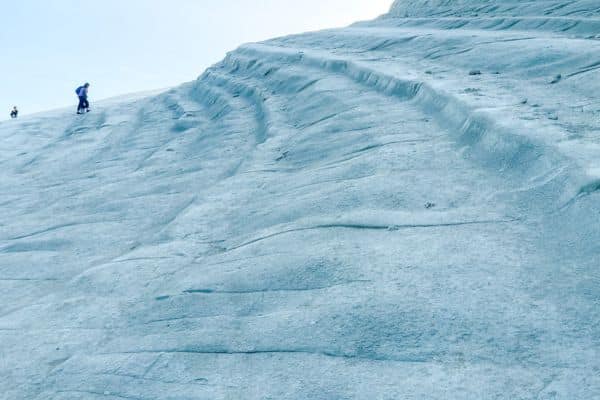
Should You Visit Selinunte Archaeological Park?
There’s something incredible about walking through thousands of years of history. At Selinunte Archaeological Park, you get to do just that.
It’s the perfect compliment to a western Sicily road trip. And it’s really interesting to compare it to the nearby ruins of Segesta and the Valley of the Temples.
You Might Also Like
- What to Expect at Gypset Yoga Retreat Italy—a Detailed Review
- 11 of the Best Things to Do in Capri for a Perfect Day
- What to See When You Visit Pompeii Archaeological Park
- Why You Should Visit the Herculaneum Ruins + Top Tips
- Rome in a Weekend—How to See All of the Top Sites
- 3 Best Umbria Towns to Visit—Gubbio, Perugia, and Assissi, Italy
- Visit the Vatican—A How-to Guide for Visiting Vatican City
- Naples National Archaeological Museum—Why It’s a Must-See + Visit Tips
- Trastevere in Rome—What to See + Top Trastevere Restaurants
- Top Things to Do in Sorrento & Reasons to Stay There
- Segesta Archaeological Park—All You Need to Visit the Segesta Ruins in Sicily
- 8 Top Things to Do in Cefalù in One Day
- Marsala, Sicily—Top Things to See & Do in Two Day s
Like it? Pin it!
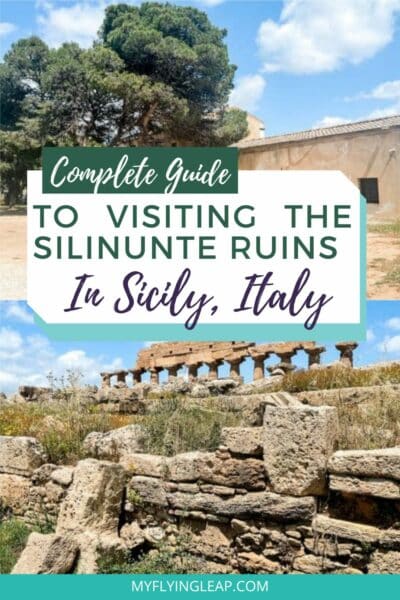
Sam is a travel-obsessed animal lover on a quest to create a life of travel with her dog. She loves learning new things, snuggling a dog, architecture, hiking, and bold red wine. Join her in creating a life to dream about!
One Comment
Thank you, Sam. Your information was very helpful. We are leaving for Sicily in late May for a month. Again, thank you. Thomas
Leave a Reply Cancel reply
Your email address will not be published. Required fields are marked *
AFFILIATE NOTICE
This website uses affiliate links, meaning I may earn a commission if you make a purchase through a link. As an Amazon Associate, I earn from qualifying purchases. Learn more .
- Exciting destinations
- Solo travel
- Travel Tips
- Travel Guides & Itineraries
- Traveling with Pets
- Work with me

Selinunte Archeological Park

Selinunte is undoubtedly one of the most spectacular sites of the ancient world. It stands on a plateau by the sea and takes its name from the selinon, the wild parsley that is very prevalent in the area and an emblem of the city, so much so that it was also reproduced on the coins.

History of Selinunte
The city of Selinunte was founded by Greek colonists from Megara Hyblaea, a city in constant conflict with nearby Syracuse, around the middle of the 7th century and was later expanded. Located on the border with the western area of Sicily controlled by the Carthaginians, it did not have an easy existence, especially when it decided to intensify trade on the Tyrrhenian coast by expanding into the territory of Segesta. Selinunte and Segesta were indeed great rivals and continuously at odds.
It was precisely in 413 BC that another attempt by Selinunte to penetrate the borders of Segesta triggered a war that also involved the great powers of the time: Athens and Carthage came to the defense of Segesta, while Selinunte turned to Syracuse, Agrigento, and Gela for support.
Hannibal landed in 409 BC on the promontory of Lilybaeum with a mighty army, while the Selinuntines were left to fight alone, as the aid from Syracuse and other allied cities was delayed in arriving.
The city was thus destroyed by the Carthaginians, who enslaved or killed about 21,000 of its male citizens. This date marks the decline of the city: it was indeed rebuilt only in the area of the Acropolis but was again occupied by the Carthaginians and by Pyrrhus until it was finally evacuated in 250 BC.
Selinunte what to see

The archaeological park of Selinunte is among the largest in Europe. Indeed, Selinunte had an urban plan on the scale of a megalopolis and was dominated by the acropolis where we find the archaic temples named C and D . On the eastern hill, we find the sacred buildings, denominated as temple G, E, F . Specifically, the archaeological park is divided into four areas: the Gàggera hill with the Sanctuary of Malophros, the acropolis with the temples and fortifications, the Manuzza hill with the ancient settlement, and the eastern hill with other temples.
Temple C is the oldest on the acropolis and one of the primary examples of Greek architecture: perhaps dedicated to Apollo, it has a peristyle of 6×17 columns, an elongated shape typical of the archaic age, and very similar to that of temple D possibly dedicated to Athena.
In addition to the acropolis, there is also the sacred area on the eastern hill, where another 3 temples rise. The most spectacular is temple E probably dedicated to Hera. Dating back to the mid-5th century BC, it also has an elongated shape, and there we also find an Adyton (a small rear chamber with access forbidden due to the presence of the oracle – only priests could enter).

Sicilia. Lonely Planet. Acquista su Amazon
From the excavations in the archaeological area, two earlier structures have also emerged: this has been very important for studies on the building techniques of the ancient age. The buildings of Selinunte have been damaged by the various earthquakes that have struck the island. In fact, Temple E has been reconstructed through anastylosis.
The sculptures found in the archaeological site of Selinunte are located in the National Archaeological Museum of Palermo , except for the Selinunte Ephebe, which is found at the Museum of Castelvetrano.
Download the map of the Selinunte park .
Selinunte’s Cusa Quarries
About 13 km from the ruins of Selinunte are the Cusa Quarries : stone quarries characterized by banks of calcarenite from which material was extracted for use in the city’s construction. They were in use from the 6th century BC until the tragic destruction of the city in 409 BC. The most interesting aspect is the abrupt interruption of work due to the landing of Hannibal.
The sudden flight of the quarry workers has allowed us, even today, to recognize and reconstruct all the various phases of processing, from the initial incisions to the finished drums that were to be taken away.
If you want to visit the two great enemies, Segesta and Selinunte, Get Your Guide offers a tour to discover the two cities starting from Trapani.
Orario di apertura: 9.00 – 19.00 ( ultimo ingresso 18.00 ) Dal 1 ottobre: 9.00 – 17.00 Dal 28 ottobre: 9.00 – 16.00
Cusa Quarries: Temporarily Closed.
Check the official website for any changes to the schedule.
Near Selinunte you can also visit the archaeological park of Segesta. In Sicily you also have many other truly spectacular archaeological sites such as the Valle dei Tempi in Agrigento and the Roman Villa del Casale in Piazza Armerina. Look at all the archaeological parks in Sicily reviewed on the platform.
Ticket: Full price €8.00; Reduced €4.00
You can purchase park tickets online at Get Your Guide or you Tiquets with return shuttle service.
Free entry for European citizens under the age of 18 and every first Sunday of the month.
For all concessions, consult the concessions page.
Guided Visits and Tours
Here are some proposals for guided tours and tours of Selinunte and nearby parks:
- Tour from Sciacca to Segesta and Selinunte. Discover and book on Get Your Guide
- Segesta and Selinunte, tour from Trapani. Discover and book on Get Your Guide.
How to reach the Selinunte archaeological park
ON THE TRAIN
If you travel by train you can arrive with Trenitalia at Castelvetrano station and then continue by bus or taxi towards Selinunte.
You can arrive by bus to Trascina di Selinunte and then continue on foot for about 500 metres.
The Park can be reached from the main Sicilian cities. From Palermo: take the A29 Palermo-Mazara motorway, exit Castelvetrano. From Trapani: travel along the A29 motorway, after the junction for Segesta proceed towards Mazara del Vallo until the “Castelvetrano” exit. From Agrigento: take the Strada Statale 115 until the junction for “Castelvetrano-Marinella di Selinunte”. After taking the exit, continue straight as indicated until you reach Marinella di Selinunte.
Email: [email protected]
URP: 0924 1911583 int. 207
INFO: 09231990030
Where to sleep in Trapani

- Biglietti prioritari
- Visite guidate e Tour
- Consigli di lettura
in evidenza
- Tour Colosseo e Foro romano
- Tour Pompei con archeologo
- Pass 3 giorni Napoli, Pompei, Ercolano
- City Pass 3 giorni Roma e Vaticano
naviga per regione
- Emilia-Romagna
- Friuli Venezia Giulia
- Trentino-Alto Adige
- Valle d'Aosta
naviga per civilta'
- Antichi Greci
- Antichi Romani
- Civiltà Età del Bronzo
- Popoli italici

- Skip to content
- Skip to primary sidebar
Italia Living
Live Life Italian Style
Explore the Greek Ruins of Selinunte in South-Western Sicily
Featured , Travel / May 2024 by Italia Living
The archaeological site of Selinunte is as impressive as the Valley of the Temples in Agrigento, but way less busy
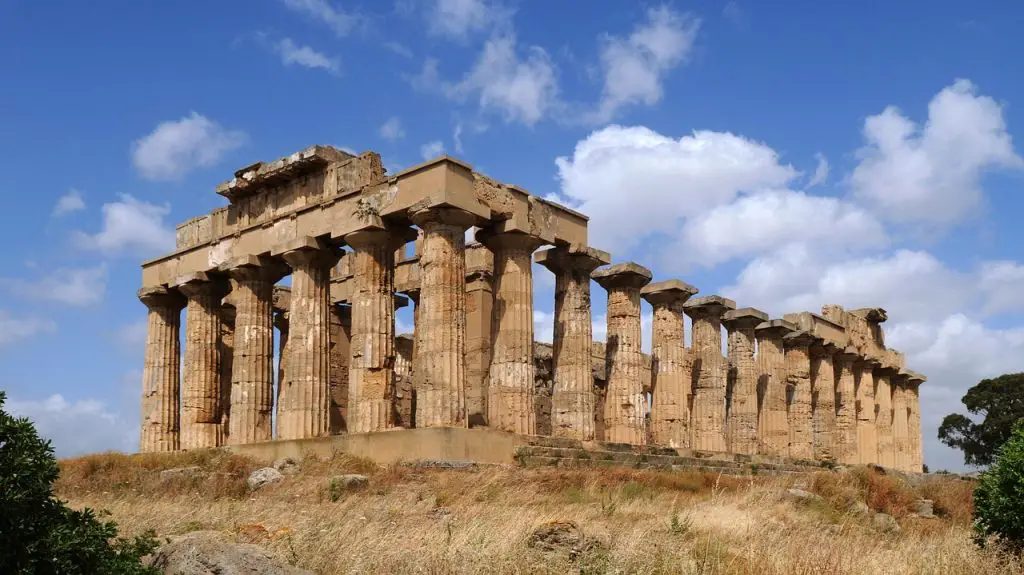
On the southwest coast of Sicily, in the province of Trapani, lies Selinunte , one of the largest and most important archaeological sites in the Mediterranean. A day spent strolling around the Greek archaeological site of Selinunte, between Sciacca and Marsala, is a must on any trip to sun-kissed Sicily , the largest island in the Mediterranean.
Not far from Mazara del Vallo, the colony of Selinunte was built on a high plain overlooking the deep blue waters of the Mediterranean Sea in the 7 th century BC, strategically positioned for trade routes to North Africa, and grew into a prosperous trading port. With its commercial wealth, the ancient Greek city of Selinus erected grand temples to a pantheon of Greek gods.
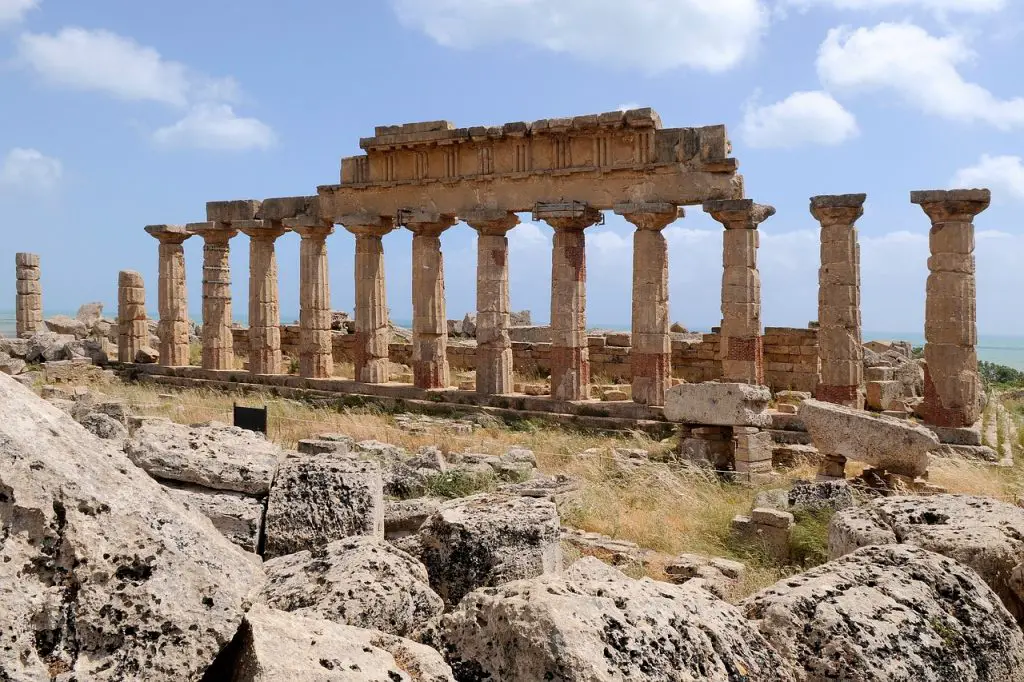
What to see in Selinunte
Wandering around its impressive array of temples and other ruins, it is easy to imagine the ancient town of Selinus as it would have been 2500 years ago, before it was attacked, defeated and destroyed by Carthaginian forces in 409 BC. From being one of the most eminent cities in Magna Graecia, Selinunte became a ghost town and was forgotten until its rediscovery in the 16 th century.
One of the most impressive ancient Greek sites in Sicily, the site of Selinus is huge and incorporates Greek temples and the remains of both commercial and residential buildings. Flanked by long glorious sandy beaches that stretch for miles on either side, Selinunte is now the largest archaeological park in Europe.
The vast Acropolis of Selinunte still has an air of noble, albeit faded, beauty, and the shrub and vegetation add an air of wildness to the site. The ground around its temples and Hellenistic agora is covered in fennel, sea holly, poppies and the wild celery – selinon in Greek – that gave the colony its name.
The eastern temples are the most stunning of all Selinunte’s jumbled ruins. The majestic Temple E, also known as the Temple of Hera , was erected in the 5 th century BC and reconstructed in the 1950s.
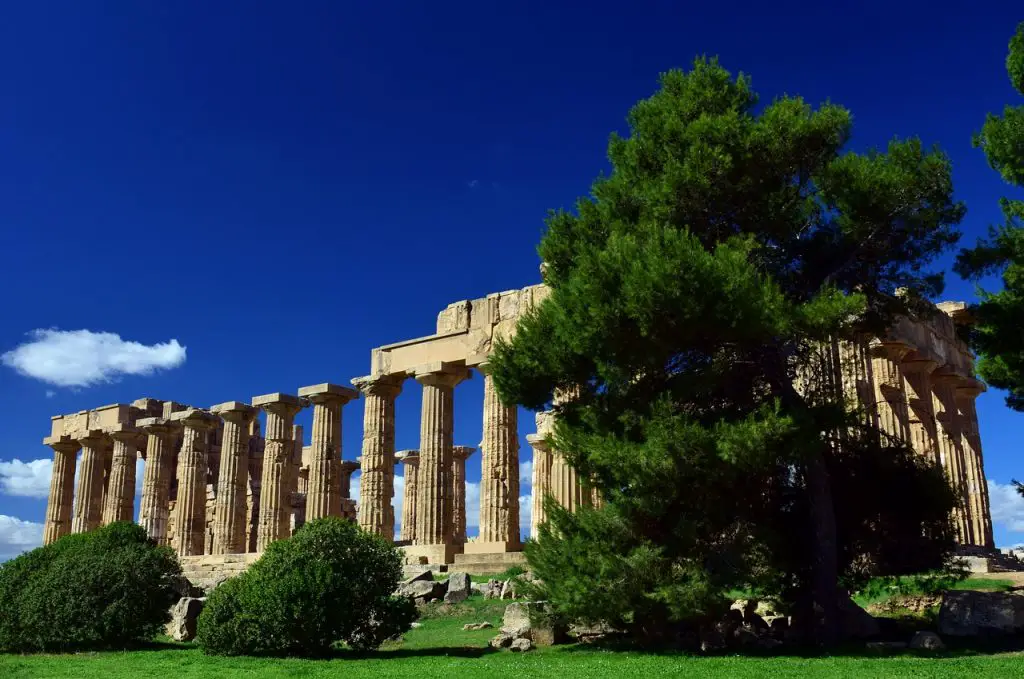
Probably dedicated to Zeus, Temple G was built in the 6 th century BC and was one of the biggest temples of the ancient world. It is now a massive pile of rubble. Temple F is the oldest temple on the site.
Huddled in the south-eastern part are five temples:
- Temple A and Temple O, built between 490 and 480 BC and dedicated to the twins Castor and Pollux;
- Temple B, dedicated to the Agrigentan philosopher Empedocles;
- Temple C, built in the 6 th century BC and dedicated to either Apollo or Heracles;
- Temple D, built in the late 6 th century BC and dedicated to either Athena or Aphrodite.
The stones used to build the sacred temples in the ancient Greek city of Selinus came from the nearby Cave di Cusa , an ancient stone quarry about 12 miles north of Selinunte, which we strongly recommend you also visit.
The best time to visit the archaeological park is definitely spring, when you can admire the colours of the wild flowers and herbs that pepper the vibrant green grass.
There are two entrances to the Greek archaeological site, one from Triscina to the west and one from the charming seaside village of Marinella di Selinunte to the east. A trip to Selinunte is a great family day out, especially if you combine it with a visit to the beach at Marinella, one of Sicily’s most picture-perfect beaches, with a long stretch of golden sand and excellent fish restaurants.
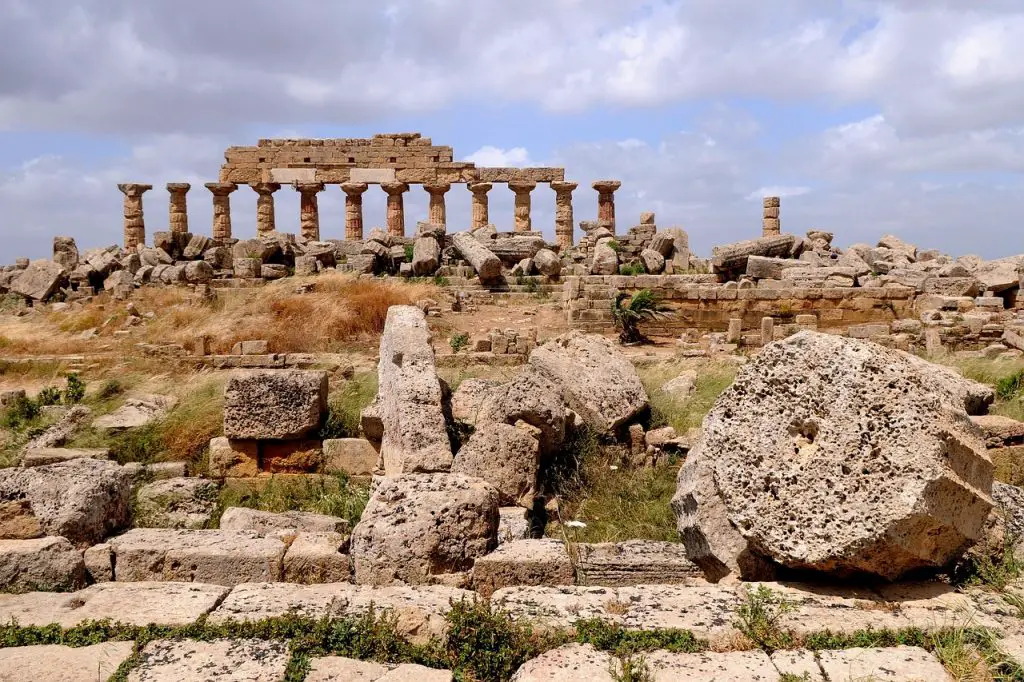
While visiting the ruins of the Greek temples of Selinunte, you can even stay in a private, upscale, self-catering vacation home in the surrounding area, distinguished by its paradisiacal golden beaches, crystalline waters, luscious vineyards, olive groves and fishing ports.
Related Articles
- Buon Ferragosto! An August 15th Italian National Celebration
- 5 Reasons to Live in Sardinia
- Things To Do In Palermo
- The Ancient Beauty of Valley of the Temples
- Rocco Forte to Open New Hotel in Sicily, Italy
- Stunning Mediterranean Coastline Destinations
Article Categories
Follow us on social media.
Selinunte, Sicily; an impressive site of ancient Greek temples

Visit Selinunte
Selinunte is situated on the southern coast of western Sicily, south-east of Mazaro-de-Vallo .
More than 2500 years ago Selinus (as Selinunte was then known) was one of the most important cities in Ancient Greece. This role continued until 409 BC when Hannibal and the carthaginians arrived and pretty much destroyed the entire city.
Explore Selinunte
Sicily Visitor comment: Sicily is home to some incredible Greek remains and Selinunte is one of the best which combines temple ruins and pretty views to make for a very atmospheric visit.
The Greeks liked their temples - and there are eight of them clearly identifiable to visit at Selinunte. Not in great condition for the large part but the sheer number of temples here ensures the importance of the site. Selinunte is now one of the most important ancient historical sites in Sicily, perhaps Italy.

There are two main parts to the site, the Acropolis and the East Hill. As you enter the site the East Hill is the first part you will get to and is home to Temple E which has undergone some controvertial renovation and is now the only one with a large part still upright.
Temple E dates back to 460 to 450 BC and was dedicated to Hera, goddess of women. Many metopes (small statues) were used to decorate this temple and four have been preserved. These can be viewed in the Archaeological museum in Palermo .
Also on East Hill is Temple F and G. Temple G was originally the biggest at Selinunte. It was probably never a finished temple but if it had been it would have been one of the biggest in the world at the time. Temple G was dedicated to Apollo and Temple F which is the oldest of the three (550-540BC) was dedicated to either Athena or Dionysus.
At the other end of the site is the Acropolis. The Acropolis was a town surrounded by stone walls and towers. At one end it sits on the edge of the cliff overlooking the sea and it is near to here that the other 5 temples of Selinunte can be found - temples A,B,C,D and O.
Temples C and D are the oldest in the site having been constructed in the mid 6th century BC. Fourteen of the columns of temple C were re-erected in the 1920s as well as some architraves. Temple B is close to these two as were most of the ancient sacred buildings of Selinunte.

In the south-eastern corner of the Acropolis temples A and O are very close together and date back to the 5th century BC. These were converted into a fortress in the Middle Ages.
There is also a museum at Selinunte where you can see some of the many artefacts uncovered at the site and exhibits show what the temples would have looked like originally.
As the site is so large there are electric vehicules that you can ride on for a small charge which will take you around the site. Useful if you are in a hurry or have mobility issues or don't want to be hiking in the hot sun.
Selinunte beaches
The archeological site of Selinunte occupies a lovely clifftop position. There is no direct access to the beaches below but you can reach them from the neighbouring town of Marinella-di-Selinunte. The beaches are protected and are lovely to visit after a hot morning admiring the temples.

A little history
In its heyday Selinunte was the grandest of the towns of Sicily and with its walls and temples the inhabitants felt secure despite quarrels with other towns especially nearby Segesta. However in 409 BC Segesta recruited the aid of the Carthaginians and an army of 10000 men landed on Sicily and attacked Selinunte.
Selinunte fought hard but was defeated and 16000 of its inhabitants were massacred and 5000 taken away as slaves. The town and its temples were sacked and destroyed. It never recovered and because of this the site remains largely unaltered and so of great interest to us today.
Where to visit nearby?
Mazara-del-Vallo has an interesting historical centre and a pretty seafront.
Sciacca to the east is a popular beach resort and spa town.
If you are now in the mood for more temple visits, nearby Segesta is also home to an important temple.
The other main temple site to visit is Agrigento which has a magnificent collection of temples spread out throughout a valley - the Valley of the Temples.
The valley at Agrigento is larger, busier and more commercialised than Selinunte and has more temples to see however we enjoyed the more peaceful atmosphere at Selinunte and the beautiful vista of the Acropolis against the sea.
You can find more local travel ideas in the West Sicily guide ,
Photos of Selinunte
Click any picture to start the gallery

Map of Selinunte and places to visit
Selinunte places to visit.

Mazara del Vallo
Mazara is a pleasant town with beaches and an Arab casbah.

Sciacca is one of the oldest spa towns on Sicily.
Select your language
Popular places
Sicily Visitor - copyright 2006 - 2024 :: privacy policy
Selinunte Archaeological Park

- Facilities 2.0
- Atmosphere 4.0
The largest archeological area in Europe at about 670 acres, this site was once home to one of the largest Greek colonies on the island, dating to 600 B.C. Today, visitors can tour the ruins of seven Doric temples, as well as the necropolis and caves. There are different hiking routes to see the various structures that range from about a quarter-mile to about 3 ½ miles.
Recent visitors said the site does require a lot of walking on uneven ground, and they recommended hiring a guide to fully explain the history of the area.
The park located in the town of Castelvetrano on Sicily's western coast about 80 miles south of Palermo. It is open daily from 9 a.m. to 4:30 p.m., and tickets cost 6 euros (about $6.70). Admission is waived on the first Sunday of the month. It's recommended that you allow at least an hour to visit the site. If you tire of walking, you can take a golf cart between sites for 6 euros. For more information, visit the official website .
Popular Tours

Palermo Original Street Food Walking Tour by Streaty
(1651 reviews)
from $ 78.50

Cooking Class with Seaview & Taormina's Market with Chef Mimmo
(428 reviews)
from $ 108.08

Private tour of Etna and Winery Visit with Food and Wine Tasting from Taormina
(145 reviews)
from $ 377.72
More Best Things To Do in Sicily

#1 Aeolian Islands
There are many lovely islands off the coast of Sicily, and the hardest part may be choosing which ones to see. A popular choice is the Aeolian Islands, located near Messina and composed of seven main islands, which were created by active volcanoes. There you will find incredible sites like a Greek acropolis, a Norman cathedral, beautiful beaches, volcanic vents and even lava running into the sea.
Past visitors recommended visiting Stromboli volcano (seeing it at night when erupting is extra spectacular), the Museo Archeologico Regionale Eoliano on Lipari, the Scalata al Cratere on Isola Vulcano and Chiesa Vecchia di Quattropani on Lipari, as well.
Explore More of Sicily

Things To Do

Best Hotels

You might also like

# 2 in Best Places to Visit in September

# 5 in Best Honeymoons in Europe for 2024

# 1 in Best Beaches in Italy
If you make a purchase from our site, we may earn a commission. This does not affect the quality or independence of our editorial content.
Recommended
16 Top Adults-Only All-Inclusive Resorts in Mexico
Christina Maggitas|Rachael Hood|Catriona Kendall September 13, 2024

The 26 Best Beach Resorts in the World
Marisa Méndez|Erin Vasta|Rachael Hood|Catriona Kendall September 5, 2024


30 Fun Fall Weekend Getaways for 2024
Holly Johnson August 29, 2024

The 19 Best Fall Family Vacations for 2024
Amanda Norcross August 27, 2024

The 28 Best Water Parks in the U.S. for 2024
Holly Johnson|Timothy J. Forster May 8, 2024

The 18 Best Napa Valley Wineries to Visit in 2024
Lyn Mettler|Sharael Kolberg April 23, 2024

The 25 Best Beaches on the East Coast for 2024
Timothy J. Forster|Sharael Kolberg April 19, 2024

The 50 Best Hotels in the USA 2024
Christina Maggitas February 6, 2024

The 32 Most Famous Landmarks in the World
Gwen Pratesi|Timothy J. Forster February 1, 2024

9 Top All-Inclusive Resorts in Florida for 2024
Gwen Pratesi|Amanda Norcross January 5, 2024

Selinunte: Sicily Tourist Guide
Fantastic archaeological site on the coast of southern Sicily; where Greek temples stand on a hill above the sea
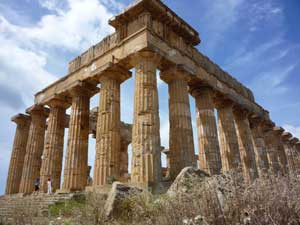
About Selinunte
Selinunte is one of Sicily’s great Greek archaeological sites. Situated by the sea in the south-western corner of Sicily, the isolated ruins here have stood abandoned for most of their history. The lack of later development allows modern visitors to imagine the ancient town of Selinus as it would have been two and a half thousand years ago. The archaeological park at Selinunte is huge, incorporating Greek temples, ancient town walls, the ruins of residential and commercial buildings, countryside paths and zones not yet excavated. If you are interested in Greek Sicily, this is a very important site to visit, and the temples’ setting close to the sea is wonderfully picturesque. There are sandy beaches nearby, so a day out at Selinunte has a great deal to offer any traveller.
- Sicily destinations and practicalities: full menu (at foot of this page)
Visiting Selinunte: Practicalities
The archaeological park covers a very large area. Many visitors will never make it to the farthest ruins; if you want to explore thoroughly you should allow a minimum of 3-4 hours. Wear sensible shoes and take water, a hat and sun protection (even an umbrella to use as a parasol) in the summer. There are some shady spots in a valley within the site where you could picnic; we also found an enterprising local selling iced drinks half-way around. Opposite the entrance are souvenir stalls and a bar with tables where you can buy drinks, snacks and freshly-made rolls. Toilets are available by the first group of temples.
There is a little electric ‘train’ service which runs around the site on a couple of different-length itineraries. If you have mobility problems or a very rushed schedule, this might be worth paying for. It’s really much more pleasant, though, to wander around the site at your own pace and find moments of solitude among the ruins.
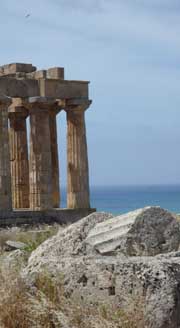
The archaeological park is open daily from 9am, closing at 5pm in the winter and 7pm in the summer. Like Italy’s other state-run museums and archaeological sites, Selinunte is free for EU visitors under 18, and reduced for 18-25 year olds. Sicily does have its own rules, but concessions generally also apply to students and to citizens of countries ‘with reciprocal arrangements’ so it’s worth asking if you’re not sure. Take passports or other proof of status. There’s a book and souvenir shop inside the entrance; it’s worth buying a map or guide to help you make sense of the site.
Ancient Selinunte: History, temples and archaeological site
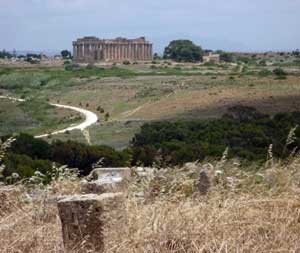
Selinunte – Selinus – actually wasn’t a huge city. It was a reasonable-sized town, but the scale of its temples indicate Selinunte had ideas high above its station. Founded in the seventh century BC by Greeks from Megara Hyblaea, itself a colony of Megara in Greece, Selinus was spread over a couple of low hills on the seashore. The town probably reached its peak in the sixth and fifth centuries BC, the era when its grand temples were constructed. In 409 BC Selinus was attacked, defeated and destroyed by the Carthaginians. There were later attempts to re-fortify the citadel, but the town’s greatest days were over.
After earthquakes shook the remaining buildings to bits in the Middle Ages, the site of Selinus was forgotten until its rediscovery in the sixteenth century. In the early nineteenth century English archaeologists began the work of excavation, which still goes on today.
On entering the archaeological park, the first sight you see is the grandest. The large Doric temple known as Temple E was re-erected in the 1950s and stands proudly on a rise. It is an impressive evocation of Sicily’s Greek past, and, unusually, visitors can climb into the temple itself to get a real sense of the scale and history of the building.
Behind Temple E are two more temples – this low hill would have been a sacred site outside the town centre. These temples are much more ruinous. The furthest from the entrance, Temple G, was a massively ambitious project that may never have been finished. It would have been one of the biggest temples of the ancient world, and the mound of masonry is still impressive today. Clambering among the sections of column is a memorable experience – it is interesting to get an idea of Greek construction techniques from the blocks of carved stone, to marvel at the scale and ambition of the building, and at the force of its ultimate destruction, at the hands of the Carthaginian conquerors and of later earthquakes.
From this eastern part of the site, visitors cross a shallow valley where Selinunte’s port once stood, and climb up to the heart of town on another low hill. The acropolis and more temples (one partially re-erected) were in this part of the city; the earliest part of Selinunte to be built and also the last to be inhabited by the survivors of the Carthaginian siege. At its heyday the town’s main residential areas covered the level ground inland from this hilltop; parts of the street layout have been excavated, though the ruins aren’t as striking as those in the main hilltop cluster.
On the western hill is a small museum which exhibits finds from the site and helps give an idea of how the temples – brightly painted and decorated – would have looked. Unfortunately the best portable remains, including the metopes – sculpture panels from the temple frieze – are now in the archaeological museum in Palermo.
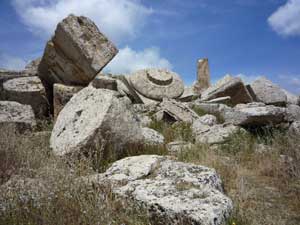
Despite the grandeur of Selinunte’s temples and the powerful images of its jumbled columns, the town’s domestic architecture can be at least as fascinating. A street of ruined shops is a compelling reminder of the everyday life in ancient Selinunte.
Some of the extant ruins at Selinunte are very poignant. After the big defeat in 409 BC, defensive walls built of existing masonry were thrown up in a desperate attempt to defend the nucleus of the city. A row of twelve narrow openings in the fortifications were supposedly designed for lines of men to run out in the town’s defence in the event of a military assault; not an enviable job.
If you have the time, you should walk onwards to Selinunte’s third major group of ruins, along a path to the west which leads through fields. By a stream you will find the remains of a very early sacred site, the Malophorus sanctuary. There is a simple temple here, sacrificial altars and a carefully constructed water course. This was evidently an important site used over a long period. Archaeologists found thousands of votive offerings, mostly terracotta figurines, here, and much of the Selinunte material exhibited in the Palermo archaeological museum is from this part of the site.
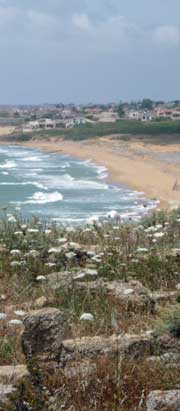
Marinella di Selinunte
Outside the entrance to the Selinunte archaeological park is the seaside village of Marinella, also called Marinella di Selinunte. It’s a fairly undistinguished modern settlement, making a living from fishing and its proximity to tourist Selinunte. Its sandy beaches and convenient location make it a decent place to stay for overnight visitors.
Castelvetrano
Selinunte lies in the comune (council district) of Castelvetrano, an important transport hub if you are relying on trains and buses. Castelvetrano is a busy and typical Sicilian town, which most travellers will only glimpse on the way to Selinunte (read on for travel details). It has some historical buildings and a lively main street lined with shops. If you have time, it is worth paying a visit to the town museum (Museo Civico) to see the Efebo di Selinunte, a fifth-century Greek bronze statue of a youth. Castelvetrano appears in the history books as the site of the death of controversial twentieth-century Sicilian bandit Salvatore Giuliano – a courtyard at Via Mannone 92-100 is where his body was found, though the true circumstances of his death in 1950 remain mysterious.
Cave di Cusa
If you are driving, consider making a detour from Selinunte to visit the Cave di Cusa, around thirteen miles away. These are the quarries used by the ancient Greeks of Selinus to supply the stone for building the town’s temples. Work stopped abruptly after Selinunte’s defeat, and today’s visitors can see great stone column sections, cut then abandoned. The Cave di Cusa site is to the south of the town of Campobello di Mazara.
Selinunte travel and transport
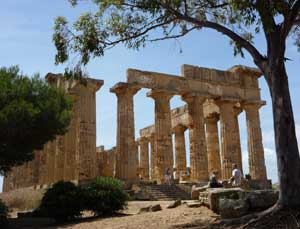
Selinunte’s only public transport connection is a bus from Castelvetrano, the nearest town. This is a cheap and simple journey, but you will need to plan ahead. To find the latest timetables, look under ‘ tratte urbane ‘ on the Salemi bus website, indicated in the links panel on the right, and find the timetable for the Marinella di Selinunte service. Note that some services run Monday-Saturday ( feriali ) and others run on Sundays and public holidays ( festivi ). The bus stops right outside the railway station in Castelvetrano, where there is a convenient cafe-bar which advertised (when we visited) basic tourist information and a luggage storage service. The bus ride lasts about half an hour and stops very close to the entrance to the archaeological site of Selinunte (ask the driver if it’s not clear which way to walk).
Castelvetrano can be reached by train; it is on the line which runs from Trapani (an hour away) and also stops at Marsala and Mazara del Vallo before reaching Castelvetrano. Trains continue to Palermo. There is also a useful bus service operated by a company called Lumia which connects Castelvetrano with other towns in this area including Sciacca and Agrigento. Salemi buses link Castelvetrano with Marsala and Palermo.
There is car parking outside the archaeological site at Selinunte.
Selinunte accommodation
Hotels and b&bs.
As Selinunte covers such a large site and takes a long time to visit, it makes a lot of sense to spend a night nearby and perhaps enjoy the beach as well. At Marinella there are some practical, though uninspiring, hotels. If you have a hire car, you could choose somewhere more appealing in the countryside nearby. Hotel Eracle , is a decent and affordable modern four-star with a restaurant in Marinella and close to the archaeological park. Other options include Il Vigneto Resort , offers contemporary-design accommodation in vineyards a short drive from Selinunte, while Case di Latomie is a rural retreat with a swimming pool and a restaurant serving local produce. > Find accommodation in and around Selinunte
Transport in Sicily
Combine Selinunte with
Useful external links
Selinunte hotels & B&Bs
Italy car hire
Lumia buses
Salemi buses
Sicily destinations and more
- Sicily introduction
- Food & drink
- Hotels & B&Bs
- Travel and transport
- Aeolian Islands
- Castellammare del Golfo
- Egadi Islands
- Giardini Naxos
- Piazza Armerina
- San Vito Lo Capo
Sicily hotels – Online hotel reviews and booking (Italy Heaven affiliate link – thank you for your support)

- Exhibitions
- Handicrafts
- Cinema and TV
- Ancient art
- '800 e '900
- Contemporary art
- AB Arte Base
- All reviews
- Mostre in corso
- Mostre concluse
- North Italy
- Center Italy
- South Italy
- Islands of Italy
- Foreign countries
- Exhibition finder
Selinunte, what to see: 11 stops at the archaeological site
Selinunte is a piece of ancient Greece in the heart of western Sicily . Selinunte is located in the municipality of Castelvetrano , a small town in the province of Trapani that offers its visitors not only white beaches and crystal-clear waters, but also many places to see important traces of the past up close. The most famous is surely the great archaeological park of Selinunte, Cave di Cusa and Pantelleria . In this, which is one of the largest archaeological areas in Europe, one can literally walk through history. The origins of the city of Selinunte are traced back to the mid-7th century B.C. at the hands of settlers from Megara Hyblaea . The Selinuntines occupied strategic points in the future urban area and defined the limits of vast agricultural areas to be exploited. At the beginning of the 6th century B.C.E. the urban layout was rigorously realized through the construction of the road system that can still be observed today. In 409 B.C. the city was destroyed by the Carthaginians and then remained in their hands until the Roman conquest a century and a half later. The archaeological area today is a veritable treasure trove of finds with its spectacular temples, but also with what remains of the old quarters by observing them one can easily imagine what life was like in Selinunte at the time of its heyday. Here are eleven must-see stops on your visit to Selinunte.
1. The Acropolis
The Acropolis is surely the most resplendent jewel of Selinunte. Its construction dates back to the city’s origins in the 6th century BC. The design of the Acropolis has a trapezoidal shape with, in the northern part, a large stepped wall surrounded by walls formed by curtains of square blocks with a filling of rubble and punctuated by 5 towers and 4 gates. To the north, the Acropolis has fortifications dating from the early 4th century B.C., while at the height of the main entrance is the so-called Tower of Pollux, which was built in the 16th century against privateers. The first temples built on the Acropolis, those P and R, date from the first half of the 6th century B.C.E., but already by the middle of the century the main sanctuary building became Temple C with its large altar. Temples D, A and O were later added. Later, beginning in the 4th century B.C.E., the sacred areas were occupied by Punic dwellings, and a Carthaginian sanctuary arose in the pronaos of temple A. Before the abandonment of the city, southeast of Temple C, the small Temple B was built, noted for the polychromy of its architectural elements.
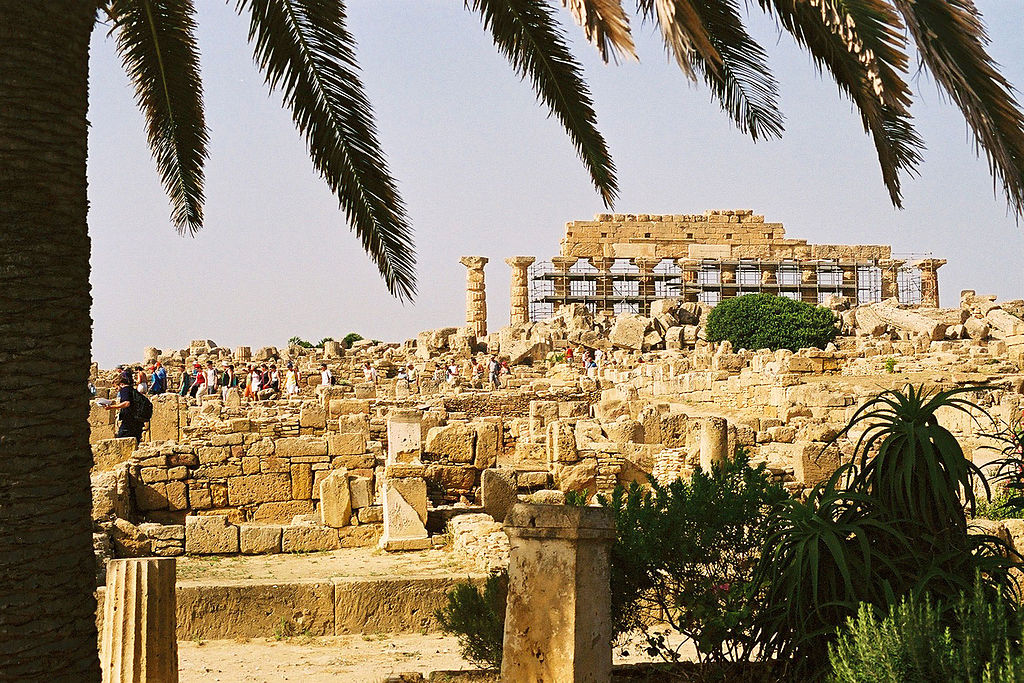
2. Temple A
According to archaeologists’ reconstructions, Temple A, built around the mid-5th century B.C., was certainly the most harmonious and refined temple in the city. Small in size, it had columns surrounding the cella in perfect symmetry, while the end of the cornice, the sima, was decorated with precious insular Greek marble and crowned the well-proportioned elevation. In the cella the entrance with the two columns is offset to the west by the similar opisthodomos. In contrast, the compartment for the worship statue is separate from the cella. Very elaborate elements are the two spiral staircases placed in the entrance wall to the cella: this is probably the first example of a spiral staircase in the history of architecture. Finally, the great altar echoed in a small way the forms of the Peripteral temple with its mensa, which was bordered by a colonnade with a Doric entablature and two pediments serving as cheeks. Only the side facing the temple was interrupted by a wide flight of steps, essential for worship services.
3. Temple C
The subject of major restoration work since the 1920s, Temple C is certainly one of the best known and most immortalized corners of Selinunte today. Temple C, also known as the Apollonion, was built around the mid-6th century B.C., with imposing dimensions and a second row of columns on the front. The main east side, where the entrance to the temple was located, housed in the pediment the famous painted terracotta Gorgon’s head, while the frieze contained the figurative reliefs of the metopes, now preserved in Palermo, depicting some famous episodes of Greek mythology such as the Quadriga of the Sun, Perseus slaying Medusa, and Heracles victorious over the Caecropes. The North Colonnade was raised between 1925 and 1927 and has undergone several restorations in recent years. Here, having passed the monumental entrance staircase, one enters a spacious portico divided in the center by four columns. In the center of the cella was a table for sacrifices and offerings, while the worship statue was inserted in the back compartment.
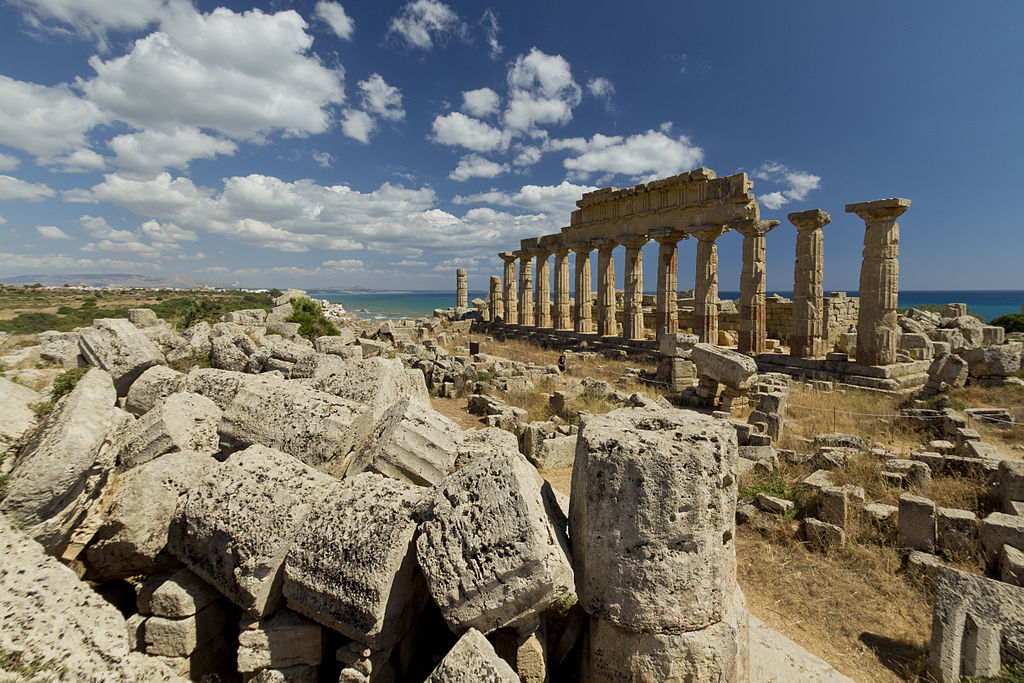
4. Temple D
Temple D dates from the last quarter of the sixth century BCE and is located immediately north of the large Temple C. Here The extension in length is reduced with the arrangement of only 13 columns on the long sides, while the second colonnade on the east side, characteristic of the Archaic age, is abolished and seems to merge with the front of the cella. Temple D was dedicated to Athena, and the large exterior altar, not on axis with the temple but placed obliquely suggests that the present Temple D occupies the site of an earlier one. In general, scholars consider Temple D more advanced than Temple C although even in these buildings some uncertainty in measurements is still evident. Like Temple C, D also shows in the floor of the peristyle and cella many circular or square cavities whose function is unknown. The building as a whole seems to represent a more evolved form of the peripteral temple of the Archaic period and lays the foundation for the forms of the Classical age
5. Temple E
Also known as the Heraion, its remains were unearthed in 1823 by two British archaeologists, Samuel Angele and William Harris, who tried in vain to bring the temple’s carved metopes to the British Museum. The Doric temples of the Eastern Hill suburban sanctuary, moreover, can be considered the city’s most prestigious cult buildings and represented the magnificence and power of the Megarian colony to all who sailed along this stretch of the Sicilian coast. At the time of discovery, the architecture of the sanctuary was in complete ruins, and the only part still standing was a portion of the cell wall. It remained in this state until the 1950s, when the temple was almost entirely rebuilt in a massive operation that brought the sanctuary to its present appearance. Temple E had rich polychrome finishes, some of which have been preserved, that characterized the temple’s architecture. In the cella, on the frieze of the short sides, were carved metopes, made of limestone with marble elements. Of the twelve total, only five remain, preserved at the Salinas Museum in Palermo.
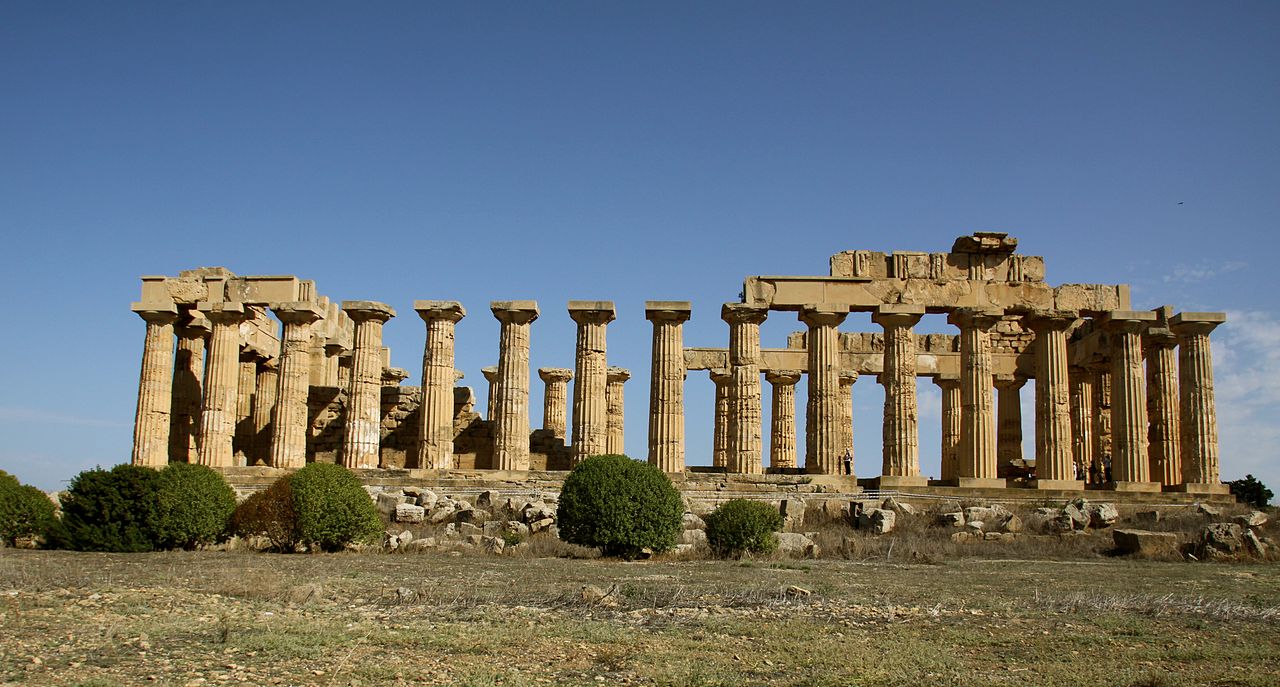
6. Temple F
Also very interesting is Temple F, a building of mature Archaic age that scholars believe may have been dedicated to Athena, Heracles, or Dionysus. What is certain is that this corner of the acropolis also retains a unique charm that can enrapture the visitor with echoes of the past. It is from here that two splendid fragments of metopes depicting episodes of the gigantomachy originate and are, like so many other finds unearthed in the archaeological area of Selinunte, preserved at the Salinas Museum in Palermo. Based on reconstructions and studies conducted on the entire area, researchers think that in Temple F an attempt was made to fit the narrow and long scheme of the traditional plan into a rectangle with less elongated proportions, a solution that resulted in an irregularity between the inner row of columns on the east side and the front of the cella. Later, the space between the columns of the peristasis was enclosed with transennas, more than a man’s height. Perhaps a security measure to achieve greater secrecy in the conduct of the cults.
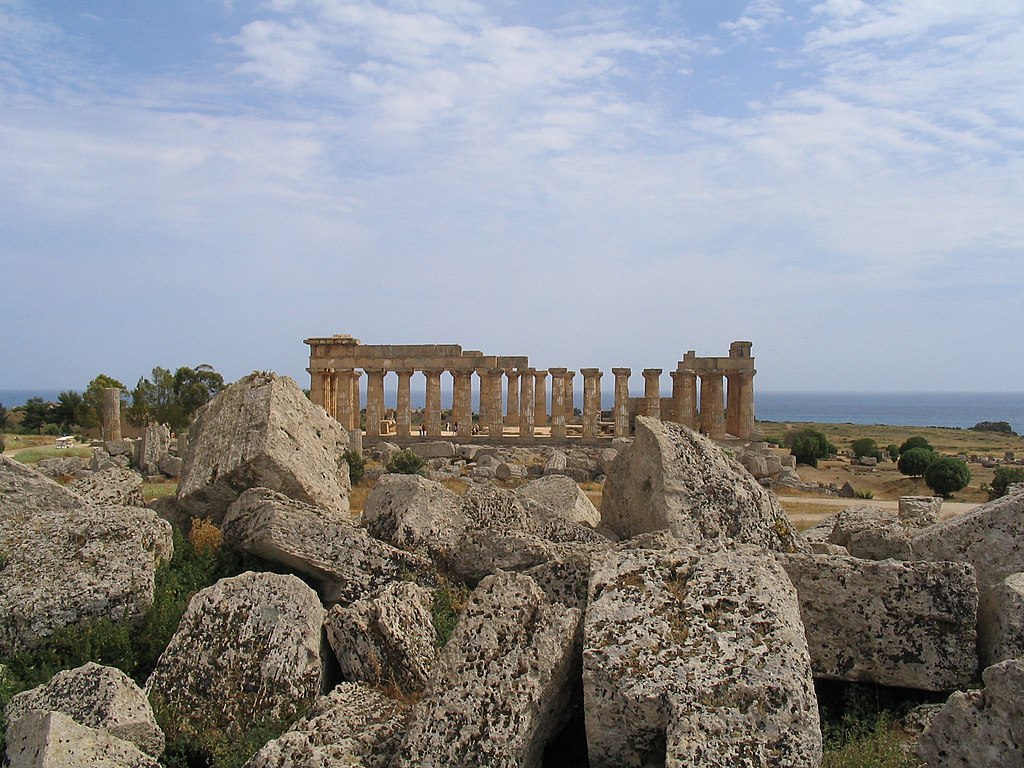
7. Temple G
Selinunte’s gitante: Temple G, also known as Olympieion, is one of the largest Doric sanctuaries in the Greek world. It owes the name Olympieion to the important inscription, better known as the Selinuntine Table, found in 1871 in the temple’s opisthodomos and now preserved at the Salinas Archaeological Museum in Palermo. This temple measured like a soccer field: it was 50 meters wide and 110 meters long with eight columns on the short sides and seventeen on the sides. Two rows of columns divided the cella into three naves culminating in a small temple where the cult statue was kept. Today, the colossal column known as the “Spindle of the Old Woman” emerges from the immense ruins of the building. The highly differentiated architectural forms of the temple, especially of the capitals hint at the long period of construction of the building, which is estimated to span about seventy-five years. Although many details were never completed, the temple appears to have been in use from at least the mid-5th century B.C. although researchers are still dubious about the destination of some sixty large column blocks planned for the temple but remaining in the Cave of Cusa.
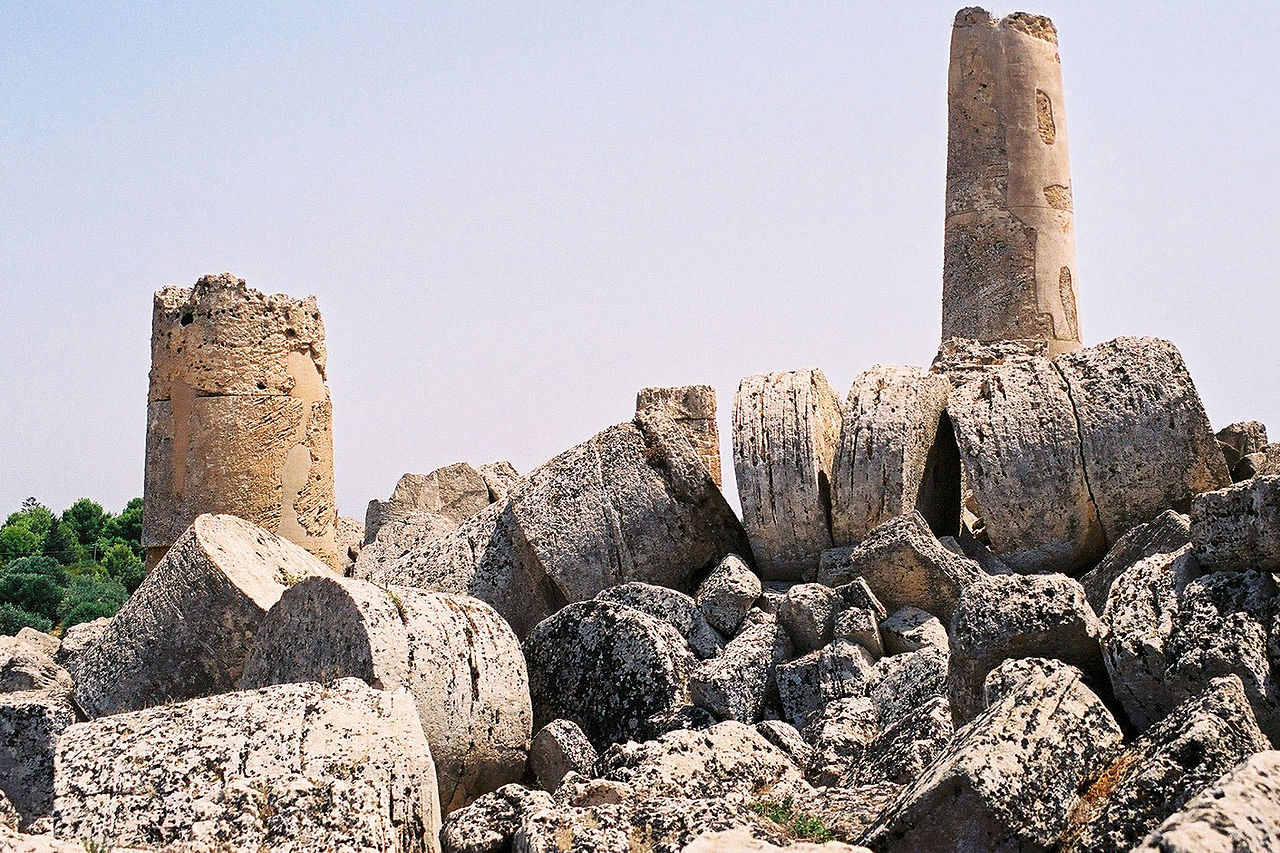
8. Sanctuary of Malophoros
One of the most fascinatingly endowed sites in the entire archaeological area of Selinunte is surely the extensive sanctuary of Malophoros in Contrada Gàggera. This demarcates, along with Temple M and the megaron of Hera to the south, the western limit of the city beyond the Modion River. The inner space of the sanctuary was divided into two large sacred areas. The larger and more important area, defined on three sides by high enclosure walls, was accessed through a monumental entrance. In contrast, a portico extended to the north d and a sacred enclosure to the south. The megaron of Malophoros was divided inside into three compartments while the chest altar held many of the archaic votive offer ings. A water channel, connected to the Gàggera spring, ran from north to south through the entire sanctuary, even beyond the surrounding walls. Then there was an area dedicated to Zeus Meilichios where the remains of two porticoes are still preserved.
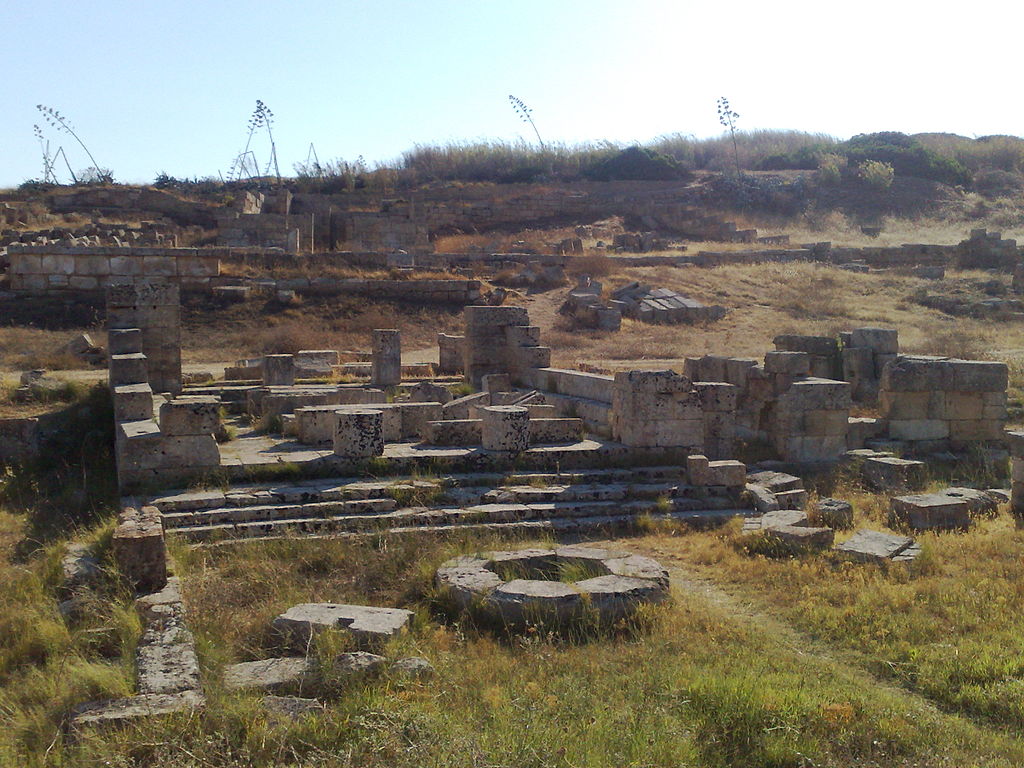
9. Necropolises
There are several necropolis located within the archaeological area of Selinunte. The most important was within the Acropolis, on the Manuzza Plateau, another was instead found north of the temples on the eastern hill in the so-called contrada Buffa, and to these are added a third in the area of the contrada Galera Bagliazzo and a fourth west of the Modione River further ahead of the sanctuary of Malaphóros, in the contrada Manicalunga Timpone. Numerous tombs have been found in all of these, from which come thousands of objects, mainly earthenware vases and figurines, which served to protect and accompany the deceased on their journey to the afterlife. Especially interesting is what has been found on the Manuzza plateau, a large area in which the 580 B.C. orthogonal-type urban layout constitutes one of the most interesting examples of colonial planning of the Archaic period.
10. Cave of Cusa
About 11 kilometers from the archaeological area of Selinunte lie, materially, the origins of the city. The Quarries of Cusa were the main quarrying site for the stones used in the construction of Selinunte’s buildings and temples. The rock of the Quarries of Cusa, which is very compact, was used from the first half of the 6th century B.C.E., only to be abandoned when mining was still in full swing, as evidenced by the column blocks being formed or already extracted for the construction of Temple G, at the time of the advance of Hannibal’s army in 409 B.C.E. Today their appearance is characterized by a long rock wall of extraction about 8 meters high that can be followed for about 1,700, while the current name and refers to Baron Cusa, former owner of the area. In the 16th century they were, however, known by the Arabic name of Ramuxara. The Selinuntines also obtained building stone from other quarries. Some of them, such as those located along the slopes of Manuzza, are within the city; others, such as the Barone Quarries, are about 4 kilometers north of Selinunte. Further afield are those at Misilbesi near Menfi, exploited mainly for sculpture work. From the Cave of Cusa the pieces Pieces were transported along a rocky road nine to ten meters wide that is no longer visible today.
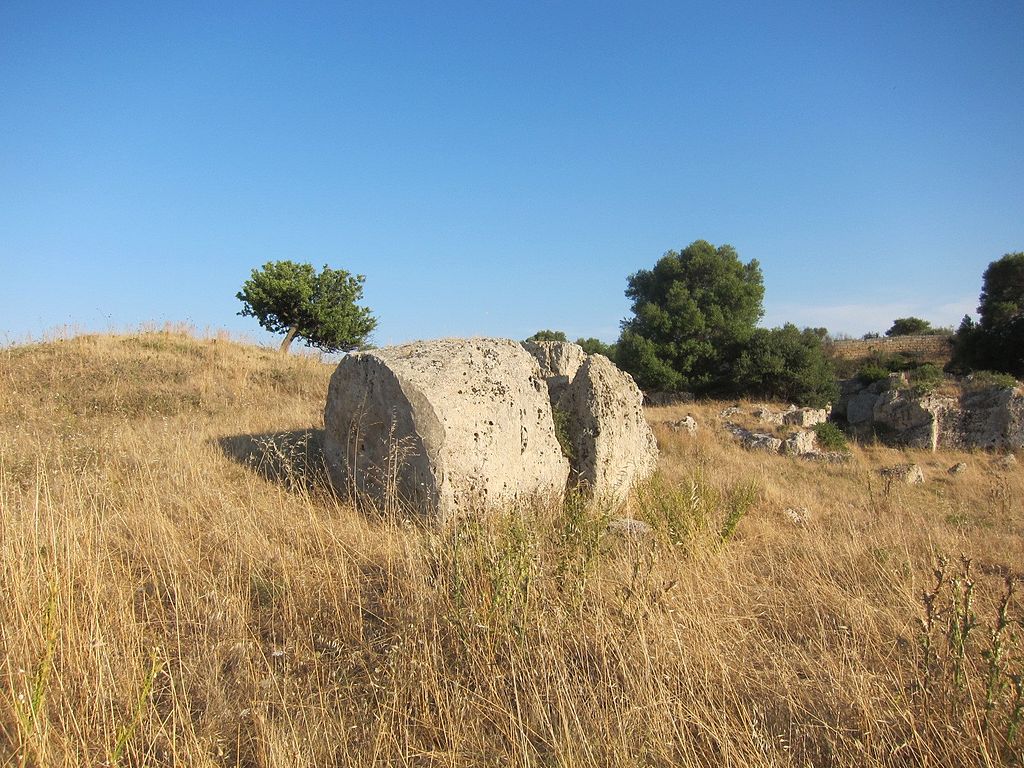
11. Manuzza plateau
Manuzza Hill was the area on which some of the first settlers settled. The linearity of the land and its vastness induced the settlers to choose as the site of settlement this area close to the Acropolis, to which it was adequately connected. Those same settlers divided the area into bands while the concrete boundary between urban space, necropolis and countryside was fixed later with the construction of the defense walls. From its origins, however, the urban layout of the plateau was characterized as a body that linked the Acropolis with the villages on its sides and the eastern hill. With the development of monumental buildings and great religious architecture, the landscape underwent a radical transformation: from a settlement with a rural character, it changed to an articulated urban landscape. In the center of the city, between the southern and northern districts, a large area was spared for the construction of the agora, a large square reserved for the public life of the city. All major roads converged on the square, and a funerary monument dedicated to the city’s founder was built almost in its center.
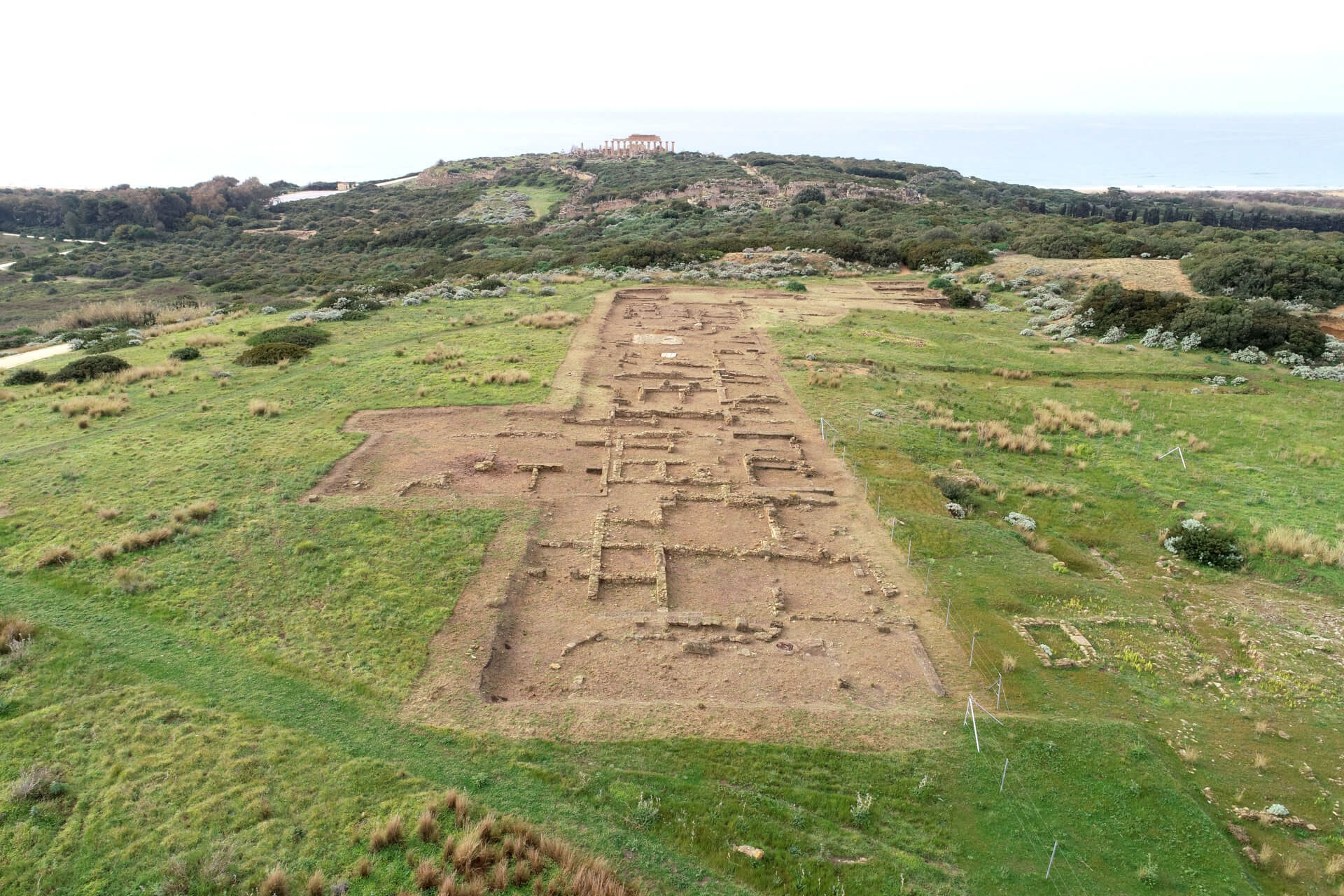
Warning: the translation into English of the original Italian article was created using automatic tools. We undertake to review all articles, but we do not guarantee the total absence of inaccuracies in the translation due to the program. You can find the original by clicking on the ITA button. If you find any mistake, please contact us .

Most read of the month


- Agrigento town
- Valley of Temples - Valle dei Templi
- Scala dei turchi
- Phaiax' underground water system
- Cefalù town
- Cefalù Cathedral
- La Rocca di Cefalù
- Aleister Crowley
- Museo Mandralisca, Cefalù
- More photos from Cefalù
- Monreale Cloister
- Monreale Cathedral
- Noto Antica
- Hotels in Noto
- Palermo city
- Archeological Museum, Palermo
- Capuchin Catacombs
- Fontana Pretoria
- La Martorana (Santa Maria dell'Ammiraglio)
- Museum of the Holy Inquisition
- The Norman Palace
- The Palatine Chapel
- Palazzo Abatellis (Galleria Regionale)
- The Palermo Cathedral
- San Cataldo
- San Giorgio dei Genovesi
- San Giovanni degli Eremiti
- Oratorio del Rosario di Santa Cita
- Oratorio del SS. Rosario di San Domenico
- Santa Maria della Catena
- Santa Maria dello Spasimo
- Church of the Gesù
- Quattro Canti
- Botanical Garden
- Villa Palagonia
- Street art in Palermo
- Ragusa town
- Hotels in Ragusa
- Siracusa / Syracuse
- The Siracusia Ship
- The Cathedral
- The Archeological Park in Siracusa
- The Roman Amphitheatre
- The Greek Theatre in Taormina
- Taormina town
- Isola Bella
- Baron von Gloeden
- Trapani town
- Grotta Mangiapane (Scurati)
- Hotels in Trapani
- Palazzo Adriano
- Castelbuono
- Linguaglossa
- Termini Imerese
- Agrigento: The Valley of Temples
- Siracusa: Archeological Park
- Halaesa Arconidea
- Villa Romana del Casale
- The Roman Amphitheatre in Syracuse
- The Archeological Park in Syracuse
- Greeks in Sicily
- The Sicilian Baroque
- Villa Palagonia - film location
- More photos: Villa Palagonia
- The Duomo in Siracusa
- Giacomo Serpotta
- Oratorio di San Lorenzo
- Street art in Sicily
- Normans in Sicily
- Arabs in Sicily
- People in Sicily
- Life in Sicily
- Death in Sicily
- Crucifixes in Sicily
- Film locations in Sicily
- The White Lotus S2 locations in Sicily
- Cars in Sicily
- Churches in Sicily
- Easter in Sicily
- Food in Sicily
- Arancini / arancine
- Weddings in Sicily
- Cats in Italy
- Birds in Sicily
- Column capitals in Sicily
- Insects in Sicily
- Lizards in Sicily
- Tuna Fishing
- Wagner in Sicily
- The contributors
- Sources and recommended reading
- Off topic: New York
- Off topic: Napoli
- Off topic: London
- Off topic: Ravenna
- Web Statistics 2016
Selinunte Archeological Park
All photos unless otherwise stated: Per-Erik Skramstad © Wondersofsicily.com
The ruins of the Ancient Greek town of Selinunte is one of the most important and impressive Classical sites in Sicily. It is the largest archeological park in Europe.
Selinunte - Selinous for the Greeks, Selinus for the Romans
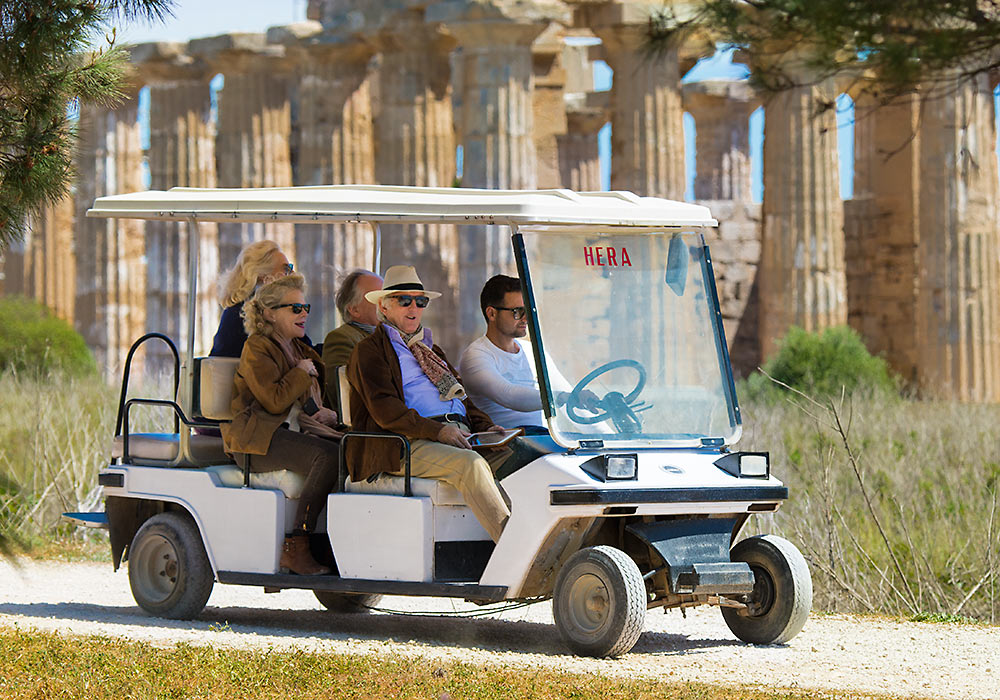
In 414 BC hostilities flared up between Selinus (Selinunte) and Segesta . Since Segesta didn't get any help from Akragas (Agrigento), they went to to Athens during the winter 416/415 to beg for help. The Athenian expedition in Sicily (415-413 BC), however, was a complete disaster for Greece. Later Segesta asked Carthage for help, leading to the total destruction of Selinus by the hands of Carthage.
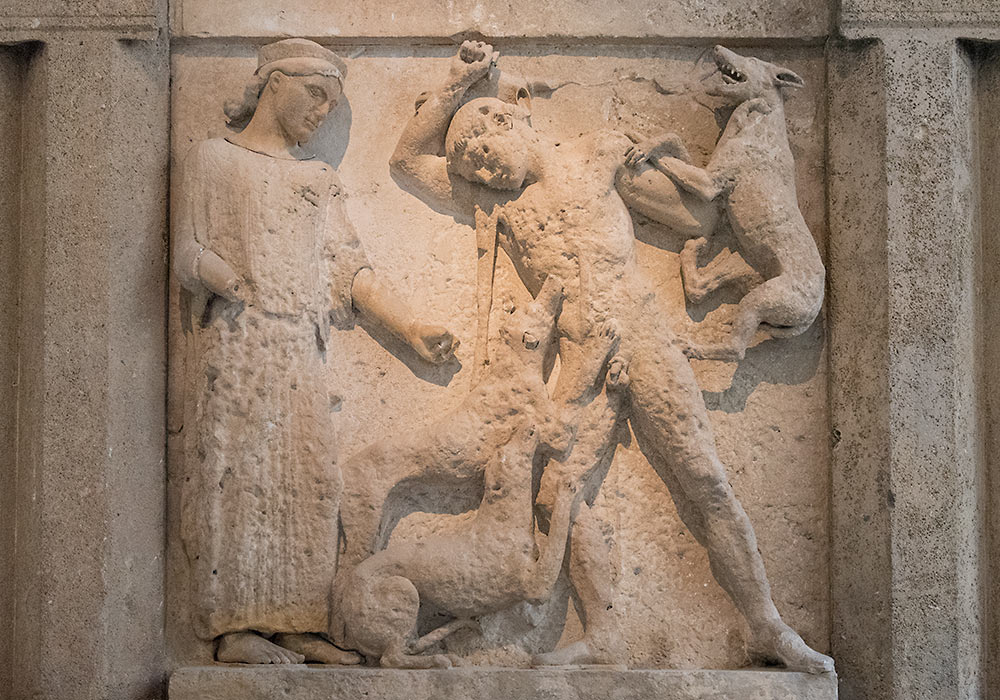
Actaeon punished for having seen Artemis, the goddess of hunting, naked. Selinunte, Temple E, 460-450 BC. Limestone and marble. Archeological Museum, Palermo .
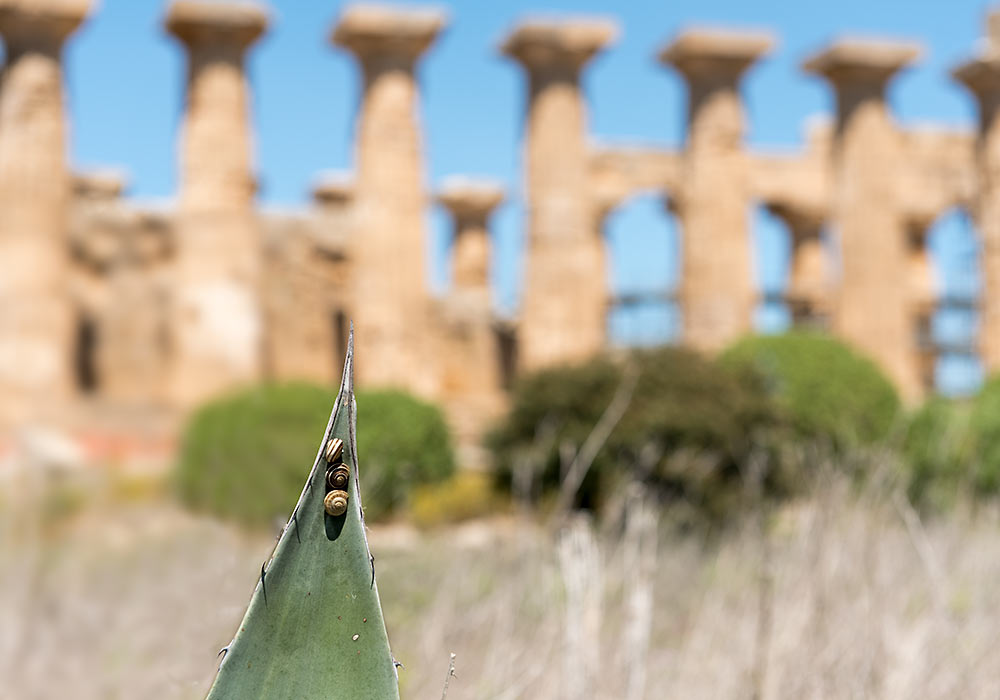
Selinunte was early brought into contact and collision with the Carthaginians and the native Sicilians in the west and northwest of the island. As early as 580 BC the Selinuntines were engaged in hostilities with the people of Segesta, and disputes and hostilities seem to have been of frequent occurrence between Segesta and Selinunte.
After a ten-day siege in 409 BC, Selinunte was taken by the Carthaginians and Segesta. According to sources, 16,000 citizens of Selinunte were slain, 5,000 made prisoners, and 2,600 under the command of Empedion escaped to Agrigentum (Agrigento).
During the First Punic War we again find Selinunte subject to Carthage, and its territory was repeatedly the theater of military operations between the contending powers. But before the close of the war (about 250 BCE), when the Carthaginians were beginning to contract their operations, and confine themselves to the defense of as few points as possible, they removed all the inhabitants of Selinunte to Lilybaeum and destroyed the city.
Votive bust from Selinunte. 5th century BC, now in the Archeological Museum, Palermo.
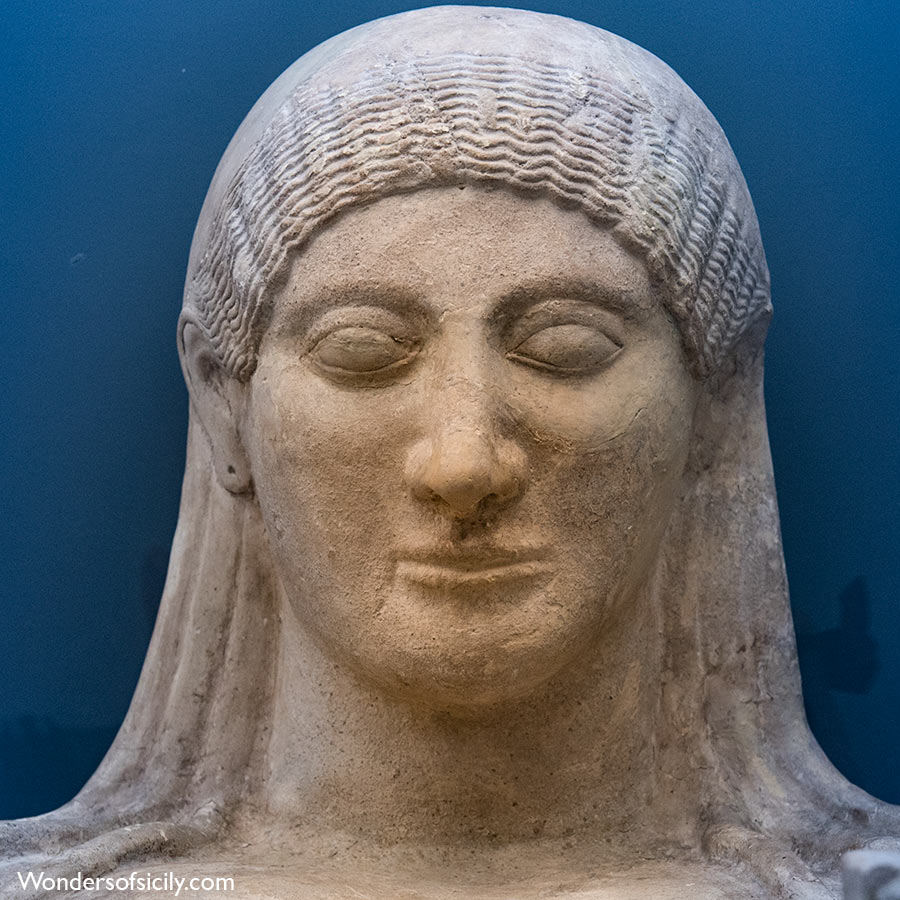
Source: Roma Numismatics Ltd (with permission)
The name Selinunte is derived from Ancient Greek selinon – wild parsley that grew on the spot. For the same reason, they adopted the parsley leaf as the symbol on their coins.
Description: Sicily, Selinos AR Litra. Circa 530-500 BC. Selinon leaf / Selinon leaf in incuse circle. SNG ANS 687. 0.72g, 10mm, 5h. Very Fine. Rare. From the Mark Christenson Collection
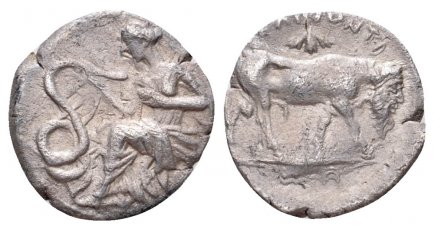
Description: Sicily, Selinos AR Litra. Circa 410 BC. Nymph seated left on rock, right hand raised above her head, extending her left hand to touch coiled serpent before her / Man-headed bull standing right; selinon leaf above, ΣEΛINONTION around. SNG ANS -; SNG Copenhagen -; SNG Lloyd 1270. 0.72g, 12mm, 10h. About Very Fine. From the Mark Christenson Collection; Ex ACR 3, 31 May 2011, lot 67.
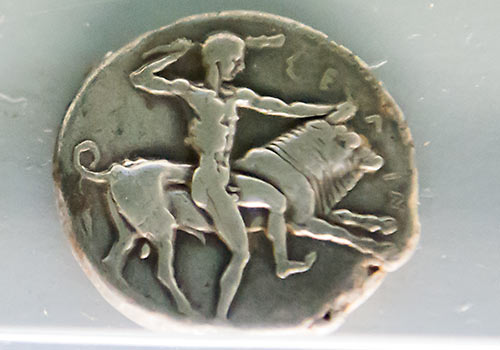
Coin from Selinunte. (Mandralisca Museum, Cefalù) Photo: Per-Erik Skramstad / Wonders of Sicily
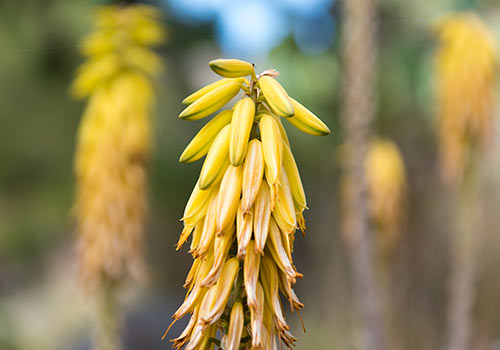
Click here for photos of plant life in Sicily . Photo: Per-Erik Skramstad / Wonders of Sicily
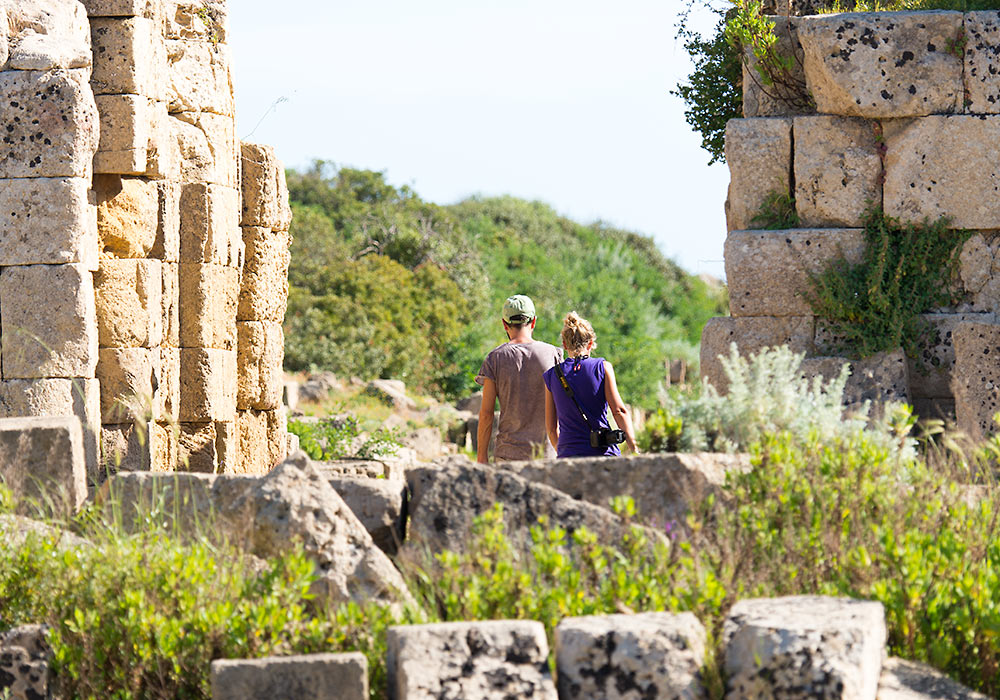
Young and old at Selinunte Archeological Park.
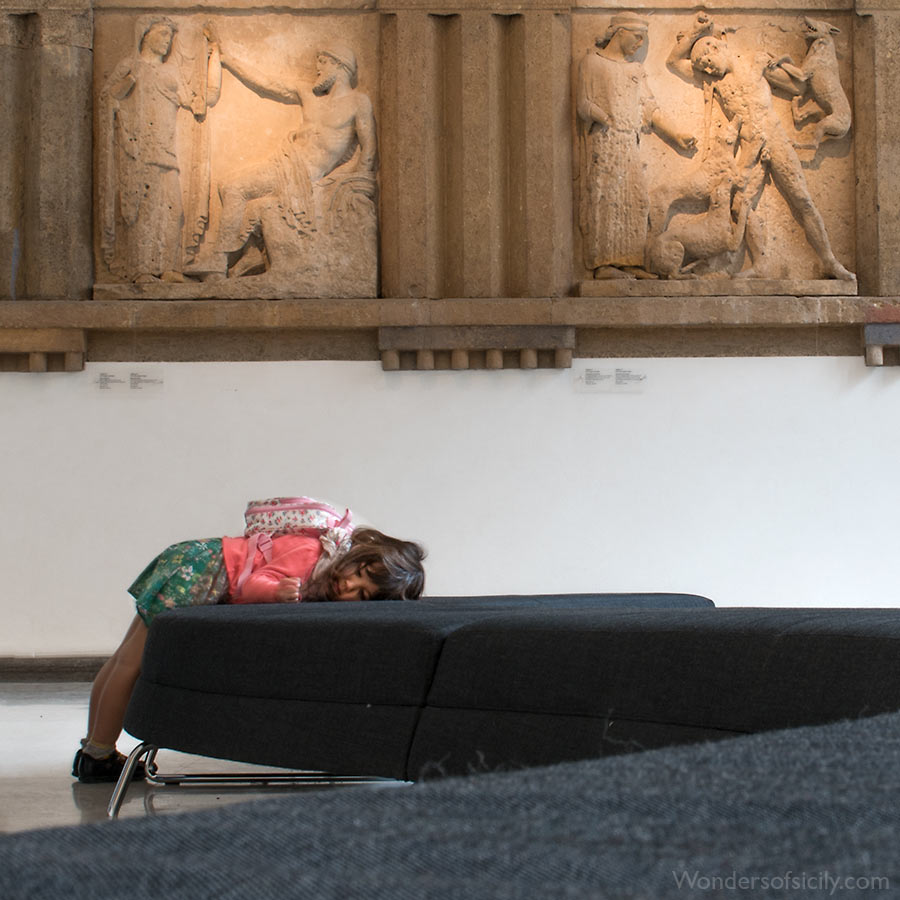
Boooooring...
The metopes in the background are from Temple E in Selinunte, now in the Archeological Museum in Palermo.
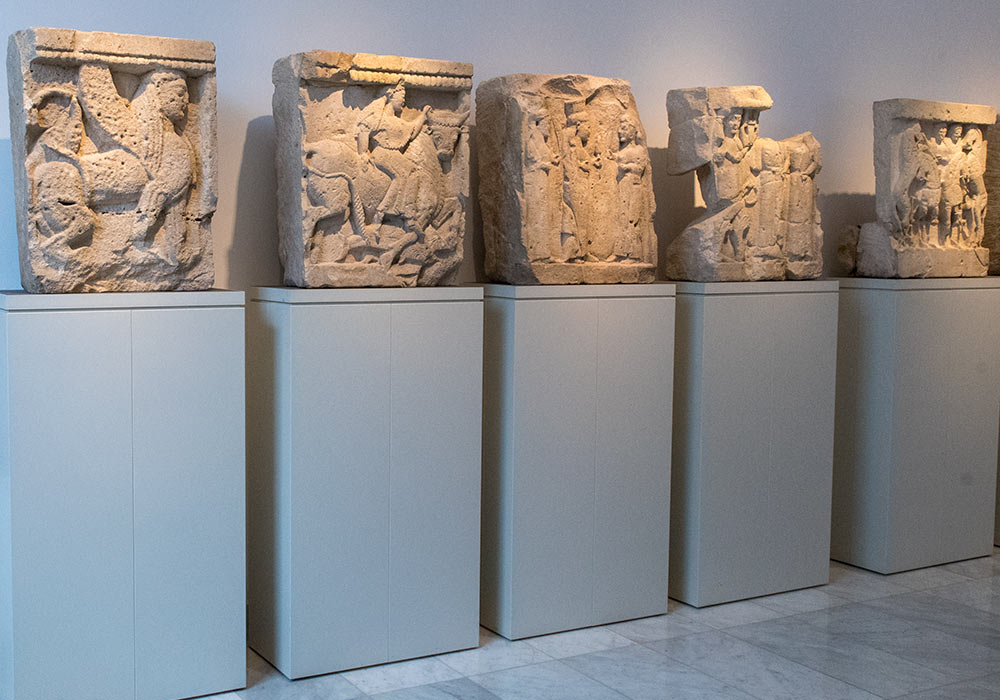
The small metopes. Selinunte, 560-550 BC.
Video: The Best of Sicily by Rick Steves
Spectacular view of Selinunte from helicopter. According to Thucydides , Selinunte was founded by the Greek colony Megara Hyblaea (near Augusta).
It was actually not before the 16th century that Selinunte was rediscovered. More systematic excavations began in 1809 (fruitless) and in 1822 (by William Harris and Samuel Angell).
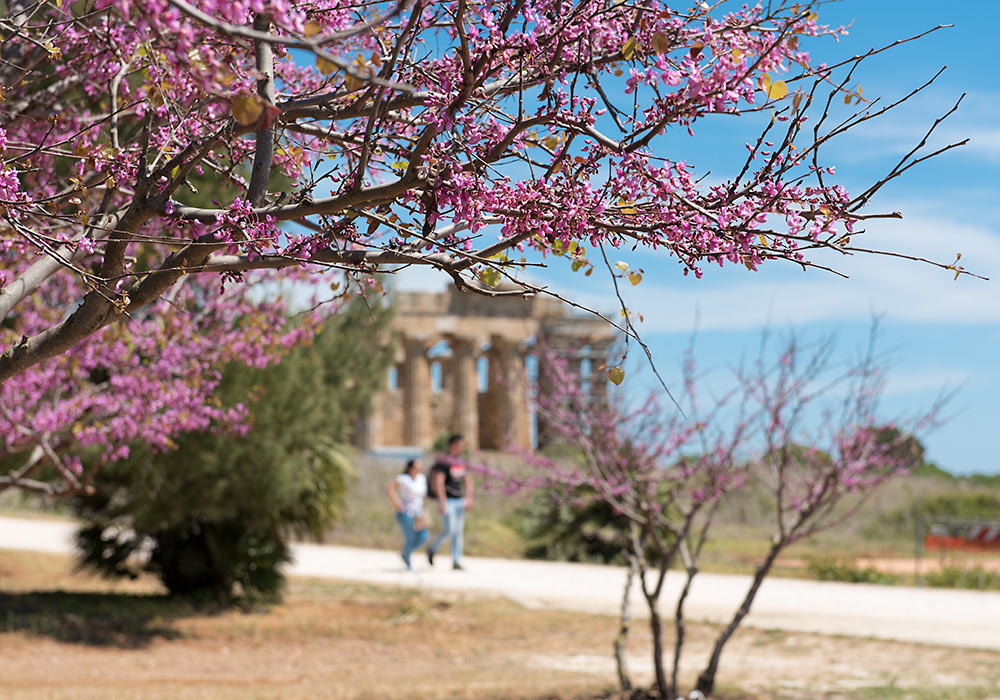
Columns at Selinunte Archeological Park.
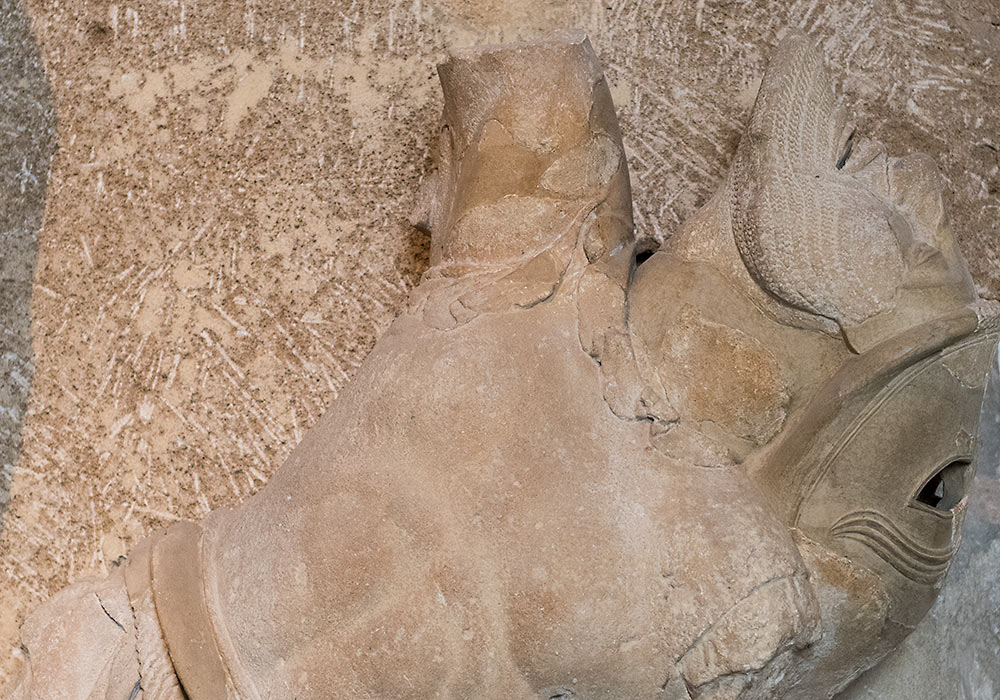
Selinunte, Temple F (490-480BC): Fragment of a metope showing a dead giant. Archeological Museum, Palermo.
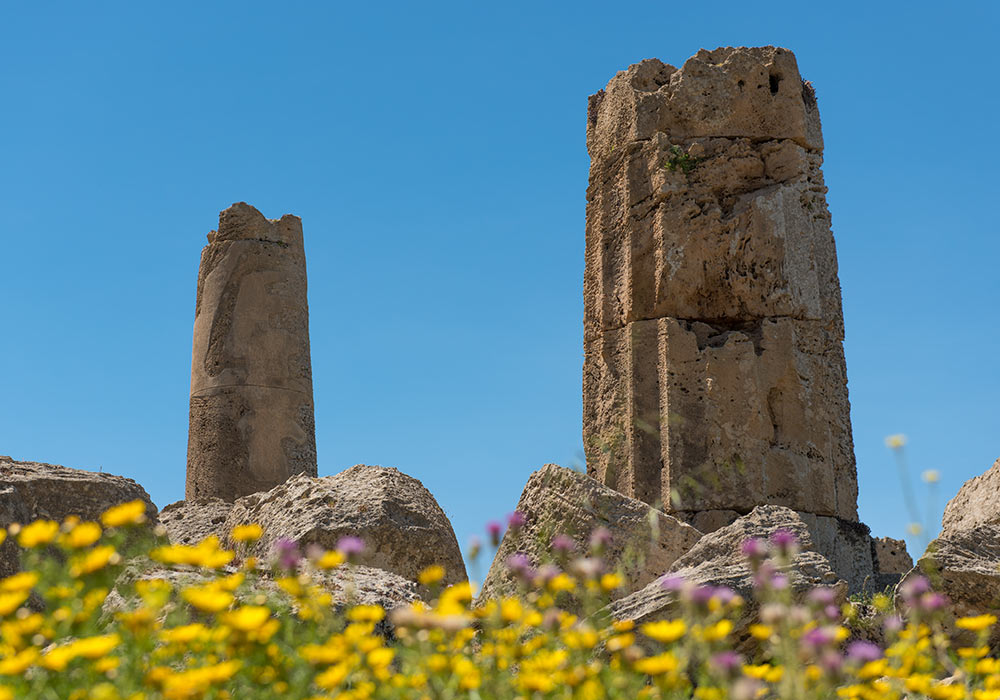
Ruins at Selinunte.
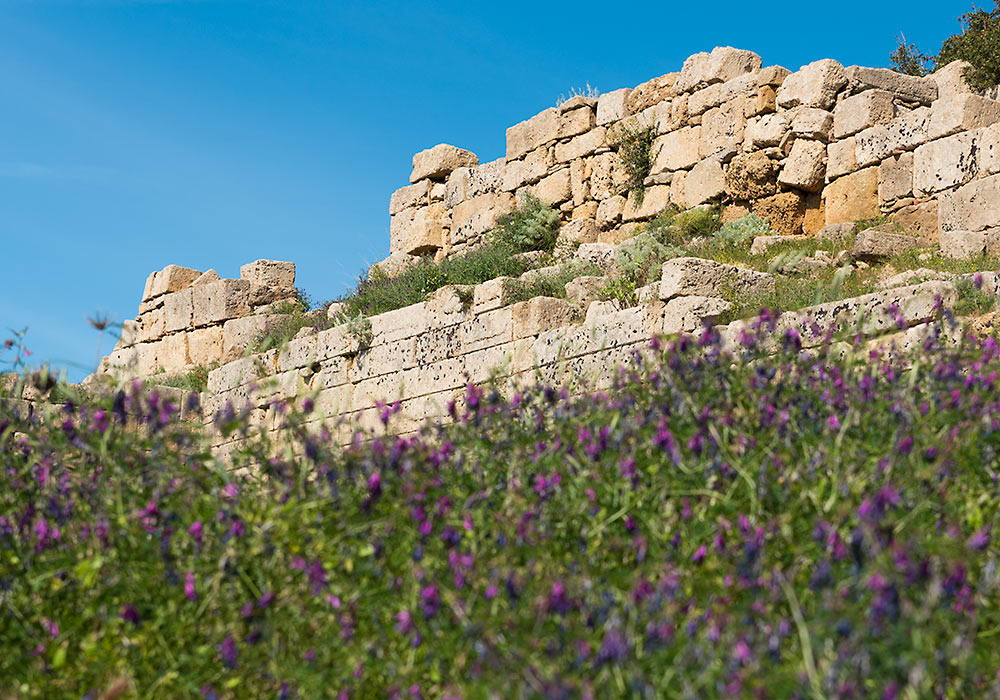
The Doric Temple E (490-480 BC) at Selinunte was probably dedicated to Hera. The columns were re-erected in 1958 after having been toppled by an earthquake.
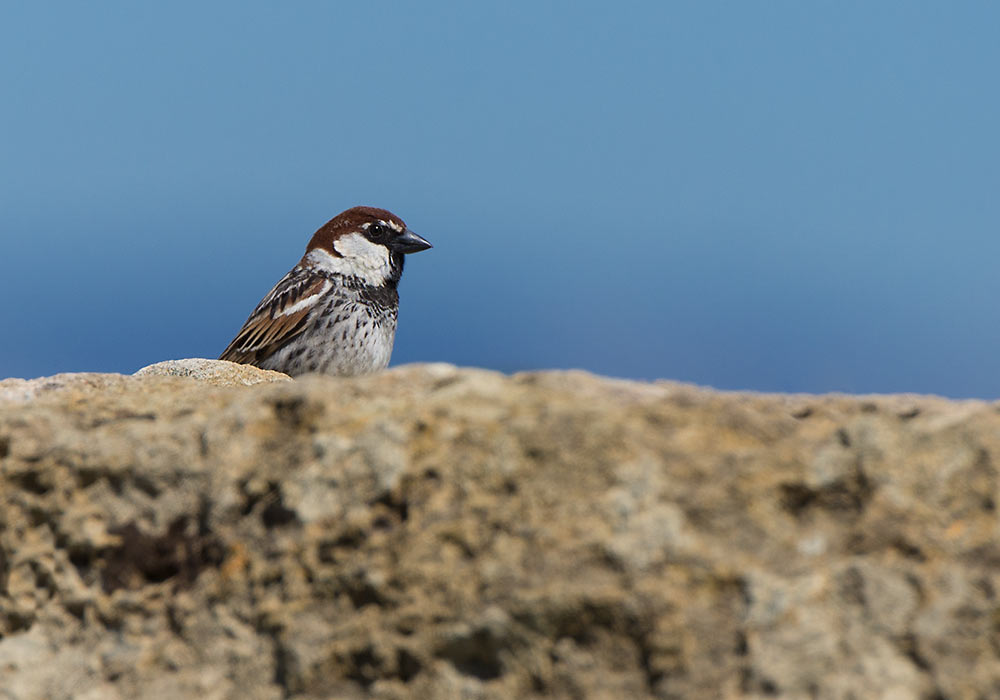
Selinunte, Sicily: Temple E. The columne were re-erected in 1958. The temple was built 490-480 BC. Four of the metopes can be seen in Palermo's archeological museum. Some 70 years later it is estimated that the city had 30.000 inhabitants. The archaeological site contains five temples centered on an acropolis. Of the five temples, only the Temple of Hera, also known as "Temple E", has been re-erected. Photo: AdiJapan / Wikipedia CC BY-SA 3.0
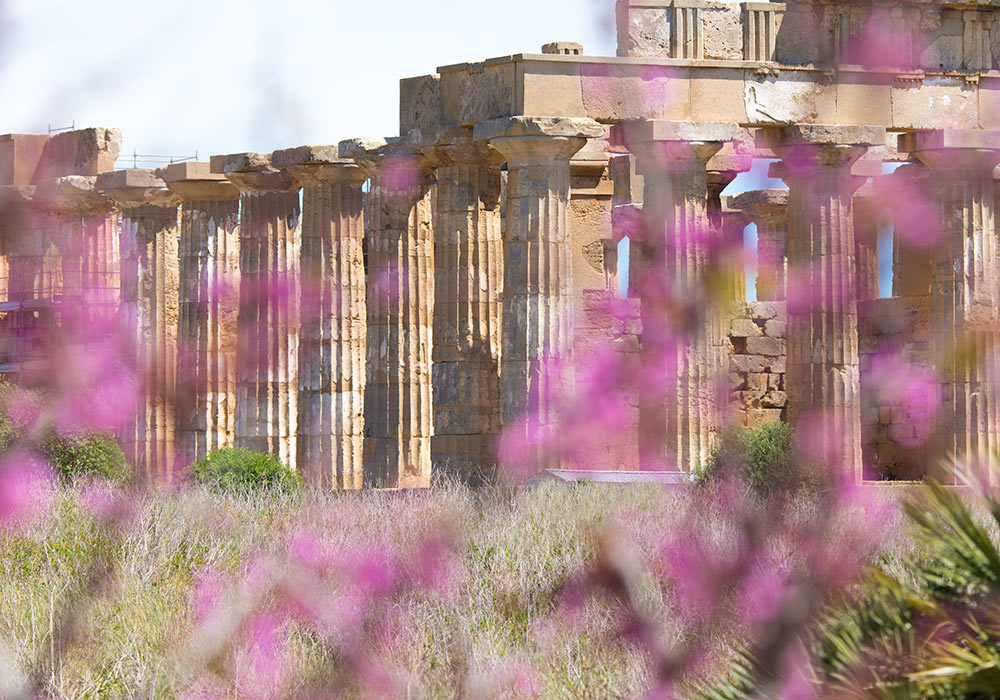
Selinunte, Temple E.
The Italian chef Giorgio Locatelli tells of his soft spot for Sicily: "The most famous archaeological site is the Valley of Temples in Agrigento , but I love Selinunte , further up the coast. The landscape is wilder there. I walk from the beach up and around the remains of the acropolis, necropolis and old market, all from about 650BC. The view is incredible and you can feel the presence of the ancient Greeks ." Read more in The Guardian
Wonderful Sicily
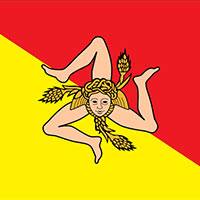
Palermo - Taormina - Cefalù - Syracuse - Agrigento - Catania - Enna - Noto - Modica
Sicilian Sites on UNESCO's World Heritage List
Web Statistics for Wondersofsicily.com
Do you see any errors or have any suggestions, please write to the editor …
© Per-Erik Skramstad / The Wonders of Sicily LinkedIn -
About The Wonders of Sicily
Developed by Webkommunikasjon
All photographs © Per-Erik Skramstad unless otherwise stated

- Places and cities
- Attractions
- Map of museums and parks
- LIVING SICILY
- Itineraries
- Travel proposals
- How to reach Sicily
- Tourist information
ARCHAEOLOGICAL PARKS OF SEGESTA, SELINUNTE E LILIBEO (TRAPANI)
Do you want to take a stroll surrounded by the most unspoilt nature or by the open sea? In Sicily, there are 14 archaeological parks. They are all different, showing finds of all types and from all eras. Following this route, we’ll explore the three archaeological sites in the Trapani area . It will be a discovery journey of ancient and various Mediterranean cultures.
Let’s start with the archaeological park of Segesta . We are in the same name archaeological area, in Contrada Barbaro, in Calatafimi . Segesta most ancients dwellings date back to VI sec. B.C. The town had a long time of prosperity. Its history extended to the Byzantine era, then the Muslim era (there is a village with a Mosque), and the Norman-Swabian era( a settlement with a castle at the top).
The Temple has a stunning scenic impact. It has a Sicilian Doric style. The structure remained unfinished, maybe due to a series of events dating back to the end of the V century (according to other experts, it was built right like that because dedicated to a not-Greek cult). The Theater is very well known too. It dates back to the second half of the II century B.C. In this era, the town was already under Roman hegemony. The structure has 63 meters in diameter and was restored several times in the 19th century.
Let’s move now towards another point of the park: the Mokarta archaeological area . It is in the homonymous district, in Salemi. The place represents one of the most important prehistoric remains in Sicily. It is a village set on the top of Mokarta Hill. It dates back to the Bronze era (XIII-XI sec. a. C.). It is made up of some circular plan huts with a double entrance. On the slopes of the hill, there’s a wide necropolis with tombs carved into the rocks.
The park includes the Archaeological area of San Miceli (Contrada Vado, Salemi). The place and its Basilica represent one of the most interesting remains of the Early Christian period in western Sicily (IV-VI d. C.). The Monte Castellazzo archaeological area (Poggioreale) stands at an altitude of 614 mt. It is one of the most important indigenous settlements in the Belice Valley. The Entella Archaeological area is a very ancient fortress (Late Eneolithic). Its old history was influenced by the famous Tucidide work ( VI, 2) about the ethnic composition of west-Sicilian cultures. The Scurati Caves (Custonaci) are an ancient prehistoric settlement and a speleological site of worldwide importance. We can visit the Grotta Mangiapane (or “Uffizi’s Grotto”), which is 70 meters high, 13 meters wide and 50 meters deep.
We are now ready to visit the Selinunte, Cusa Caves and Pantelleria Archaeological sites . Let’s start from the Selinunte Archaeological area. It is 270 hectares wide and is one of the largest Mediterranean sites . The place reflects a sophisticated plan made by the Greeks when they founded the town. The Acropolis is the sacred area on the southern headland. Here we can see six temples (O, A, B, R, C, D) and, the town centre, is enclosed by massive fortifications walls. The Agorà is the political and social centre of the city. On the western hill, we can admire three temples (E, F, G). But we can also visit the area with the Malophoros Sanctuary, the Hera Matronale Temple, the Temple M and the Necropolis . Selinunte has a remarkable archaeological heritage. Its characteristic is a sacred, public and private architecture. But it also can boast a considerable landscape and natural heritage. But that’s not all! The park also includes the Cave di Cusa , active from the 6th century BC until the end of the city’s life. Stone was extracted from here to make the city’s works, such as the capitals and columns of the temples . The Cusa quarries are unrivalled in terms of size and incredible state of preservation, which makes it possible to analyse all phases of stone processing.
Another must-see is the Museum of the Satyr in Mazara del Vallo . The Dancing Satyr of Mazara is the Mediterranean beauty’s symbol . It is a precious bronze statue from the 4th century B.C. , belonging to the school of Praxiteles. It was found in two phases between 1997 and 1998 by the Mazara motor trawler Capitan Ciccio. The Museum also exhibits other finds from the Sicilian Channel, such as a bronze fragment of an elephant’s foot from the Hellenistic period. The selection of transport amphorae dates from Archaic to Medieval times. The last park site is the Castello Grifeo (Partanna) , one of the best-preserved fortresses in western Sicily (for other castles in the area, click here ). Today’s architecture dates back around 1400. Since 2007 it has housed the Prehistory Regional Museum of Belice .
Are you feeling dizzy? Get some rest and gather some energy for the last park in the Trapani area. Let us now visit the Archaeological Park of Lilybaeum . The centre of the park is the archaeological area of Capo Boeo . It is located on the homonym Marsala promenade. The ancient Lilybaeum extended as far as the sea, and this part still preserves part of the inhabited area. Carthage founded the city after the destruction of Mozia (397 BC). It is famous for the imposing fortifications that made it an impregnable military base . The Romans besieged it for nine years before conquering it in the Battle of the Egadi (241 BC). The battle marked the end of the First Punic War.
In a 19th-century wine establishment in the park (the “ Baglio Anselmi ”), we visit the Museo Archeologico Regionale Lilibeo di Marsala . The museum was founded in 1986 to house the wreck of the Punic vessel and explain the ancient city’s history.
We sail towards the last stage and follow in the footsteps of the ancient Punics. We arrive in Favignana . Below the present cemetery is the Grotta del Pozzo . The place is famous for a Punic inscription that deals with a funerary subject (2nd-1st century BC). The entrance to the cave is wide and, in the past, there was a large staircase. Today we can still admire a few old steps. In more recent years, a well has been dug. Actually, the cave’s name comes right from it.
Share this content!
Palermo , Trapani
Autumn , Spring , Summer
Archaeological Sicily , Art and Culture , Outdoors

Art in Sicily Traveling you learn
Writers’ itinerary
Sicily is the land of myths, evocative and magnetic, perhaps thanks to its triangular shape, perhaps thanks to its position [...]
Pantelleria – Cala Gadir
Immerse yourself in the hidden history of Cala Gadir, an enchanting natural haven that witnessed centuries of shipping and trade [...]
Marsala – Capo Boeo
The underwater itinerary takes you to the ancient port of Lilybaeum, founded by survivors of the siege of Mozia in [...]
YOU MAY ALSO BE INTERESTED
Sicily, between history and culture
Let's discover Sicily's unique and evocative locations following the tracks of this Historical and Cultural Itinerary. This guide will give [...]
Outdoors Sea in Sicily Trekking and Outdoor Villages
TINDARI (district of Patti)
Tindari is a small hamlet in Patti. It is home to one of Sicily's most worshipped Shrines. Many pilgrims arrive [...]
Outdoors Trekking and Outdoor
HORSE RIDING IN THE EREI MOUNTAINS
Would you like to discover the most hidden places in the heart of Sicily? Why not choose to enjoy the [...]
DEPARTMENT OF TOURISM, SPORT AND ENTERTAINMENT – SICILY
Via Notarbartolo, 9 – 90141 – Palermo
Tourist Informations
This website is not for profit, anyone who sees a possible infringement of copyright can report it and we will promptly remove the specific content.
VISIT SICILY
ACCESSIBILITY
- Toggle High Contrast
- Toggle Font size
© 2022 Regione Siciliana – All rights reserved
VAT number: 02711070827 – Tax Code: 80012000826 – Privacy
DATA PROCESSING
Privacy preview.
Got a question? Text us on Whatsapp
+1 617 404 2125
- Tours in Sicily
Sicily Attractions
Attractions details, find it on google maps.
5 stars 4 stars 3 stars 2 stars 1 star 0.00/5 - (0 Votes) Ambra Local tour guide "To truly appreciate the ancient grandeur of Selinunte in Sicily, visit during the golden hour just before sunset; the soft lighting not only makes for incredible photos but also highlights the majesty of the ruins in a way noon's harsh light can't match. Also, check out the less frequented eastern part of the park, where the Temple of Hera stands— it's often missed by tourists but offers a more tranquil and intimate experience with the history of the place."
What is Selinunte?
Selinunte is an ancient Greek archaeological site situated on the southwestern coast of Sicily, Italy. Named after the wild celery that once adorned its landscape, Selinunte was one of the most important of the Greek colonies in Sicily. Today, it's a place where history tangibly intersects with the rugged Mediterranean landscape, offering visitors a chance to step back into a world of temples, ancient town layouts, and unforgettable vistas.
Our Most Popular Tour:

Naples Seaside Serenity TourEmbrace the tranquil beauty of the Neapolitan coast with our Naples Seaside Serenity Tour. Let the gentle sea breeze invigorate your...
I always find it captivating to observe the way the sun casts its warm glow over the ancient stones here, especially during the golden hours. The ruins, which include five temples centered on an acropolis, are some of the most impressive in the Mediterranean and offer a genuine peek into the magnificence of ancient Greek civilization.
Visitors to Selinunte can walk among the temple ruins, which stand as a testament to human history and architectural achievement. The site is expansive, with parts still unexcavated, which gives you a sense of discovering a piece of history for yourself.
History of Selinunte
Selinunte was founded in the 7th century BC and quickly rose to prominence due to its fertile land and strategic trading position. Throughout its history, it was often at the center of conflicts between the Greeks and the Carthaginians, and this strife ultimately led to its destruction in 409 BC, when it was sacked by the Carthaginians. The city never fully recovered from the assault and was later abandoned after several more centuries of decline.
As I walk through the remnants of this once-thriving polis, I often reflect on the bustling life that filled these streets, with merchants, soldiers, and citizens all playing their part in the fabric of Greek life. The city's layout reflects the urban planning and sophistication characteristic of Greek colonies, complete with temples, theaters, and other public buildings, some of which you can still marvel at today.
Although time has reclaimed much of Selinunte, archaeological efforts over the years have revealed much about the site's significance. Many artifacts excavated here are now displayed in museums around Sicily, serving as reminders of Selinunte's rich cultural and historical heritage.
Why is Selinunte Important?
Selinunte holds an important place not only in Sicilian history but also in the broader narrative of the ancient Mediterranean world. Its extensive and well-preserved ruins serve as a crucial reference point for understanding Hellenic architecture and urban development. The site embodies the cultural exchange between the Greeks and the native peoples of Sicily, as well as with the Carthaginians, shaping a unique historical epoch that influenced the course of Western civilization.
The temples of Selinunte, although in ruins, are some of the most striking examples of Greek temple architecture and have provided invaluable information to historians and archaeologists about ancient construction techniques and religious practices. Moreover, its downfall is a sober reminder of the fragility of human endeavors, offering rich lessons about the rise and fall of civilizations.
Beyond its historical and educational value, Selinunte’s importance also lies in its role as a gathering place for locals and travelers alike. It sparks conversations on preservation, the importance of historical memory, and the way ancient legacies shape modern identities—conversations I’ve had the privilege to partake in and witness on countless occasions.
Things to Do & See at Selinunte
Selinunte presents a wealth of experiences for visitors. One can begin at the eastern temples—some of the most completely rendered structures, where the Temple of Hera offers an especially commanding example of classical Greek architecture. Just imagine the towering columns, now partially reconstructed, as they would have stood over 2,500 years ago.
Our Top Trending Italy Tours:

Tuscany Artisan Adventures Tour
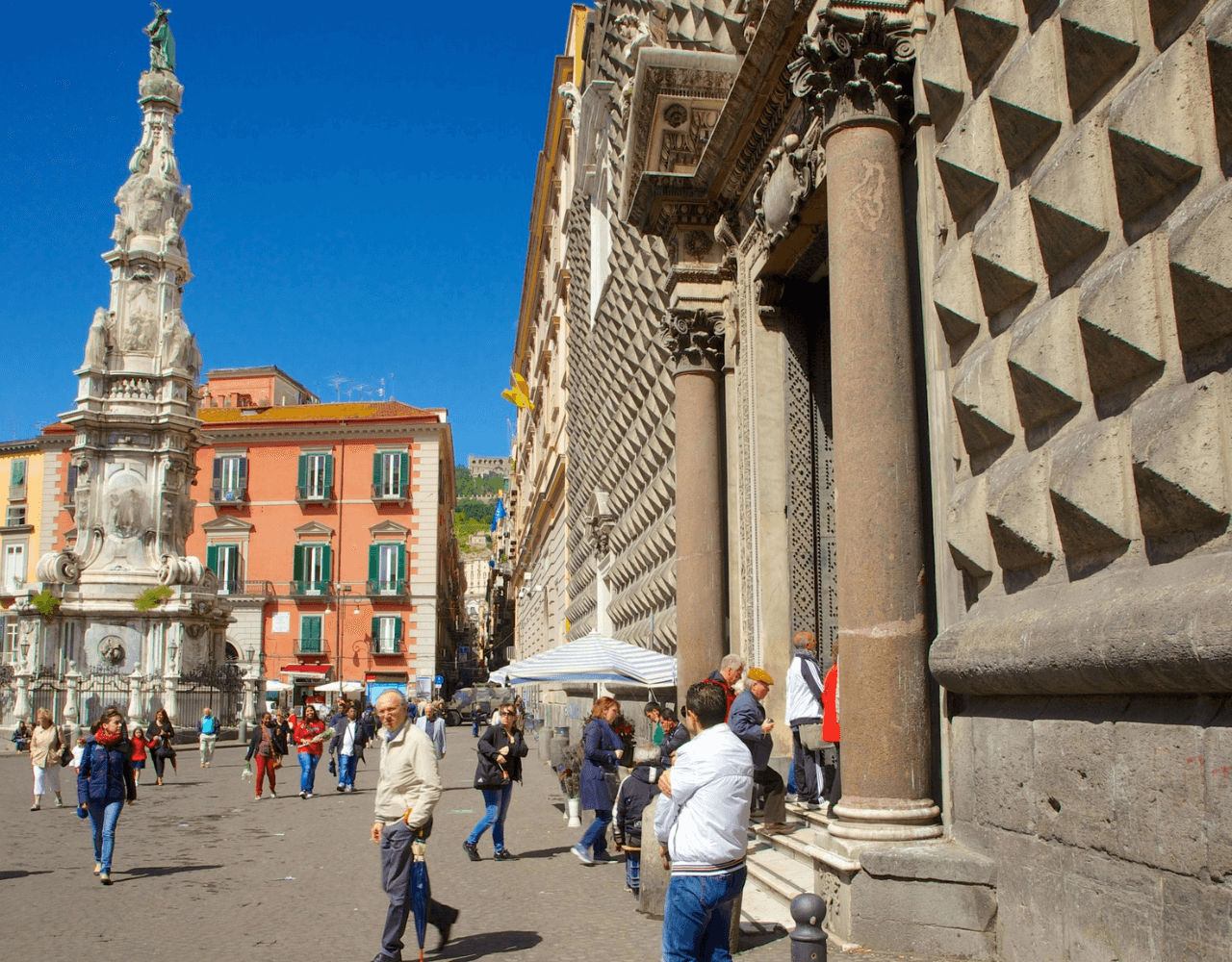
Naples Cultural Heritage Tour

Tuscany Vistas & Villages Tour
The acropolis area, with its blend of ruins, is an excellent spot to explore next. It contains the remnants of the ancient city's defensive structures, public buildings, and residential quarters. The western temples, though less intact, carry their own rustic charm, often overgrown with wildflowers in spring, creating a romantic setting unlike any other.
Additionally, venture over to the sanctuary of Malophoros, dedicated to the goddess Demeter, which provides a fascinating insight into ancient Greek religious practices. For those intrigued by the finer details, the site museum showcases many artifacts found during excavations at Selinunte. Meanwhile, the nearby nature reserve of the Belice River valley and the beaches provide a beautiful natural contrast to the archaeological marvels.
As you wander amidst the ruins, do take time to gaze upon the surrounding landscape, shaped by olive groves and the glistening Mediterranean beyond. It's a view that has graced the eyes of countless generations. With its blend of human genius and natural splendor, Selinunte offers an experience that is as culturally enriching as it is breathtaking.
Frequently asked questions
Selinunte is an ancient Greek archaeological site located on the southwestern coast of Sicily, Italy. It contains the ruins of a city that was one of the most important in the Greek world and is notable for its temples built in the Doric style.
Visitors to Selinunte can see several temples, ancient city walls, and various other structures. Some of the temples have been partially reconstructed, providing a glimpse into their original grandeur.
The best time to visit Selinunte is during the spring (April to June) or fall (September to October) when the weather is pleasant, and there are fewer tourists compared to the busy summer months.
A visit to Selinunte can take anywhere from a few hours to a full day, depending on the level of interest in exploring the extensive archaeological site and the surrounding area.
Yes, guided tours are available at Selinunte. These tours can offer visitors in-depth information about the historical and cultural significance of the site and are often recommended to fully appreciate its history.
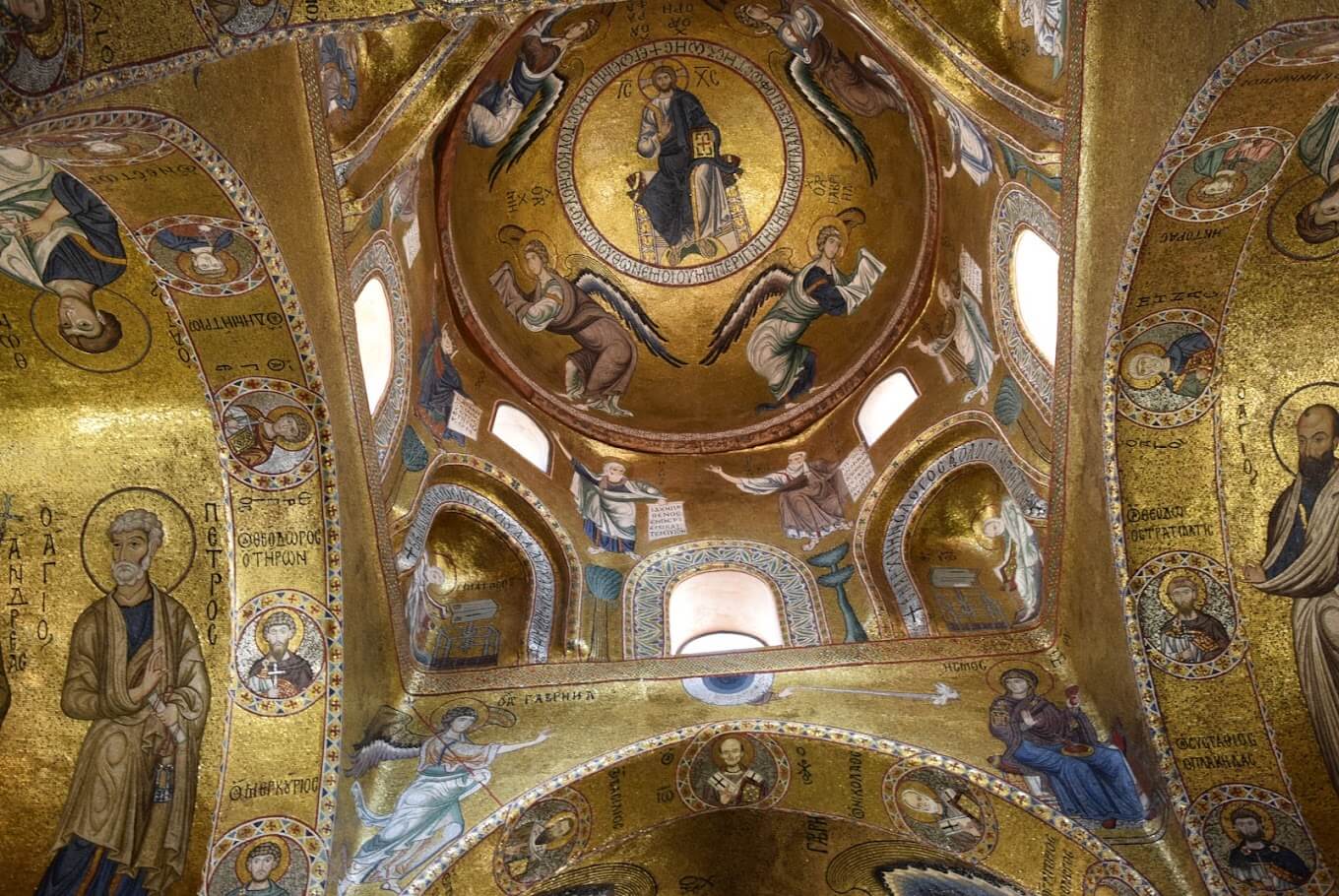
Church of St. Mary of the Admiral
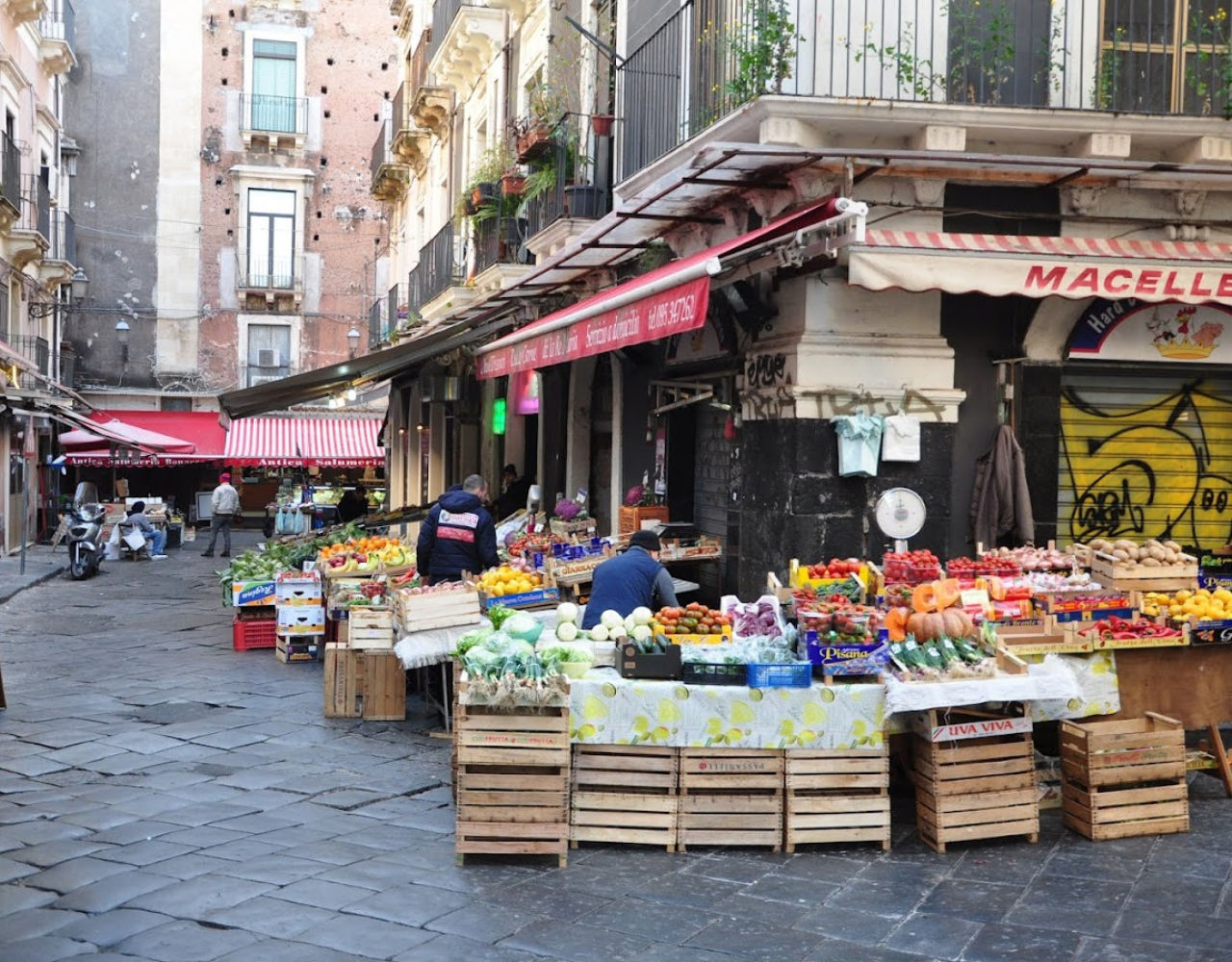
Catania Fish Market
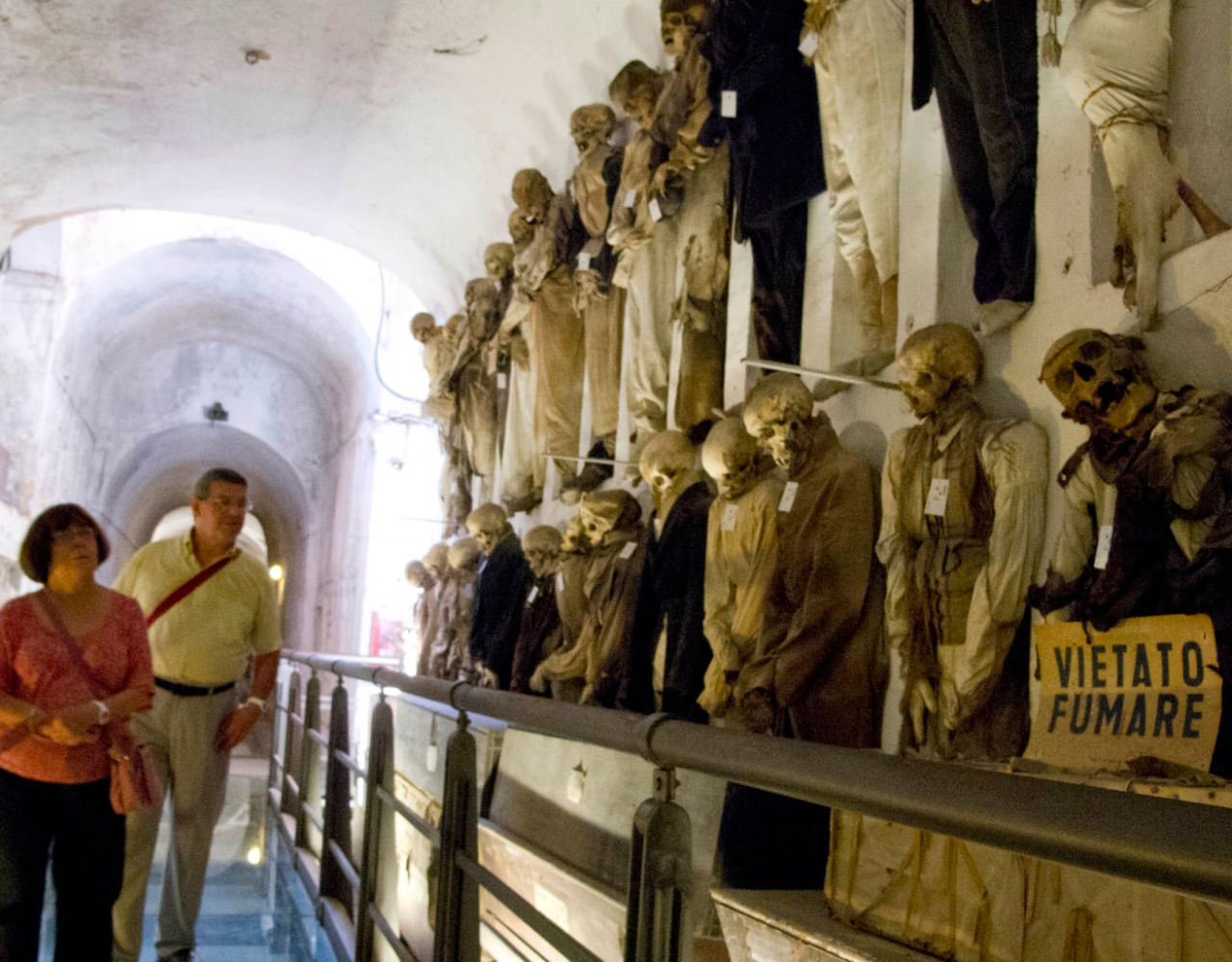
Catacombe dei Cappuccini


Selinunte Archaeological Park | Great Day in Sicily

While driving from Marsala to Sciacca in Sicily, we decided to stop at Selinunte and see the temples. It was an easy drive and signs directing you were everywhere. The ruins of the city are located in the municipality of Castelvetrano, in the southern part of the province of Trapani. Most noteworthy, Selinunte is the largest archaeological park in Europe and covers about 670 acres and 2,500 years of history.
There is one temple off in the distance by the ocean but you have pay for a little train tour (about €6). Because we were only planning on a quick visit, we decided against the tour. We were never able to find out if our photos below is of Temple A, B, C, D or O .
This post contains affiliate links that help keep this website running. By purchasing through our links, we make a small commission at no extra charge to you. Thank you for your support!
It is an easy walk around the park but you can pay for an electric car (golf cart) if you choose. Also, I would suggest you allow at least two hours to walk the entire park and visit the museum.
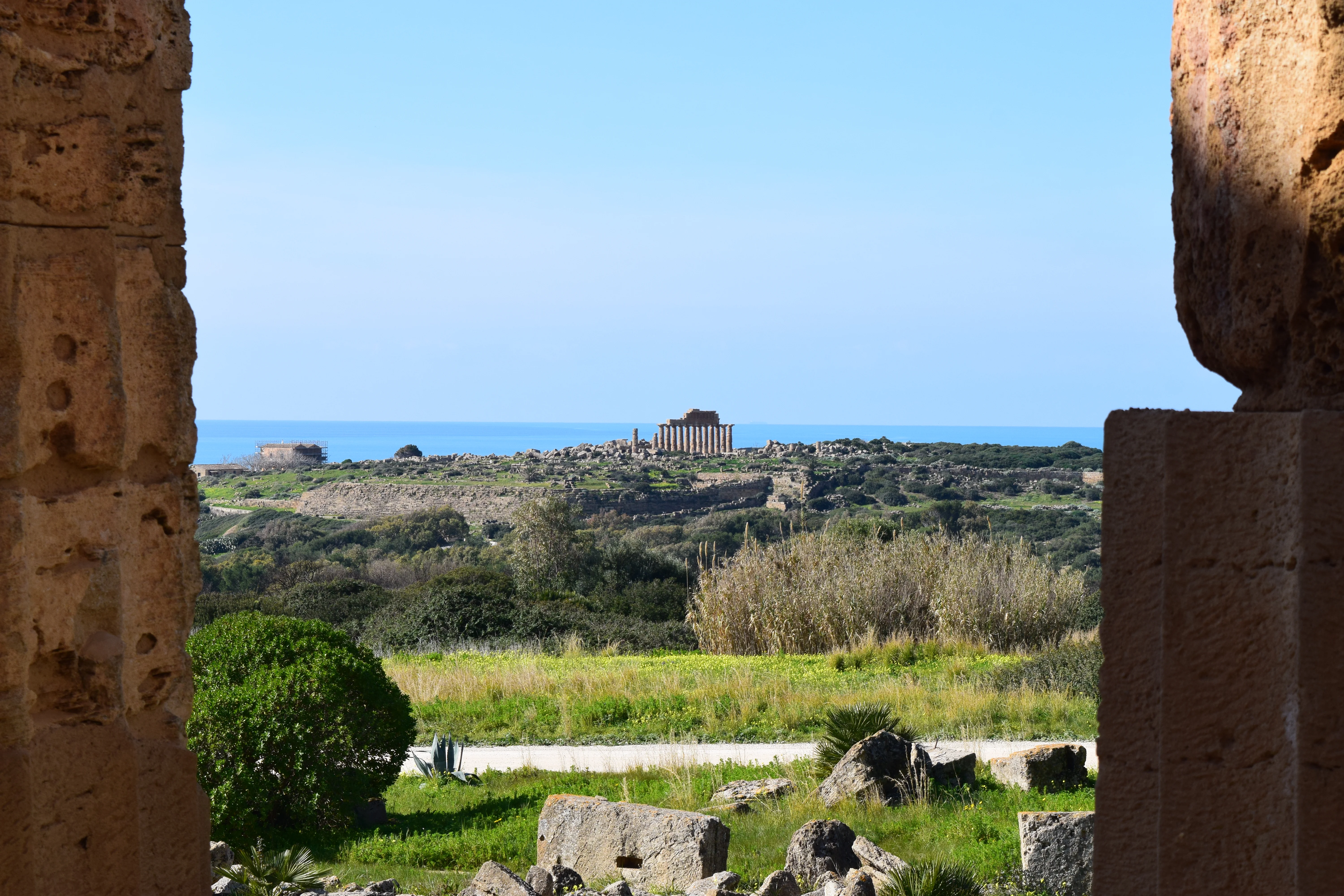
Take a Trip to Italy!
Join others who have purchased and read our book – leaving heartwarming reviews! Join our journey – we’d love to have you along for the ride!

The Temples
The seven temples were built on a limestone acropolis overlooking the sea and were built in the Greek Doric style. Of the seven original temples, only three are remaining and of the three temples, only one (Temple E) is somewhat restored. It is said to have been restored between 1925 – 1927. Temple C is also the oldest dating back to 560-550BC. At the peak of its popularity, the town had approximately 100,000 inhabitants.
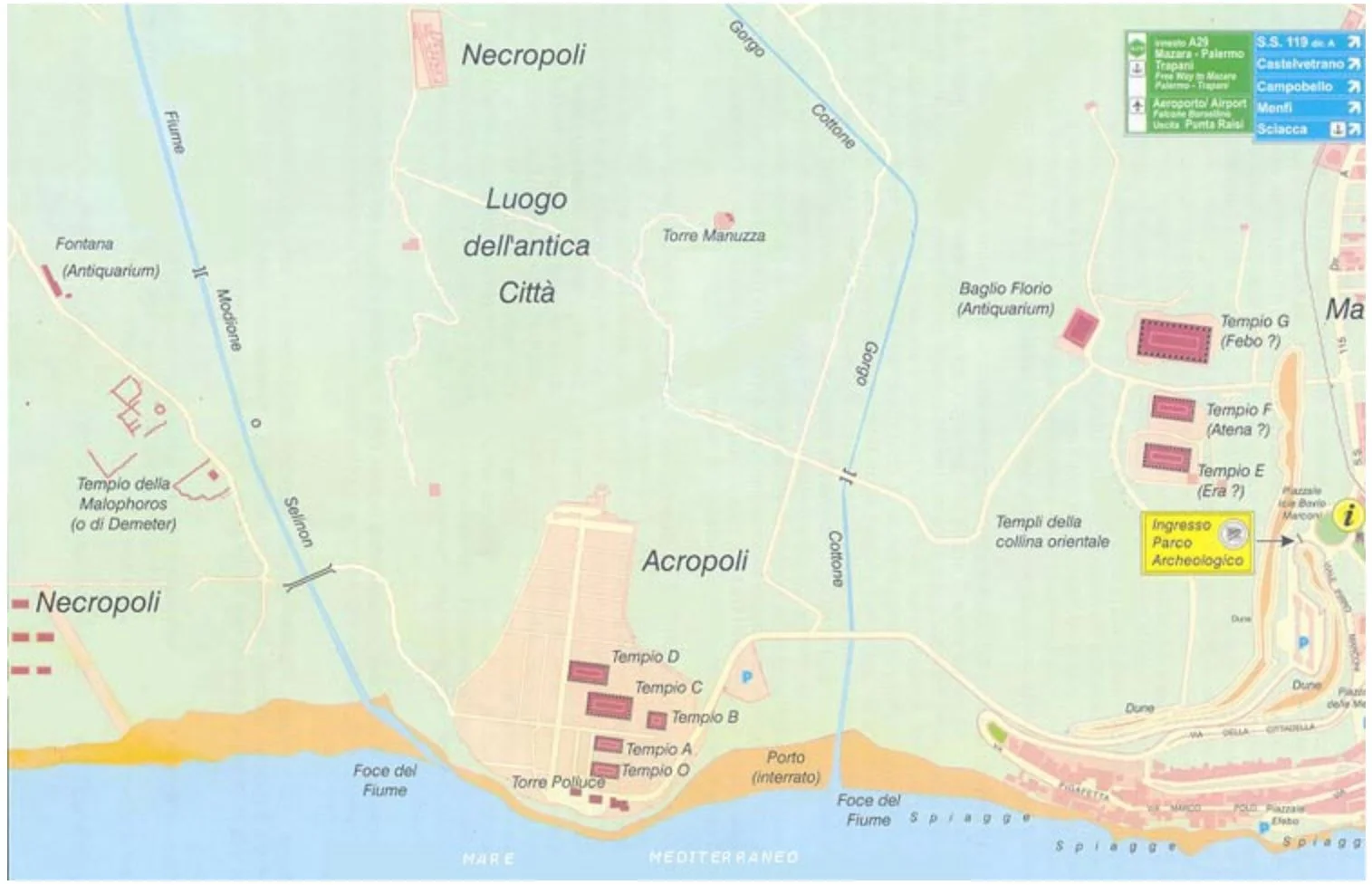
Each of the temples was dedicated to a God:
- Temples A & O were built around 490-460 BC. They were dedicated to Dioscuri and Poseidon
- Temple C was dedicated to Apollo
- Dedicated to Athena and built around 540 BC was Temple D
- Temple E because of an inscription found on a votive stela indicates that it was dedicated to Hera; however, some scholars argue that it must have been dedicated to Aphrodite on the basis of structural parallels. It was built 460-450 BC
- Temple F was probably dedicated to Dionysus or Athena and built 550-540 BC
- Dedicated to Zeus and built between 530-490 BC was Temple G
In addition, another temple site was recently discovered but not much is known about it yet. We found this great site that can show you more about each of the temples Selinunte Temples
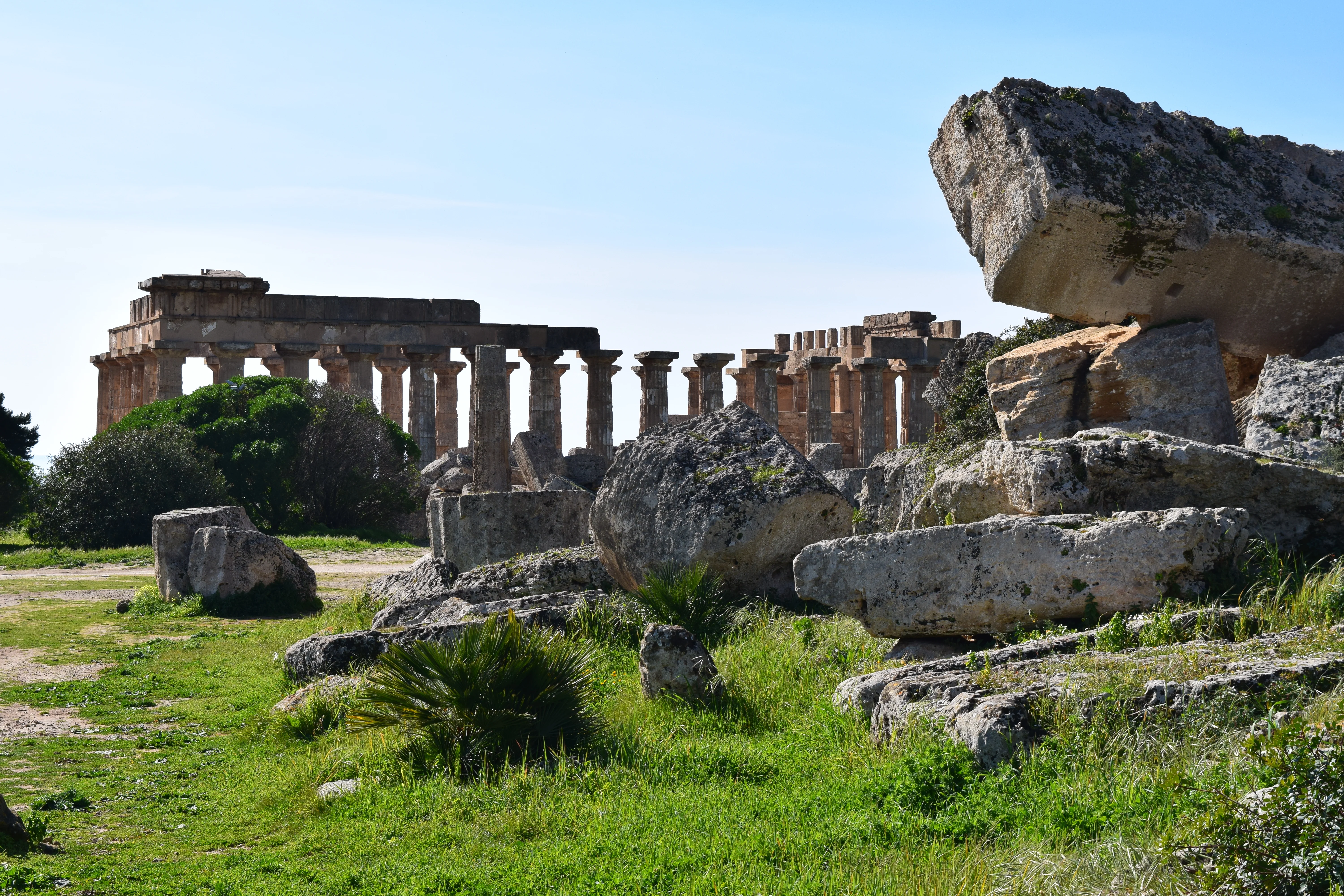
In Conclusion
Finally, Selinunte is one of those places that makes you imagine what life was like back then. While you stand in front of Temple E you might wonder, “How did an ancient civilization build these monuments without modern technology?”
If you are traveling past the town of Castelvetrano in southwestern Sicily, take the time to see Selinunte. It is easy to get to and definitely worth the visit!
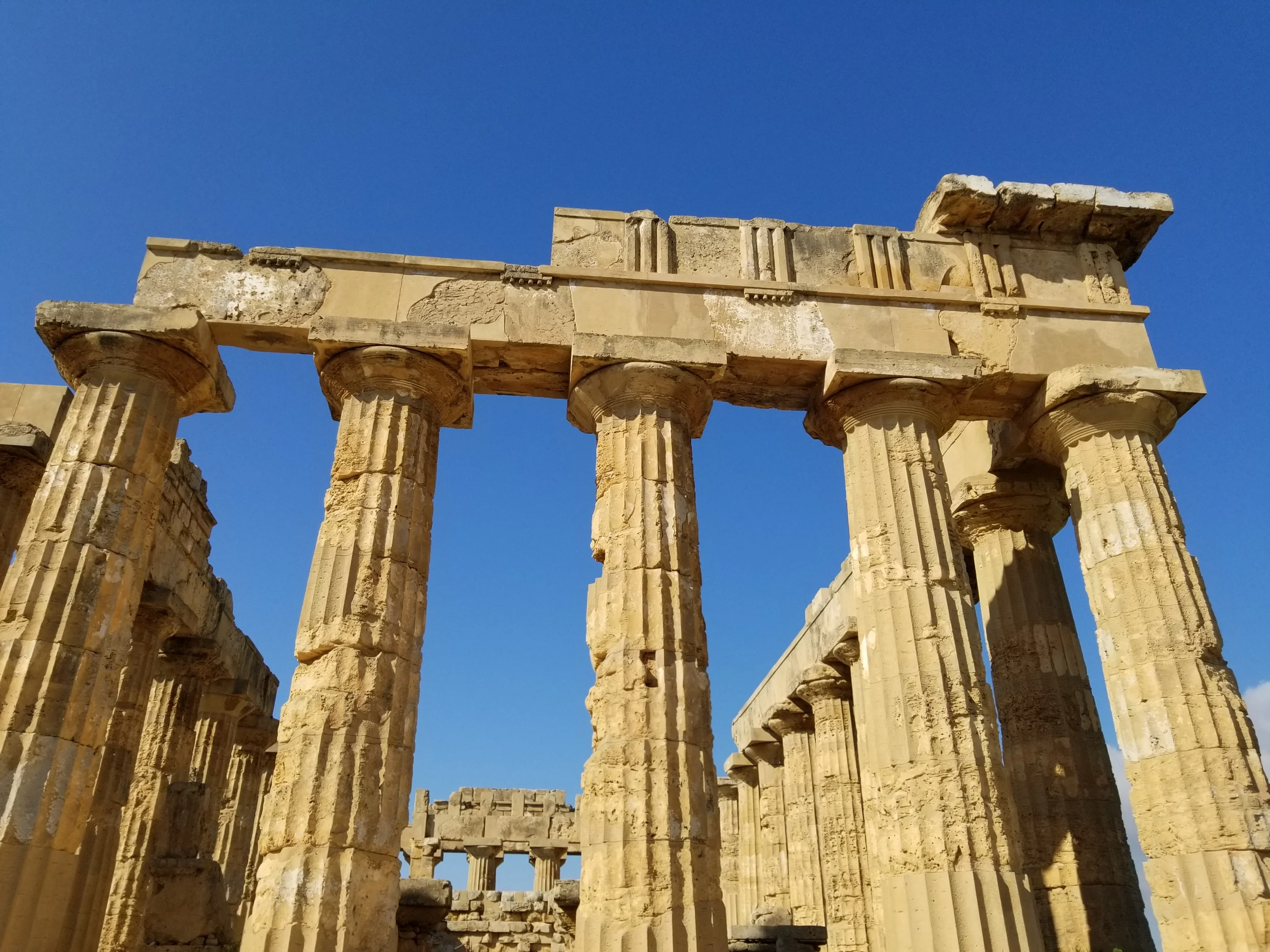
VISITING INFORMATION:
Selinunte archeological park, via selinute, castelvetrano, open from 9:00 am – 6:00 pm, ticket price: €6.00.

Leave A Comment Cancel reply
Your email address will not be published. Required fields are marked *
Save my name, email, and website in this browser for the next time I comment.
This site uses Akismet to reduce spam. Learn how your comment data is processed .

Beautiful Porticoes, Bologna
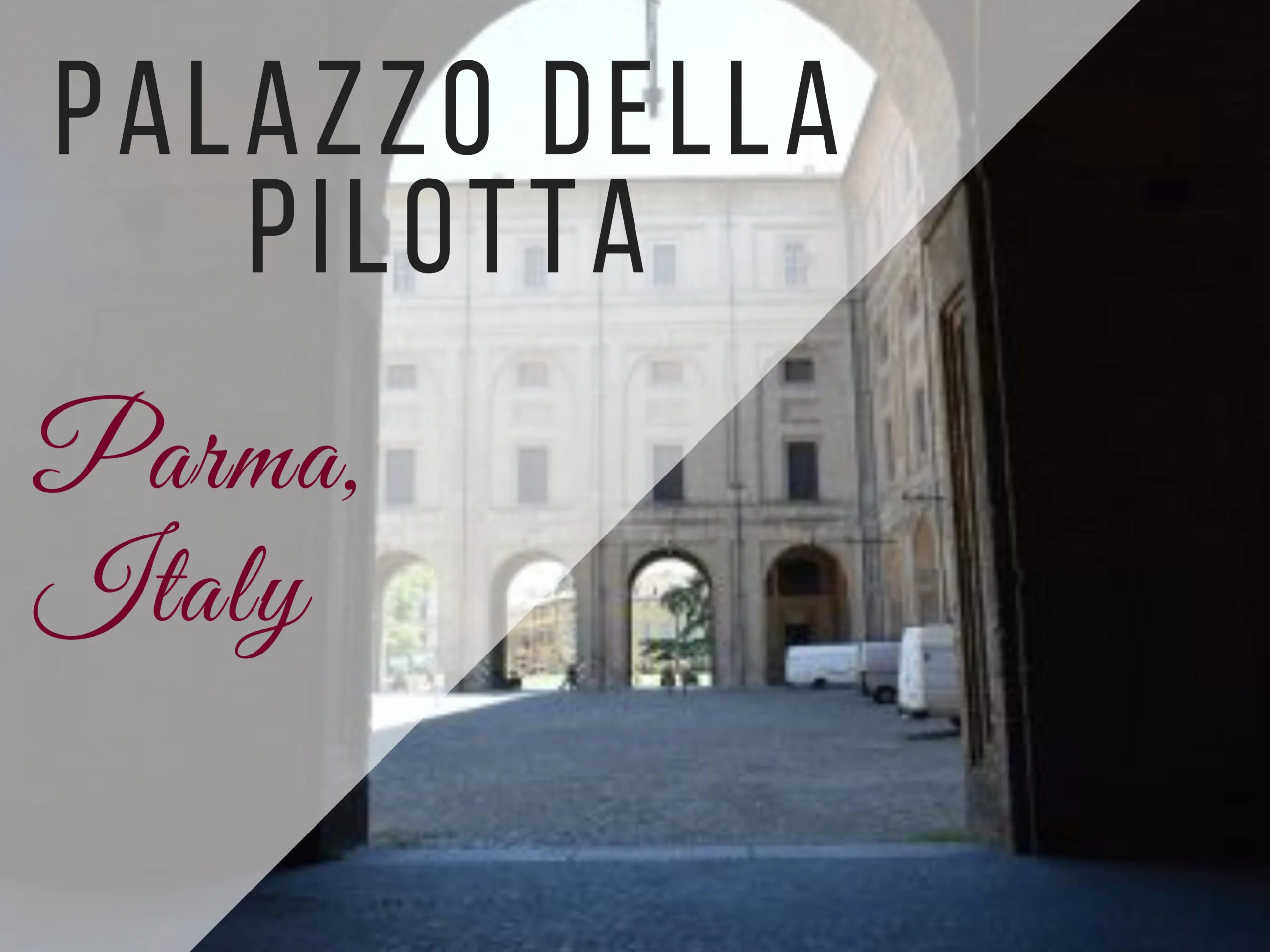
Palazzo Della Pilotta, Parma

Rent an Apartment in Italy: Important Facts

Relaunching the Beautiful Carmine, Lucca
The Selinunte site is located near the southwestern coast of Sicily in the province of Trapani. While Akragas (Agrigento) boasts more standing Greek temples in its “Valley of the Temples,” Selinunte is set in a much more tranquil setting overlooking the sea.
The city of Selinunte proper, known as the “acropolis,” is situated on high ground overlooking the Mediterranean about twenty meters below. The acropolis is located roughly in the center of the large archeological park.
Founded by Doric Greek colonists from Sicily’s Megara Hyblea between 650 and 630 BC, Selinus is mentioned by Diodorus Siculus and Thucydides, and while neither historian is noted for being especially accurate, most of their observations about Selinus appear to be correct.
Typical Dishes
Cous cous soup with fish; Busiate pasta in trapani style; Cassatelle patry stuffed with ricotta cheese and all the delicious dishes which are famous in Sicily.
Local Wines
Grtillo, Grecanico, Alcamo DOC, Insolia, Merlot, Syrah, Catarratto, Marsala wine, Nero d’Avola, Zibibbo, Passito, Moscato
Selinunte and the Archaeological Park
The largest archaeological area in europe ..
Mith, legend, history, culture: the Park of Selinunte it’s even more than this. A coffer of treasures far away millenia yet still alive, right here.
270 hectares that tell about one of the most flourishing classical civilizations of the Mediterranean area.
A rich story that claim still to be discovered, sought after by tourists as well as researchers and academics from all over the world.
Brief history.
From the foundation to the conflict with neighboring Segesta, the intervention of Hannibal until its final destruction: here 7 historical milestones that marked the birth, the rise and fall of one of West’s largest Greek colonies ever.
(by https://en.visitselinunte.com/ )
BIRTH OF SELINUNTE – #1

650-628 B.C.The colonists of Megara Hyblea (now Augusta), guided by the ecistas Pammilo, seek n
ew markets in western Sicily: they found the colony of Selinunte , as rich emporium. The name would stem from “Selinon”, which refers to the leaves of “apio”, a wild parsley that grows abundantly along the banks and in the valley of river Modione .

TWO CENTURIES OF PROSPERITY AND GROWTH – #2
628 – 420 B.C.Selinunte grows establishing itself as Apoikia and weaving political and commercial relationships with the Carthaginians, the Greeks, it builds the Acropolis , the Sanctuary of Malophoros , founds the sub-colony of Eraclea Minoa . It is the dawn of one of the most flourishing Greek colonies.
THE CONFLICT WITH SEGESTA – #3
413 B.C.The expansionist ambitions of Selinunte come to undermine the territory of Segesta. After several battles, ended without serious consequences, it came to a confrontation between mighty alliances : Segesta , supported by Carthage and Athens , and Selinunte , supported by Syracuse , Agrigento and Gela .

THE DECISIVE BATTLE AND THE DEFEAT OF SELINUNTE – #4
409 B.C.The battle marks the decisive victory of the Carthaginian Hannibal Magone , thanks to the non arrival of the auxiliary troops from Agrigento and Syracuse. Hannibal crushes and plunders Selinunte, saving only women and children. Thus this is the end of one of the West’s most glorious Greek colonies.
THE TREATY OF PEACE BETWEEN SYRACUSE AND CARTHAGE – #5
III CENT. B.C.Selinunte attempts a revival, relying on the alliance with Syracuse still on. The tyrant Dionysius becomes the protagonist of several attempts to storm the promontory of Lilybaeum (now Marsala territory) and drive the Carthaginians out, but the failure of the military campaign leads to a peace agreement , and Selinunte ended up in the hands of Carthage .

THE PUNIC AGE – #6
III CENT. B.C.Selinunte is rebuilt by the Carthaginians, but only in the area of the acropolis. They settle elements of Punic civilization, spread new cults, and the old city center of Manuzza becomes necropolis.
THE END OF SELINUNTE – #7
III-II CENT. A.C.During the First Punic War , Selinunte hopes in vain to break free from the yoke of Carthage with the help of the Romans . But the Carthaginians prefer to move their resources to Lilibeo, leaving Selinunte at the mercy of the Romans. Selinunte was never rebuilt and inhabited again. Thus this marks the end of one of the most glorious and important Greek colonies in Sicily.
Read More: https://en.visitselinunte.com/archaeological-park/

HOW TO VISIT SELINUNTE
Private transfer tour from agrigento to trapani: stopovers in selinunte and segesta.
- Transfer Tour
Private Transfer Tour from Agrigento to Trapani: stopovers in Selinunte, Mazara and Marsala
Selinunte archaeological park and belice nature reserve – 1 day.
- Not Included
- South West Side Sicily
Selinunte, CousCous, Marsala Wine and Saltpans


Posts about Sicily

Which island is more beautiful, Sardinia or Sicily?
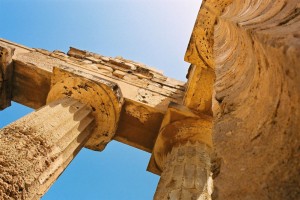
Selinunte is located in the Sicily southeast coast, in the province of Trapani. This is one of the main archaeological area in the Mediterranean region and it is the widest Greek structure. Selinunte is the name that Romans gave to the ancient Greek city Selinus. For its beauty this place can be compared to Syracuse or Segesta. Despite the outward status of decay, a guided tour will allow you to understand the great importance that this colony had in the past. The building of artificial hills on the perimeter tried to find the lost tranquility due to the construction of a road nearby.
History of Selinunte
According to the Athenian historian Thucydides, Selinunte was built by colonists from Megara Hyblaea (in the eastern coast of Sicily) in the seventh century b.C., about one hundred years after the Megara building. The name comes from a local plant, the parsley or sèlinon, widely diffused in the area. Afterwards, the population grew until 25.000 inhabitants and Selinunte turned into a powerful commercial centre in the Magna Graecia (Great Greece) and into one of the major Hellenistic cities. Its privileged geographical position near the sea allowed it to control the maritime traffic of the whole area, while agriculture and the breeding of horses strengthened its own economy.
Selinunte experienced a permanent conflict with Segesta – who was allied with Athens – whose expansion was not compatible with the Selinunte one. When Athenians were defeated by Syracuse, Segesta asked for help to Carthage. In 409 b.C. the city was besieged for nine days by an army of 100.000 Carthaginians landed in Sicily. According to the contemporary historians, this defeat caused to Selinunte a heavy toll in human lives with 16.000 victims and 5.000 prisoners forced into slavery. The temples were sacked and many building were partially destroyed.
Despite the city walls were also destroyed in order to prevent new forms of defence, Selinunte survivors were allowed to continue their own lives as usual, paying tribute to Carthage. About a thousand citizens settled in the city under the guidance of Ermocrate. In 405 b.C. the treaty between Carthage and Dionysius I of Syracuse confirmed Selinunte under the Carthaginian occupation, bringing an era of substantial peace, but the city never came back to its former glory. Indeed, during the First Punic War, it was destroyed again during the escape of the Carthaginians from the Romans.
After that, small communities of hermit monks lived in the ruins of the acropolis during the byzantine period, dropping a veil of oblivion on the past. Moreover, it was struck by some earthquakes that destroyed the foundations of the city, until the historian Fazello identified it again in the sixteenth century. In the nineteenth century other archaeological works unearthed the Selinunte remains.
Archaeological Site
The current archaeological structure is divided into four areas: the temples in the eastern area, the acropolis, the ancient city and the sanctuary of Malophòros. The temples are marked with letters, because of the impossibility of cataloguing accurately each god or goddess to which they were dedicated. The nearby Cusa quarries allowed analysing the whole process from the stone extracting up to their arrival to the temples. An excursion to the quarries – a full of orange groves and olive trees environment – give us the grandeur of the works of stone extracting, stopped with the destruction of Selinunte.
Despite it is probably that you get lost sometimes, it is worth to arrive to the Cusa quarries. They are located in the middle of Sicilian countryside, totally abandoned among olive trees, bushes, fig trees e almond trees. Fortunately, the sudden interruption because of the attacks of the Carthaginians in 409 b.C. gives you a perfect idea of how stone was extracted and transported from this kind of lab created for the building of Selinunte.
The quarries have blocks of stone that can be extracted, well-cut and ready for being transported to Selinunte (approximately 20 kilometres far) by slaves and oxen with the help of wooden rollers iron reinforced. It can be also found broken blocks scattered around the world, medium-size capitals and empty hollows, which make fantasy grow about a so magnificent extracting work. To reach the quarries, or at least try to do it, you have to drive for four kilometres from Selinunte towards north direction up to the intersection for Campobello di Mazara. After crossing the village take the detour for Tre Fontane, following the road for about two kilometres. Arriving there, you will find a rough road for about 200 meters that will oblige you to keep a 10 km/hours speed for avoiding damaging your car. The temples in the eastern area are those that best represent the importance of Selinunte. The temple G, dedicated to Zeus or Apollo, had a peristyle made of 46 columns of 16 meters high and 10,5 meters of circumference, which gave it the dimensions of about 110 x 50 meters. It is one of the major temples of the ancient times, even compared to the one of the Parthenon in Athens. Its construction was started in 580 b.C. and one hundred years later, when the city was destroyed, it was not already finished. Currently, a column restored in 1832 stands alone, so the visitors can sense the grandeur of the temple.
To the left of the path there are the temples E and F. The second one, dated 560 b.C., is the smallest and worst preserved, and it is dedicated to the goddess Athena. Besides, the temple E (in Doric style) is dated to the fifth century b.C. and an inscription tells us that it was dedicated to the goddess Era.
Its dimensions are 67 x 25 meters and it has six front columns and fourteen side columns. The temple, destroyed by an earthquake, was reconstructed in 1960 and built again, recovering the remains of basis scattered around the ground.
Then, walking the path towards the seaside you will see the acropolis in the sea, one of the best and unforgettable Sicilian sights. The acropolis lies on an irregular esplanade and in the past it was surrounded by walls and towers, which gave it a defensive function to contrast the incessant threat represented by Segesta. The remains of six temples well-defined and other minor temples and structures were arranged on a path make of two crossing streets. Then, in the Punic area there are the remains of another area devoted to sacrifices, in whose tiles you can see the symbol of the goddess Tanit.
The temples O and A are the closest temples to the sea and they were probably entitled to Castor and Pollux. These temples, dated about 409 b.C., were characterized by a Doric style and periptera hexastyle plant. Instead, the Megaron and the temple B have ionic and Doric-Friso columns. This seems to be dedicated to Empedocles, the philosopher from Agrigento who was superintendent of sewage work of Selinunte. In the acropolis esplanade there is the temple C, dated sixth century b.C., probably named after Apollo.
In 1936 it was involved in the same process of anastylosis of the temple E. It is in archaic Doric style and is characterized by 6 front columns and 17 side ones. You can see the preserved metopes and a large mask of Gorgon in the museum of Palermo. Going back to the north there is the temple D, similar to the previous one. Here there is the area of the acropolis where houses, the market and craft shops were located. Near the acropolis entrance recent excavations unveiled remains of what was used as necropolis after the destruction of Selinunte in 409 b.C.
Outside the acropolis in a western direction you have to cross the Modione river, where there was one of the Selinunte harbours, in order to visit the sanctuary of Malophoros (sixth century b.C.) dedicated to Demeter, the goddess of fertility. Two altars and a sacred spring formed it, which still continued to be used after the fall of the city.
Related Posts of Sicily:
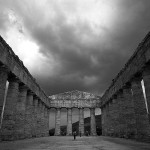
- Selous Game Reserve
- Masai Mara The Most Spectacular Show on Earth: Masai Mara
- On Safari: Chobe National Park
- Top 5 Los Angeles Art Museums

The Ruins of Selinunte
History facts.
Where: Selinute, Italian island of Sicily When: 650 – 250 BC History: Rich city destroyed by jealous neighbours Best sights: The Acropolis – ancient marketplace
Two hours south of Palermo lies a site which bears testament to Sicily’s importance in the ancient world – Selinunte. Overlooking the Mediterranean Sea and surrounded by lush green countryside, Selinunte is the site of some of the best preserved Greek ruins in all of Europe. It’s name is derived from the wild celery known as selinon which still grows in the area.
What’s the history here?
Selinunte was once a thriving Greek city set in spectacular surroundings on the Sicilian coast. In it’s heyday, it had a population of about 25,000 – these days all that remains are the ruins of the acropolis and a number of tumbledown temples.
The city was founded by Greek colonists from Megara Hyblea, on the east coast of Sicily, between 650 and 630 BC. It quickly became embroiled in territorial skirmishes with the neighbouring Elami and Entella, and built a harbour in order to protect its interests. After a treaty was reached in 580 BC, Selinunte turned her sea-faring capabilities to trade, and swiftly amassed riches which were the envy of other nations.
The Cartheginians were particularly concerned at Selinunte’s new found wealth, as they didn’t want to be ousted from their position of control over Sicily. Selinunte, for her part, attempted to remain neutral in subsequent conflicts between the Greek colonies. Ultimately, in 409 BC, Carthage used some minor skirmishes between Selinunte and the Elami as an excuse to attack the town. Selinunte was besieged for just nine days before the 100,000 strong army of Carthaginians breached the walls and embarked on a brutal frenzy of destruction.
Selinunte was inhabited by Carthaginians for the next 150 years, but it never regained its former prosperity. In 250 BC it was razed to the ground by Carthaginian forces who wanted to deprive Rome of her prize for capturing nearby Palermo.
In the early 8th century a small village grew up around the ruined city of Selinunte, but was destroyed by a serious earthquake about a hundred years later. The ruins have remained uninhabited from this time, and since no modern buildings have been constructed above the ruins the site is of supreme importance to archaeologists studying the Greek colonisation of Sicily.
What’s there to see and do?
Selinunte is a spectacular site, evocative of the power and wealth of the ancient Greek civilisation. The temples at Selinunte, five of which are clustered around the acropolis, are identified by the letters A to G, O & M. Most remarkable are:
Temple C – Many of the metopes from Temples C depicting scenes from Greek mythology are on display at the Archaeological Museum in Palermo. This temple is located within the acropolis.
Temple E – Reconstructed amid much controversy in 1958, Temple E was originally built in the 5th century BC. It is thought to have been dedicated to the Greek god Dionysus. The more outstanding metopes in the Archaeological Museum in Palermo come from this temple.
Temple G – One of the largest temples ever built by the Greeks, believed to have been dedicated to Apollo, the sun god. Sadly, little remains of this apart from one of the enormous columns and a huge pile of rubble.
The acropolis was built on high ground overlooking the sea. Some parts of the ancient walls surrounding it remain, but the most part was reconstructed in 1927. The agora or ‘marketplace’ and two main streets have been fully excavated.
MORE INFORMATION
Best of Sicily Sicily’s online destination guide, full of information on sights, cities, shopping, history and culture.
Italy Travel & Tourism Searchable site offering travel and tourism information for Italy.
Museo Archeologico Regionale Piazza Olivella 90100 Palermo Tel. +39.091.587825
Destination – Italy
- The Mosques of Istanbul
- Cities of La Ruta Maya
You May Also Like
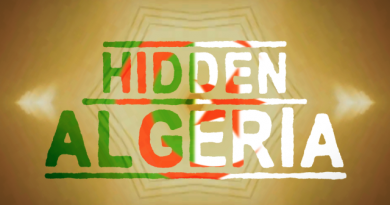
New Series: “Hidden Algeria”
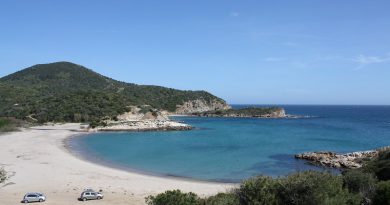
Italy’s Top 5 Most Beautiful Beaches
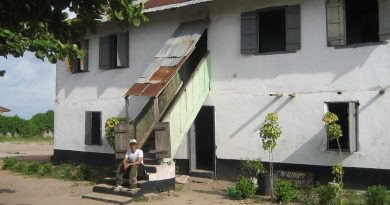
Badgary: Nigeria’s Slave Port
- Art and Culture
- Chiese e Monasteri
- Mercatini e Mercati Storici
- Historical Building
- Archaeological Parks
- Parchi e Riserve
- Piazze e Vie Storiche

- Caltanissetta
- Giardini Naxos
- Isola Bella
- Camper park area
- Divertimenti
- Historic Squares and Streets
- Parks and Reserves
- Tours/Experiences
- Eat and drink
- Bed & Breakfast
- Wine Tourism

Selinunte stands on a small plain 30 metres above sea level and takes its name from Selinon, the wild parsley that grows luxuriantly on the banks of the river Modione.
It was founded by colonists from Megara Hyblaea led by the ecist Pammilos, between 650 and 628 BC, when they moved to treat Selinunte as an emporium.
Over the next two centuries, between 628 and 420 B.C., the settlement attempted to found its own colonies, such as Heraclea Minoa, and formed an alliance with the Carthaginians. The Acropolis and the Sanctuary of Malophoros were built and a truly prosperous time began.
Throughout this time, relations with Segesta remained tense, until the clash in which Segesta was supported by Carthage and Athens, while Selinunte was supported by Syracuse , Agrigento and Gela. It is 412 BC. Segesta prevails and Selinunte thanks to the exploits of Hannibal Mago and the absence of support from Agrigento and Syracuse.
Selinunte, however, does not give up and attempts a comeback by trying to conquer Lilybaeum, the promontory of Marsala. It failed in this endeavour too, and decided to sign a peace agreement according to which it was destined to fall into the hands of the Carthaginians.
In the 3rd century BC, the reconstruction of Selinunte began in the area of the Acropolis and the Necropolis became the Manuzza area.
Over the next hundred years, during the First Punic War, Selinunte truly believed it could free itself from the Carthaginians, but during the battle it was completely destroyed and the Romans felt no interest in its reconstruction. Thus ended the life of one of the most important colonies of Magna Graecia.
Rate us and Write a Review
Cleanliness
Your review is recommended to be at least 140 characters long
- --> Selinunte, TP, Italia
September, 2024
August 26,2019
- 9:00am - 10:00am
- Selenia Torrisi
Awesome Job!
We have received your appointment and will send you a confirmation to your provided email upon approval.

IMAGES
VIDEO
COMMENTS
Multi-day Italy Trips and Excursions. Book a Tour on Viator Today! Full Refund Available up to 24 Hours Before Your Tour Date, Quick & Easy Purchase Process
Read reviews and view photos. Book the perfect Parco Archeologico Selinunte tour! Full Refund Available up to 24 Hours Before Your Tour Date. Quick & Easy Purchase Process
This is Selinunte! In ancient times, rich and populous, today it's included in the largest archaeological park in Europe (take a look at our tour) that covers 270 hectares, with the acropolis, the necropolis and the three hills. The temples included in this vast area are among the most significant examples of Doric architecture, marked by ...
The Selinunte Archaeological Park can be accessed for just €6 per person and is best visited with a rental car; there's a large car park on-site. It will take around an hour from Trapani and an hour and a half from Palermo. From Selinunte, you can reach Agrigento in just over an hour too. If you're relying on public transport, the best ...
As you enter the Selinunte archaeological site you first reach a small hill with three temples. This hill sits outside of the Greek town and would have been a sacred site. On this hill you can see the temples E, F and G. Temple E was probably dedicated to Hera and is the most recent at 460-450 BC. It is the most intact temple at Selinunte (and ...
Experience an unmissable excursion from Segesta to Selinunte, passing through the Cave di Cusa, to admire unique views, visit ancient temples and explore some of Sicily's most beautiful archaeological sites.. When we arrive at Segesta, the first thing we notice is the temple on the plateau between the two peaks of the mountain where the ancient city stood in the 5th and 4th centuries BC.
No visit to Sicily would be complete without a visit to Selinunte Archaeological Park. This park is one of the largest Greek colonies and the largest archaeological area in all of Europe. Just like much of Sicily, this once thriving city changed hands several times over the centuries. It represents the Sicilian experience in many ways.
Near Selinunte you can also visit the archaeological park of Segesta. In Sicily you also have many other truly spectacular archaeological sites such as the Valle dei Tempi in Agrigento and the Roman Villa del Casale in Piazza Armerina. Look at all the archaeological parks in Sicily reviewed on the platform.
The archaeological site of Selinunte is as impressive as the Valley of the Temples in Agrigento, but way less busy. On the southwest coast of Sicily, in the province of Trapani, lies Selinunte, one of the largest and most important archaeological sites in the Mediterranean.A day spent strolling around the Greek archaeological site of Selinunte, between Sciacca and Marsala, is a must on any ...
Visit Selinunte. Selinunte is situated on the southern coast of western Sicily, south-east of Mazaro-de-Vallo. More than 2500 years ago Selinus (as Selinunte was then known) was one of the most important cities in Ancient Greece. This role continued until 409 BC when Hannibal and the carthaginians arrived and pretty much destroyed the entire city.
Recent visitors said the site does require a lot of walking on uneven ground, and they recommended hiring a guide to fully explain the history of the area. The park located in the town of ...
Selinunte lies in the comune (council district) of Castelvetrano, an important transport hub if you are relying on trains and buses. Castelvetrano is a busy and typical Sicilian town, which most travellers will only glimpse on the way to Selinunte (read on for travel details). It has some historical buildings and a lively main street lined with ...
Selinunte is a piece of ancient Greece in the heart of western Sicily.Selinunte is located in the municipality of Castelvetrano, a small town in the province of Trapani that offers its visitors not only white beaches and crystal-clear waters, but also many places to see important traces of the past up close.The most famous is surely the great archaeological park of Selinunte, Cave di Cusa and ...
Selinunte, Sicily: Temple E. The columne were re-erected in 1958. The temple was built 490-480 BC. Four of the metopes can be seen in Palermo's archeological museum. Some 70 years later it is estimated that the city had 30.000 inhabitants. The archaeological site contains five temples centered on an acropolis. Of the five temples, only the ...
The Best of Sicily Tour - 12 days. Agrigento, Cefalù, Cyclops Riviera, Erice, Etna, Marsala, Mazara del Vallo, Modica, Monreale, Palermo, Piazza Armerina, Ragusa, Selinunte, Siracusa, Taormina. The Best of Sicily Tour, an amazing way to explore the most important local highlights combined with meal experiences. 12 Days.
We can visit the Grotta Mangiapane (or "Uffizi's Grotto"), which is 70 meters high, 13 meters wide and 50 meters deep. We are now ready to visit the Selinunte, Cusa Caves and Pantelleria Archaeological sites. Let's start from the Selinunte Archaeological area. It is 270 hectares wide and is one of the largest Mediterranean sites.
Selinunte is an ancient Greek archaeological site situated on the southwestern coast of Sicily, Italy. Named after the wild celery that once adorned its landscape, Selinunte was one of the most important of the Greek colonies in Sicily. Today, it's a place where history tangibly intersects with the rugged Mediterranean landscape, offering ...
Selinunte stands on a small plain 30 metres above sea level and takes its name from Selinon, the wild parsley that grows luxuriantly on the banks of the river Modione. It was founded by colonists from Megara Hyblaea led by the ecist Pammilos, between 650 and 628 BC, when they moved to treat Selinunte as an emporium. Over the next two centuries ...
Plan your Visit to Selinunte with free Selinunte itineraries, guides, things to do and maps. Create your personal guide to Selinunte with full information on all top attractions ... Selinunte is an archaeological complex on the southwestern coast of Sicily. It was once one of several ancient Greek colonies of which several structures have ...
Most noteworthy, Selinunte is the largest archaeological park in Europe and covers about 670 acres and 2,500 years of history. There is one temple off in the distance by the ocean but you have pay for a little train tour (about €6). Because we were only planning on a quick visit, we decided against the tour.
The city of Selinunte proper, known as the "acropolis," is situated on high ground overlooking the Mediterranean about twenty meters below. The acropolis is located roughly in the center of the large archeological park. Founded by Doric Greek colonists from Sicily's Megara Hyblea between 650 and 630 BC, Selinus is mentioned by Diodorus ...
The construction period is quite vague, between 530 and 409 BC. The dimensions possess a length of 113.34 m, a width of 54.05 m and a height of 30 m. It represents the largest in the Archaeological Park, as well as one of the largest in the entire Greek world. Left unfinished, however, only ruins remain to us today.
If you want to discover the history of Sicily, and really feel it, you just can't miss a visit to the stunning Selinunte.Its name comes from the ancient greek selinous, the celery, which was the representative crest of the city and still grows wild in its woods today.The city has been built by the sea, by the Megarese pioneers in the seventh century BC, right where the valleys of Belice and ...
When Athenians were defeated by Syracuse, Segesta asked for help to Carthage. In 409 b.C. the city was besieged for nine days by an army of 100.000 Carthaginians landed in Sicily. According to the contemporary historians, this defeat caused to Selinunte a heavy toll in human lives with 16.000 victims and 5.000 prisoners forced into slavery.
Where: Selinute, Italian island of Sicily When: 650 - 250 BC History: Rich city destroyed by jealous neighbours Best sights: The Acropolis - ancient marketplace. Two hours south of Palermo lies a site which bears testament to Sicily's importance in the ancient world - Selinunte.
Selinunte stands on a small plain 30 metres above sea level and takes its name from Selinon, the wild parsley that grows luxuriantly on the banks of the river Modione. It was founded by colonists from Megara Hyblaea led by the ecist Pammilos, ... Visit Sicily. Contributors;